425: Filing under Securities Act Rule 425 of certain prospectuses and communications in connection with business combination transactions
Published on September 27, 2021
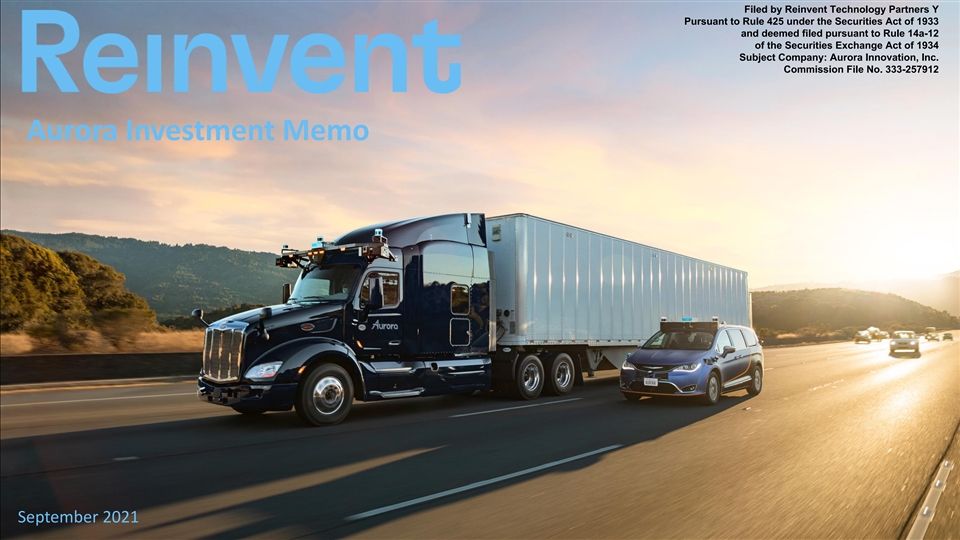
Filed by Reinvent Technology Partners Y Pursuant to Rule 425 under the Securities Act of 1933 and deemed filed pursuant to Rule 14a-12 of the Securities Exchange Act of 1934 Subject Company: Aurora Innovation, Inc. Commission File No. 333-257912 Aurora Investment Memo September 2021Filed by Reinvent Technology Partners Y Pursuant to Rule 425 under the Securities Act of 1933 and deemed filed pursuant to Rule 14a-12 of the Securities Exchange Act of 1934 Subject Company: Aurora Innovation, Inc. Commission File No. 333-257912 Aurora Investment Memo September 2021
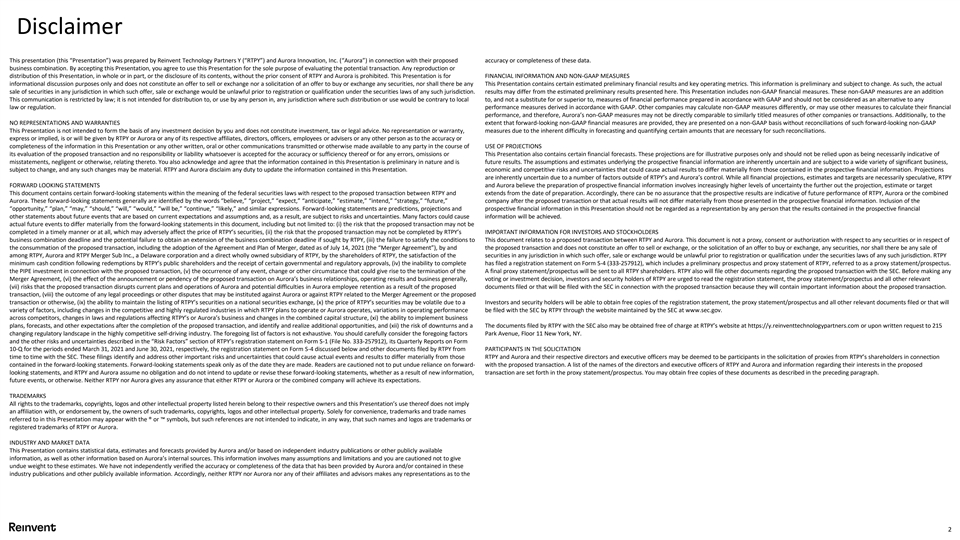
Disclaimer This presentation (this “Presentation”) was prepared by Reinvent Technology Partners Y (“RTPY”) and Aurora Innovation, Inc. (“Aurora”) in connection with their proposed accuracy or completeness of these data. business combination. By accepting this Presentation, you agree to use this Presentation for the sole purpose of evaluating the potential transaction. Any reproduction or distribution of this Presentation, in whole or in part, or the disclosure of its contents, without the prior consent of RTPY and Aurora is prohibited. This Presentation is for FINANCIAL INFORMATION AND NON-GAAP MEASURES informational discussion purposes only and does not constitute an offer to sell or exchange nor a solicitation of an offer to buy or exchange any securities, nor shall there be any This Presentation contains certain estimated preliminary financial results and key operating metrics. This information is preliminary and subject to change. As such, the actual sale of securities in any jurisdiction in which such offer, sale or exchange would be unlawful prior to registration or qualification under the securities laws of any such jurisdiction. results may differ from the estimated preliminary results presented here. This Presentation includes non-GAAP financial measures. These non-GAAP measures are an addition This communication is restricted by law; it is not intended for distribution to, or use by any person in, any jurisdiction where such distribution or use would be contrary to local to, and not a substitute for or superior to, measures of financial performance prepared in accordance with GAAP and should not be considered as an alternative to any law or regulation. performance measures derived in accordance with GAAP. Other companies may calculate non-GAAP measures differently, or may use other measures to calculate their financial performance, and therefore, Aurora’s non-GAAP measures may not be directly comparable to similarly titled measures of other companies or transactions. Additionally, to the NO REPRESENTATIONS AND WARRANTIES extent that forward-looking non-GAAP financial measures are provided, they are presented on a non-GAAP basis without reconciliations of such forward-looking non-GAAP This Presentation is not intended to form the basis of any investment decision by you and does not constitute investment, tax or legal advice. No representation or warranty, measures due to the inherent difficulty in forecasting and quantifying certain amounts that are necessary for such reconciliations. express or implied, is or will be given by RTPY or Aurora or any of its respective affiliates, directors, officers, employees or advisers or any other person as to the accuracy or completeness of the information in this Presentation or any other written, oral or other communications transmitted or otherwise made available to any party in the course of USE OF PROJECTIONS its evaluation of the proposed transaction and no responsibility or liability whatsoever is accepted for the accuracy or sufficiency thereof or for any errors, omissions or This Presentation also contains certain financial forecasts. These projections are for illustrative purposes only and should not be relied upon as being necessarily indicative of misstatements, negligent or otherwise, relating thereto. You also acknowledge and agree that the information contained in this Presentation is preliminary in nature and is future results. The assumptions and estimates underlying the prospective financial information are inherently uncertain and are subject to a wide variety of significant business, subject to change, and any such changes may be material. RTPY and Aurora disclaim any duty to update the information contained in this Presentation. economic and competitive risks and uncertainties that could cause actual results to differ materially from those contained in the prospective financial information. Projections are inherently uncertain due to a number of factors outside of RTPY’s and Aurora’s control. While all financial projections, estimates and targets are necessarily speculative, RTPY FORWARD LOOKING STATEMENTS and Aurora believe the preparation of prospective financial information involves increasingly higher levels of uncertainty the further out the projection, estimate or target This document contains certain forward-looking statements within the meaning of the federal securities laws with respect to the proposed transaction between RTPY and extends from the date of preparation. Accordingly, there can be no assurance that the prospective results are indicative of future performance of RTPY, Aurora or the combined Aurora. These forward-looking statements generally are identified by the words “believe,” “project,” “expect,” “anticipate,” “estimate,” “intend,” “strategy,” “future,” company after the proposed transaction or that actual results will not differ materially from those presented in the prospective financial information. Inclusion of the “opportunity,” “plan,” “may,” “should,” “will,” “would,” “will be,” “continue,” “likely,” and similar expressions. Forward-looking statements are predictions, projections and prospective financial information in this Presentation should not be regarded as a representation by any person that the results contained in the prospective financial other statements about future events that are based on current expectations and assumptions and, as a result, are subject to risks and uncertainties. Many factors could cause information will be achieved. actual future events to differ materially from the forward-looking statements in this document, including but not limited to: (i) the risk that the proposed transaction may not be completed in a timely manner or at all, which may adversely affect the price of RTPY’s securities, (ii) the risk that the proposed transaction may not be completed by RTPY’s IMPORTANT INFORMATION FOR INVESTORS AND STOCKHOLDERS business combination deadline and the potential failure to obtain an extension of the business combination deadline if sought by RTPY, (iii) the failure to satisfy the conditions to This document relates to a proposed transaction between RTPY and Aurora. This document is not a proxy, consent or authorization with respect to any securities or in respect of the consummation of the proposed transaction, including the adoption of the Agreement and Plan of Merger, dated as of July 14, 2021 (the “Merger Agreement”), by and the proposed transaction and does not constitute an offer to sell or exchange, or the solicitation of an offer to buy or exchange, any securities, nor shall there be any sale of among RTPY, Aurora and RTPY Merger Sub Inc., a Delaware corporation and a direct wholly owned subsidiary of RTPY, by the shareholders of RTPY, the satisfaction of the securities in any jurisdiction in which such offer, sale or exchange would be unlawful prior to registration or qualification under the securities laws of any such jurisdiction. RTPY minimum cash condition following redemptions by RTPY’s public shareholders and the receipt of certain governmental and regulatory approvals, (iv) the inability to complete has filed a registration statement on Form S-4 (333-257912), which includes a preliminary prospectus and proxy statement of RTPY, referred to as a proxy statement/prospectus. the PIPE investment in connection with the proposed transaction, (v) the occurrence of any event, change or other circumstance that could give rise to the termination of the A final proxy statement/prospectus will be sent to all RTPY shareholders. RTPY also will file other documents regarding the proposed transaction with the SEC. Before making any Merger Agreement, (vi) the effect of the announcement or pendency of the proposed transaction on Aurora’s business relationships, operating results and business generally, voting or investment decision, investors and security holders of RTPY are urged to read the registration statement, the proxy statement/prospectus and all other relevant (vii) risks that the proposed transaction disrupts current plans and operations of Aurora and potential difficulties in Aurora employee retention as a result of the proposed documents filed or that will be filed with the SEC in connection with the proposed transaction because they will contain important information about the proposed transaction. transaction, (viii) the outcome of any legal proceedings or other disputes that may be instituted against Aurora or against RTPY related to the Merger Agreement or the proposed transaction or otherwise, (ix) the ability to maintain the listing of RTPY’s securities on a national securities exchange, (x) the price of RTPY’s securities may be volatile due to a Investors and security holders will be able to obtain free copies of the registration statement, the proxy statement/prospectus and all other relevant documents filed or that will variety of factors, including changes in the competitive and highly regulated industries in which RTPY plans to operate or Aurora operates, variations in operating performance be filed with the SEC by RTPY through the website maintained by the SEC at www.sec.gov. across competitors, changes in laws and regulations affecting RTPY’s or Aurora’s business and changes in the combined capital structure, (xi) the ability to implement business plans, forecasts, and other expectations after the completion of the proposed transaction, and identify and realize additional opportunities, and (xii) the risk of downturns and a The documents filed by RTPY with the SEC also may be obtained free of charge at RTPY’s website at https://y.reinventtechnologypartners.com or upon written request to 215 changing regulatory landscape in the highly competitive self-driving industry. The foregoing list of factors is not exhaustive. You should carefully consider the foregoing factors Park Avenue, Floor 11 New York, NY. and the other risks and uncertainties described in the “Risk Factors” section of RTPY’s registration statement on Form S-1 (File No. 333-257912), its Quarterly Reports on Form 10-Q for the periods ended March 31, 2021 and June 30, 2021, respectively, the registration statement on Form S-4 discussed below and other documents filed by RTPY from PARTICIPANTS IN THE SOLICITATION time to time with the SEC. These filings identify and address other important risks and uncertainties that could cause actual events and results to differ materially from those RTPY and Aurora and their respective directors and executive officers may be deemed to be participants in the solicitation of proxies from RTPY’s shareholders in connection contained in the forward-looking statements. Forward-looking statements speak only as of the date they are made. Readers are cautioned not to put undue reliance on forward- with the proposed transaction. A list of the names of the directors and executive officers of RTPY and Aurora and information regarding their interests in the proposed looking statements, and RTPY and Aurora assume no obligation and do not intend to update or revise these forward-looking statements, whether as a result of new information, transaction are set forth in the proxy statement/prospectus. You may obtain free copies of these documents as described in the preceding paragraph. future events, or otherwise. Neither RTPY nor Aurora gives any assurance that either RTPY or Aurora or the combined company will achieve its expectations. TRADEMARKS All rights to the trademarks, copyrights, logos and other intellectual property listed herein belong to their respective owners and this Presentation’s use thereof does not imply an affiliation with, or endorsement by, the owners of such trademarks, copyrights, logos and other intellectual property. Solely for convenience, trademarks and trade names referred to in this Presentation may appear with the ® or ™ symbols, but such references are not intended to indicate, in any way, that such names and logos are trademarks or registered trademarks of RTPY or Aurora. INDUSTRY AND MARKET DATA This Presentation contains statistical data, estimates and forecasts provided by Aurora and/or based on independent industry publications or other publicly available information, as well as other information based on Aurora’s internal sources. This information involves many assumptions and limitations and you are cautioned not to give undue weight to these estimates. We have not independently verified the accuracy or completeness of the data that has been provided by Aurora and/or contained in these industry publications and other publicly available information. Accordingly, neither RTPY nor Aurora nor any of their affiliates and advisors makes any representations as to the 2Disclaimer This presentation (this “Presentation”) was prepared by Reinvent Technology Partners Y (“RTPY”) and Aurora Innovation, Inc. (“Aurora”) in connection with their proposed accuracy or completeness of these data. business combination. By accepting this Presentation, you agree to use this Presentation for the sole purpose of evaluating the potential transaction. Any reproduction or distribution of this Presentation, in whole or in part, or the disclosure of its contents, without the prior consent of RTPY and Aurora is prohibited. This Presentation is for FINANCIAL INFORMATION AND NON-GAAP MEASURES informational discussion purposes only and does not constitute an offer to sell or exchange nor a solicitation of an offer to buy or exchange any securities, nor shall there be any This Presentation contains certain estimated preliminary financial results and key operating metrics. This information is preliminary and subject to change. As such, the actual sale of securities in any jurisdiction in which such offer, sale or exchange would be unlawful prior to registration or qualification under the securities laws of any such jurisdiction. results may differ from the estimated preliminary results presented here. This Presentation includes non-GAAP financial measures. These non-GAAP measures are an addition This communication is restricted by law; it is not intended for distribution to, or use by any person in, any jurisdiction where such distribution or use would be contrary to local to, and not a substitute for or superior to, measures of financial performance prepared in accordance with GAAP and should not be considered as an alternative to any law or regulation. performance measures derived in accordance with GAAP. Other companies may calculate non-GAAP measures differently, or may use other measures to calculate their financial performance, and therefore, Aurora’s non-GAAP measures may not be directly comparable to similarly titled measures of other companies or transactions. Additionally, to the NO REPRESENTATIONS AND WARRANTIES extent that forward-looking non-GAAP financial measures are provided, they are presented on a non-GAAP basis without reconciliations of such forward-looking non-GAAP This Presentation is not intended to form the basis of any investment decision by you and does not constitute investment, tax or legal advice. No representation or warranty, measures due to the inherent difficulty in forecasting and quantifying certain amounts that are necessary for such reconciliations. express or implied, is or will be given by RTPY or Aurora or any of its respective affiliates, directors, officers, employees or advisers or any other person as to the accuracy or completeness of the information in this Presentation or any other written, oral or other communications transmitted or otherwise made available to any party in the course of USE OF PROJECTIONS its evaluation of the proposed transaction and no responsibility or liability whatsoever is accepted for the accuracy or sufficiency thereof or for any errors, omissions or This Presentation also contains certain financial forecasts. These projections are for illustrative purposes only and should not be relied upon as being necessarily indicative of misstatements, negligent or otherwise, relating thereto. You also acknowledge and agree that the information contained in this Presentation is preliminary in nature and is future results. The assumptions and estimates underlying the prospective financial information are inherently uncertain and are subject to a wide variety of significant business, subject to change, and any such changes may be material. RTPY and Aurora disclaim any duty to update the information contained in this Presentation. economic and competitive risks and uncertainties that could cause actual results to differ materially from those contained in the prospective financial information. Projections are inherently uncertain due to a number of factors outside of RTPY’s and Aurora’s control. While all financial projections, estimates and targets are necessarily speculative, RTPY FORWARD LOOKING STATEMENTS and Aurora believe the preparation of prospective financial information involves increasingly higher levels of uncertainty the further out the projection, estimate or target This document contains certain forward-looking statements within the meaning of the federal securities laws with respect to the proposed transaction between RTPY and extends from the date of preparation. Accordingly, there can be no assurance that the prospective results are indicative of future performance of RTPY, Aurora or the combined Aurora. These forward-looking statements generally are identified by the words “believe,” “project,” “expect,” “anticipate,” “estimate,” “intend,” “strategy,” “future,” company after the proposed transaction or that actual results will not differ materially from those presented in the prospective financial information. Inclusion of the “opportunity,” “plan,” “may,” “should,” “will,” “would,” “will be,” “continue,” “likely,” and similar expressions. Forward-looking statements are predictions, projections and prospective financial information in this Presentation should not be regarded as a representation by any person that the results contained in the prospective financial other statements about future events that are based on current expectations and assumptions and, as a result, are subject to risks and uncertainties. Many factors could cause information will be achieved. actual future events to differ materially from the forward-looking statements in this document, including but not limited to: (i) the risk that the proposed transaction may not be completed in a timely manner or at all, which may adversely affect the price of RTPY’s securities, (ii) the risk that the proposed transaction may not be completed by RTPY’s IMPORTANT INFORMATION FOR INVESTORS AND STOCKHOLDERS business combination deadline and the potential failure to obtain an extension of the business combination deadline if sought by RTPY, (iii) the failure to satisfy the conditions to This document relates to a proposed transaction between RTPY and Aurora. This document is not a proxy, consent or authorization with respect to any securities or in respect of the consummation of the proposed transaction, including the adoption of the Agreement and Plan of Merger, dated as of July 14, 2021 (the “Merger Agreement”), by and the proposed transaction and does not constitute an offer to sell or exchange, or the solicitation of an offer to buy or exchange, any securities, nor shall there be any sale of among RTPY, Aurora and RTPY Merger Sub Inc., a Delaware corporation and a direct wholly owned subsidiary of RTPY, by the shareholders of RTPY, the satisfaction of the securities in any jurisdiction in which such offer, sale or exchange would be unlawful prior to registration or qualification under the securities laws of any such jurisdiction. RTPY minimum cash condition following redemptions by RTPY’s public shareholders and the receipt of certain governmental and regulatory approvals, (iv) the inability to complete has filed a registration statement on Form S-4 (333-257912), which includes a preliminary prospectus and proxy statement of RTPY, referred to as a proxy statement/prospectus. the PIPE investment in connection with the proposed transaction, (v) the occurrence of any event, change or other circumstance that could give rise to the termination of the A final proxy statement/prospectus will be sent to all RTPY shareholders. RTPY also will file other documents regarding the proposed transaction with the SEC. Before making any Merger Agreement, (vi) the effect of the announcement or pendency of the proposed transaction on Aurora’s business relationships, operating results and business generally, voting or investment decision, investors and security holders of RTPY are urged to read the registration statement, the proxy statement/prospectus and all other relevant (vii) risks that the proposed transaction disrupts current plans and operations of Aurora and potential difficulties in Aurora employee retention as a result of the proposed documents filed or that will be filed with the SEC in connection with the proposed transaction because they will contain important information about the proposed transaction. transaction, (viii) the outcome of any legal proceedings or other disputes that may be instituted against Aurora or against RTPY related to the Merger Agreement or the proposed transaction or otherwise, (ix) the ability to maintain the listing of RTPY’s securities on a national securities exchange, (x) the price of RTPY’s securities may be volatile due to a Investors and security holders will be able to obtain free copies of the registration statement, the proxy statement/prospectus and all other relevant documents filed or that will variety of factors, including changes in the competitive and highly regulated industries in which RTPY plans to operate or Aurora operates, variations in operating performance be filed with the SEC by RTPY through the website maintained by the SEC at www.sec.gov. across competitors, changes in laws and regulations affecting RTPY’s or Aurora’s business and changes in the combined capital structure, (xi) the ability to implement business plans, forecasts, and other expectations after the completion of the proposed transaction, and identify and realize additional opportunities, and (xii) the risk of downturns and a The documents filed by RTPY with the SEC also may be obtained free of charge at RTPY’s website at https://y.reinventtechnologypartners.com or upon written request to 215 changing regulatory landscape in the highly competitive self-driving industry. The foregoing list of factors is not exhaustive. You should carefully consider the foregoing factors Park Avenue, Floor 11 New York, NY. and the other risks and uncertainties described in the “Risk Factors” section of RTPY’s registration statement on Form S-1 (File No. 333-257912), its Quarterly Reports on Form 10-Q for the periods ended March 31, 2021 and June 30, 2021, respectively, the registration statement on Form S-4 discussed below and other documents filed by RTPY from PARTICIPANTS IN THE SOLICITATION time to time with the SEC. These filings identify and address other important risks and uncertainties that could cause actual events and results to differ materially from those RTPY and Aurora and their respective directors and executive officers may be deemed to be participants in the solicitation of proxies from RTPY’s shareholders in connection contained in the forward-looking statements. Forward-looking statements speak only as of the date they are made. Readers are cautioned not to put undue reliance on forward- with the proposed transaction. A list of the names of the directors and executive officers of RTPY and Aurora and information regarding their interests in the proposed looking statements, and RTPY and Aurora assume no obligation and do not intend to update or revise these forward-looking statements, whether as a result of new information, transaction are set forth in the proxy statement/prospectus. You may obtain free copies of these documents as described in the preceding paragraph. future events, or otherwise. Neither RTPY nor Aurora gives any assurance that either RTPY or Aurora or the combined company will achieve its expectations. TRADEMARKS All rights to the trademarks, copyrights, logos and other intellectual property listed herein belong to their respective owners and this Presentation’s use thereof does not imply an affiliation with, or endorsement by, the owners of such trademarks, copyrights, logos and other intellectual property. Solely for convenience, trademarks and trade names referred to in this Presentation may appear with the ® or ™ symbols, but such references are not intended to indicate, in any way, that such names and logos are trademarks or registered trademarks of RTPY or Aurora. INDUSTRY AND MARKET DATA This Presentation contains statistical data, estimates and forecasts provided by Aurora and/or based on independent industry publications or other publicly available information, as well as other information based on Aurora’s internal sources. This information involves many assumptions and limitations and you are cautioned not to give undue weight to these estimates. We have not independently verified the accuracy or completeness of the data that has been provided by Aurora and/or contained in these industry publications and other publicly available information. Accordingly, neither RTPY nor Aurora nor any of their affiliates and advisors makes any representations as to the 2
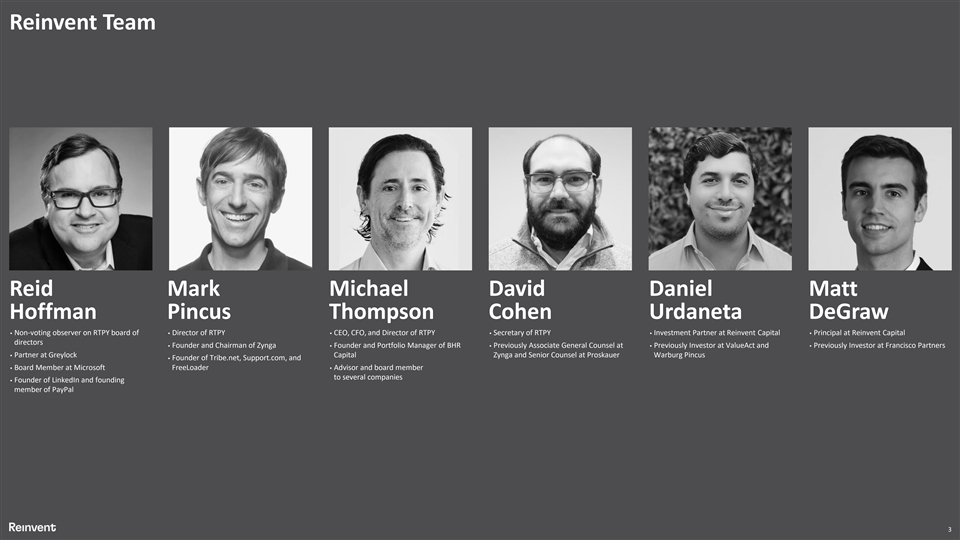
Reinvent Team Reid Mark Michael David Daniel Matt Hoffman Pincus Thompson Cohen Urdaneta DeGraw • Non-voting observer on RTPY board of • Director of RTPY• CEO, CFO, and Director of RTPY• Secretary of RTPY• Investment Partner at Reinvent Capital• Principal at Reinvent Capital directors • Founder and Chairman of Zynga• Founder and Portfolio Manager of BHR • Previously Associate General Counsel at • Previously Investor at ValueAct and • Previously Investor at Francisco Partners • Partner at Greylock Capital Zynga and Senior Counsel at Proskauer Warburg Pincus • Founder of Tribe.net, Support.com, and • Board Member at Microsoft FreeLoader• Advisor and board member to several companies • Founder of LinkedIn and founding member of PayPal 3
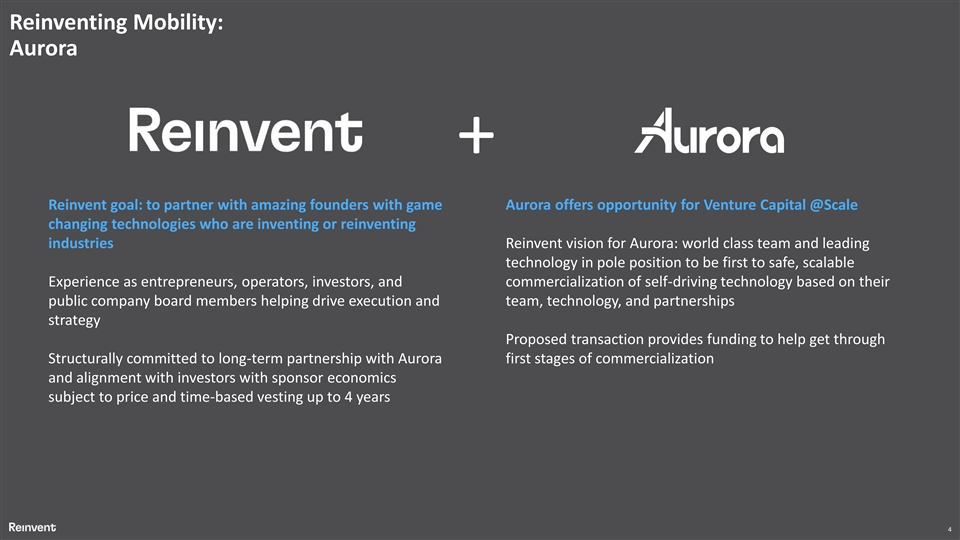
Reinventing Mobility: Aurora + Reinvent goal: to partner with amazing founders with game Aurora offers opportunity for Venture Capital @Scale changing technologies who are inventing or reinventing industries Reinvent vision for Aurora: world class team and leading technology in pole position to be first to safe, scalable Experience as entrepreneurs, operators, investors, and commercialization of self-driving technology based on their public company board members helping drive execution and team, technology, and partnerships strategy Proposed transaction provides funding to help get through Structurally committed to long-term partnership with Aurora first stages of commercialization and alignment with investors with sponsor economics subject to price and time-based vesting up to 4 years 4Reinventing Mobility: Aurora + Reinvent goal: to partner with amazing founders with game Aurora offers opportunity for Venture Capital @Scale changing technologies who are inventing or reinventing industries Reinvent vision for Aurora: world class team and leading technology in pole position to be first to safe, scalable Experience as entrepreneurs, operators, investors, and commercialization of self-driving technology based on their public company board members helping drive execution and team, technology, and partnerships strategy Proposed transaction provides funding to help get through Structurally committed to long-term partnership with Aurora first stages of commercialization and alignment with investors with sponsor economics subject to price and time-based vesting up to 4 years 4
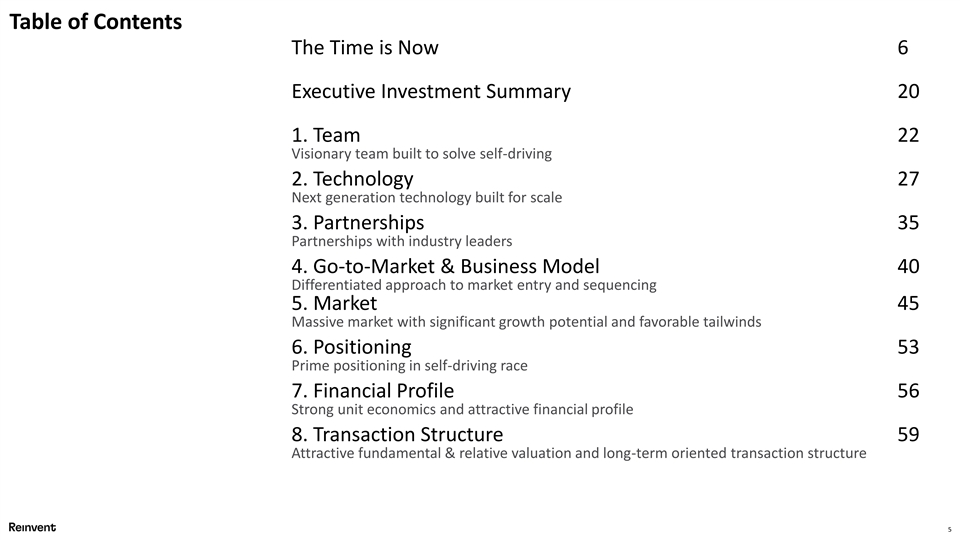
Table of Contents The Time is Now 6 Executive Investment Summary 20 1. Team 22 Visionary team built to solve self-driving 2. Technology 27 Next generation technology built for scale 3. Partnerships 35 Partnerships with industry leaders 4. Go-to-Market & Business Model 40 Differentiated approach to market entry and sequencing 5. Market 45 Massive market with significant growth potential and favorable tailwinds 6. Positioning 53 Prime positioning in self-driving race 7. Financial Profile 56 Strong unit economics and attractive financial profile 8. Transaction Structure 59 Attractive fundamental & relative valuation and long-term oriented transaction structure 5Table of Contents The Time is Now 6 Executive Investment Summary 20 1. Team 22 Visionary team built to solve self-driving 2. Technology 27 Next generation technology built for scale 3. Partnerships 35 Partnerships with industry leaders 4. Go-to-Market & Business Model 40 Differentiated approach to market entry and sequencing 5. Market 45 Massive market with significant growth potential and favorable tailwinds 6. Positioning 53 Prime positioning in self-driving race 7. Financial Profile 56 Strong unit economics and attractive financial profile 8. Transaction Structure 59 Attractive fundamental & relative valuation and long-term oriented transaction structure 5

The Time is Now 6
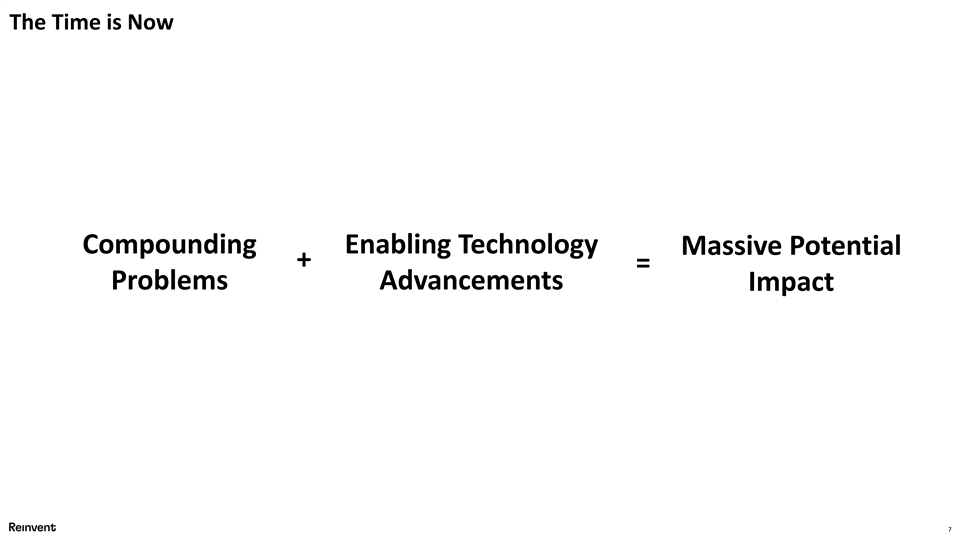
The Time is Now Compounding Enabling Technology Massive Potential + = Problems Advancements Impact 7The Time is Now Compounding Enabling Technology Massive Potential + = Problems Advancements Impact 7
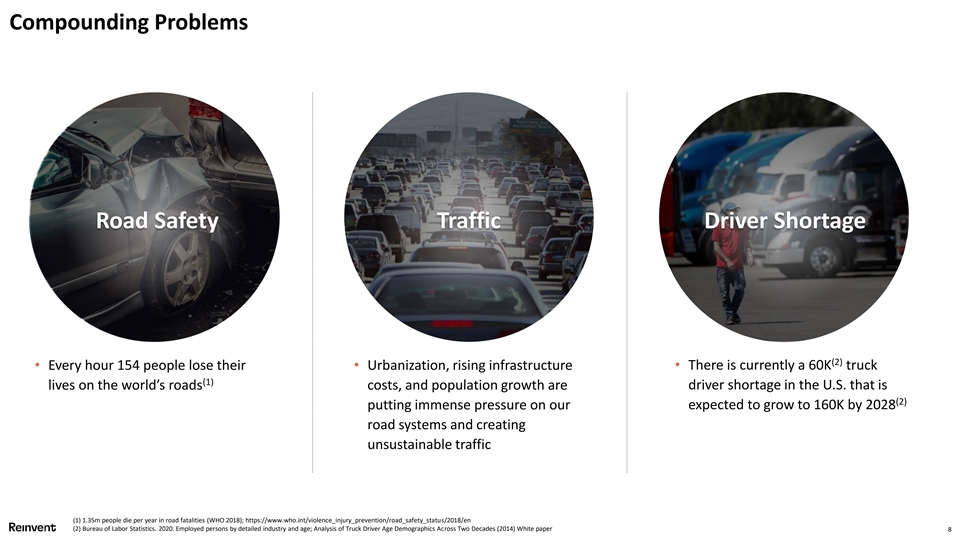
Compounding Problems Road Safety Traffic Driver Shortage (2) • Every hour 154 people lose their • Urbanization, rising infrastructure • There is currently a 60K truck (1) driver shortage in the U.S. that is lives on the world’s roads costs, and population growth are (2) expected to grow to 160K by 2028 putting immense pressure on our road systems and creating unsustainable traffic (1) 1.35m people die per year in road fatalities (WHO 2018); https://www.who.int/violence_injury_prevention/road_safety_status/2018/en (2) Bureau of Labor Statistics. 2020. Employed persons by detailed industry and age; Analysis of Truck Driver Age Demographics Across Two Decades (2014) White paper 8Compounding Problems Road Safety Traffic Driver Shortage (2) • Every hour 154 people lose their • Urbanization, rising infrastructure • There is currently a 60K truck (1) driver shortage in the U.S. that is lives on the world’s roads costs, and population growth are (2) expected to grow to 160K by 2028 putting immense pressure on our road systems and creating unsustainable traffic (1) 1.35m people die per year in road fatalities (WHO 2018); https://www.who.int/violence_injury_prevention/road_safety_status/2018/en (2) Bureau of Labor Statistics. 2020. Employed persons by detailed industry and age; Analysis of Truck Driver Age Demographics Across Two Decades (2014) White paper 8
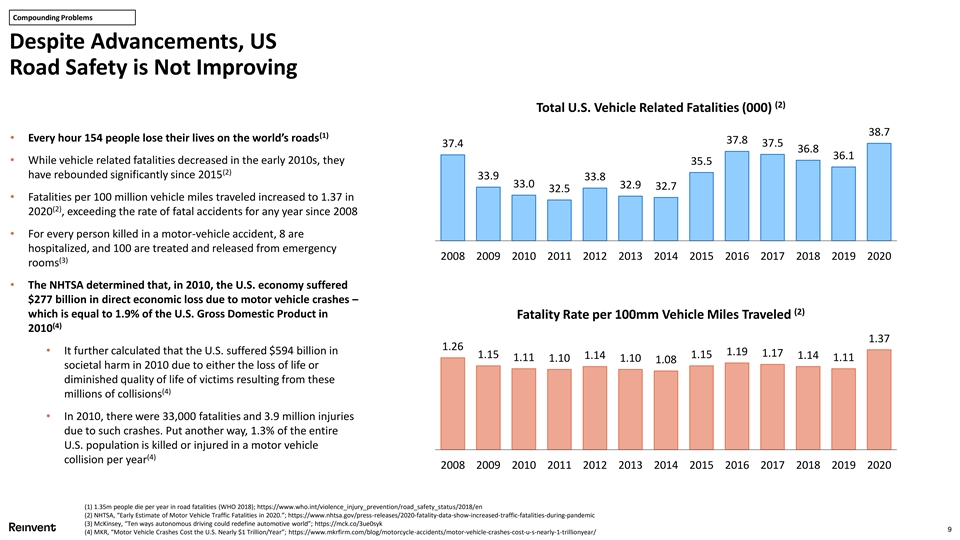
Compounding Problems Despite Advancements, US Road Safety is Not Improving (2) Total U.S. Vehicle Related Fatalities (000) 38.7 (1) • Every hour 154 people lose their lives on the world’s roads 37.8 37.4 37.5 36.8 36.1 • While vehicle related fatalities decreased in the early 2010s, they 35.5 (2) have rebounded significantly since 2015 33.9 33.8 33.0 32.9 32.7 32.5 • Fatalities per 100 million vehicle miles traveled increased to 1.37 in (2) 2020 , exceeding the rate of fatal accidents for any year since 2008 • For every person killed in a motor-vehicle accident, 8 are hospitalized, and 100 are treated and released from emergency 2008 2009 2010 2011 2012 2013 2014 2015 2016 2017 2018 2019 2020 (3) rooms • The NHTSA determined that, in 2010, the U.S. economy suffered $277 billion in direct economic loss due to motor vehicle crashes – (2) which is equal to 1.9% of the U.S. Gross Domestic Product in Fatality Rate per 100mm Vehicle Miles Traveled (4) 2010 1.37 1.26 • It further calculated that the U.S. suffered $594 billion in 1.19 1.17 1.15 1.15 1.14 1.14 1.11 1.11 1.10 1.10 1.08 societal harm in 2010 due to either the loss of life or diminished quality of life of victims resulting from these (4) millions of collisions • In 2010, there were 33,000 fatalities and 3.9 million injuries due to such crashes. Put another way, 1.3% of the entire U.S. population is killed or injured in a motor vehicle (4) collision per year 2008 2009 2010 2011 2012 2013 2014 2015 2016 2017 2018 2019 2020 (1) 1.35m people die per year in road fatalities (WHO 2018); https://www.who.int/violence_injury_prevention/road_safety_status/2018/en (2) NHTSA, “Early Estimate of Motor Vehicle Traffic Fatalities in 2020.”; https://www.nhtsa.gov/press-releases/2020-fatality-data-show-increased-traffic-fatalities-during-pandemic (3) McKinsey, “Ten ways autonomous driving could redefine automotive world”; https://mck.co/3ue0syk 9 (4) MKR, “Motor Vehicle Crashes Cost the U.S. Nearly $1 Trillion/Year”; https://www.mkrfirm.com/blog/motorcycle-accidents/motor-vehicle-crashes-cost-u-s-nearly-1-trillionyear/Compounding Problems Despite Advancements, US Road Safety is Not Improving (2) Total U.S. Vehicle Related Fatalities (000) 38.7 (1) • Every hour 154 people lose their lives on the world’s roads 37.8 37.4 37.5 36.8 36.1 • While vehicle related fatalities decreased in the early 2010s, they 35.5 (2) have rebounded significantly since 2015 33.9 33.8 33.0 32.9 32.7 32.5 • Fatalities per 100 million vehicle miles traveled increased to 1.37 in (2) 2020 , exceeding the rate of fatal accidents for any year since 2008 • For every person killed in a motor-vehicle accident, 8 are hospitalized, and 100 are treated and released from emergency 2008 2009 2010 2011 2012 2013 2014 2015 2016 2017 2018 2019 2020 (3) rooms • The NHTSA determined that, in 2010, the U.S. economy suffered $277 billion in direct economic loss due to motor vehicle crashes – (2) which is equal to 1.9% of the U.S. Gross Domestic Product in Fatality Rate per 100mm Vehicle Miles Traveled (4) 2010 1.37 1.26 • It further calculated that the U.S. suffered $594 billion in 1.19 1.17 1.15 1.15 1.14 1.14 1.11 1.11 1.10 1.10 1.08 societal harm in 2010 due to either the loss of life or diminished quality of life of victims resulting from these (4) millions of collisions • In 2010, there were 33,000 fatalities and 3.9 million injuries due to such crashes. Put another way, 1.3% of the entire U.S. population is killed or injured in a motor vehicle (4) collision per year 2008 2009 2010 2011 2012 2013 2014 2015 2016 2017 2018 2019 2020 (1) 1.35m people die per year in road fatalities (WHO 2018); https://www.who.int/violence_injury_prevention/road_safety_status/2018/en (2) NHTSA, “Early Estimate of Motor Vehicle Traffic Fatalities in 2020.”; https://www.nhtsa.gov/press-releases/2020-fatality-data-show-increased-traffic-fatalities-during-pandemic (3) McKinsey, “Ten ways autonomous driving could redefine automotive world”; https://mck.co/3ue0syk 9 (4) MKR, “Motor Vehicle Crashes Cost the U.S. Nearly $1 Trillion/Year”; https://www.mkrfirm.com/blog/motorcycle-accidents/motor-vehicle-crashes-cost-u-s-nearly-1-trillionyear/
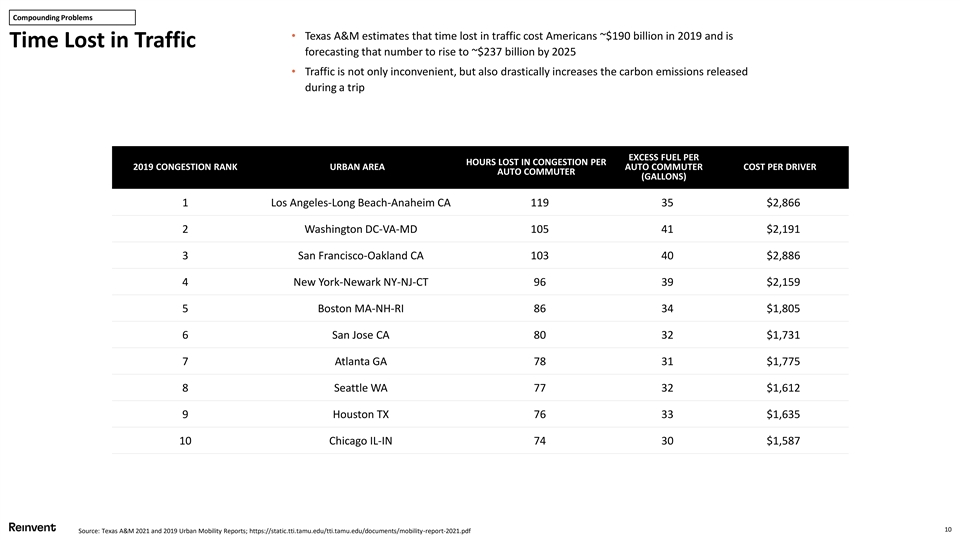
Compounding Problems • Texas A&M estimates that time lost in traffic cost Americans ~$190 billion in 2019 and is Time Lost in Traffic forecasting that number to rise to ~$237 billion by 2025 • Traffic is not only inconvenient, but also drastically increases the carbon emissions released during a trip EXCESS FUEL PER HOURS LOST IN CONGESTION PER 2019 CONGESTION RANK URBAN AREA AUTO COMMUTER COST PER DRIVER AUTO COMMUTER (GALLONS) 1 Los Angeles-Long Beach-Anaheim CA 119 35 $2,866 2 Washington DC-VA-MD 105 41 $2,191 3 San Francisco-Oakland CA 103 40 $2,886 4 New York-Newark NY-NJ-CT 96 39 $2,159 5 Boston MA-NH-RI 86 34 $1,805 6 San Jose CA 80 32 $1,731 7 Atlanta GA 78 31 $1,775 8 Seattle WA 77 32 $1,612 9 Houston TX 76 33 $1,635 10 Chicago IL-IN 74 30 $1,587 10 Source: Texas A&M 2021 and 2019 Urban Mobility Reports; https://static.tti.tamu.edu/tti.tamu.edu/documents/mobility-report-2021.pdfCompounding Problems • Texas A&M estimates that time lost in traffic cost Americans ~$190 billion in 2019 and is Time Lost in Traffic forecasting that number to rise to ~$237 billion by 2025 • Traffic is not only inconvenient, but also drastically increases the carbon emissions released during a trip EXCESS FUEL PER HOURS LOST IN CONGESTION PER 2019 CONGESTION RANK URBAN AREA AUTO COMMUTER COST PER DRIVER AUTO COMMUTER (GALLONS) 1 Los Angeles-Long Beach-Anaheim CA 119 35 $2,866 2 Washington DC-VA-MD 105 41 $2,191 3 San Francisco-Oakland CA 103 40 $2,886 4 New York-Newark NY-NJ-CT 96 39 $2,159 5 Boston MA-NH-RI 86 34 $1,805 6 San Jose CA 80 32 $1,731 7 Atlanta GA 78 31 $1,775 8 Seattle WA 77 32 $1,612 9 Houston TX 76 33 $1,635 10 Chicago IL-IN 74 30 $1,587 10 Source: Texas A&M 2021 and 2019 Urban Mobility Reports; https://static.tti.tamu.edu/tti.tamu.edu/documents/mobility-report-2021.pdf
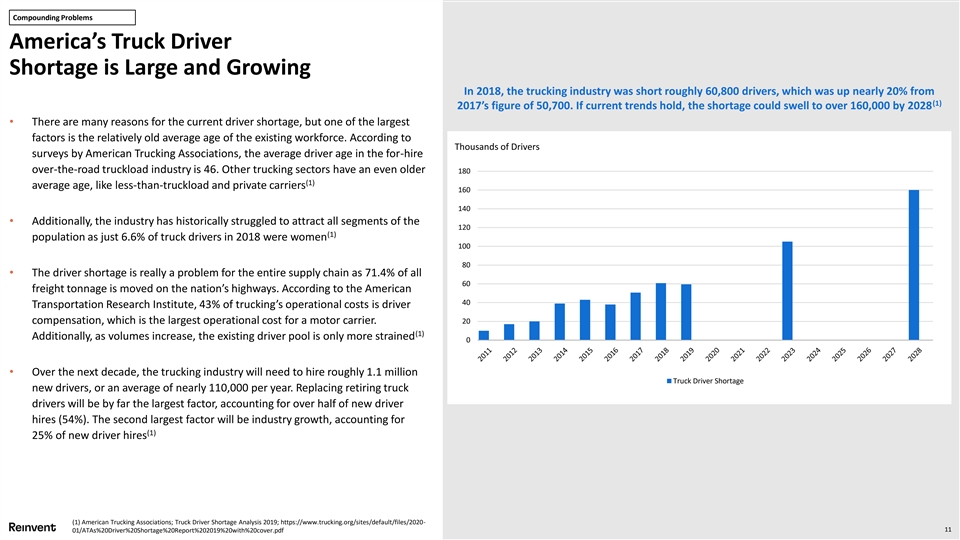
Compounding Problems America’s Truck Driver Shortage is Large and Growing In 2018, the trucking industry was short roughly 60,800 drivers, which was up nearly 20% from (1) 2017’s figure of 50,700. If current trends hold, the shortage could swell to over 160,000 by 2028 • There are many reasons for the current driver shortage, but one of the largest factors is the relatively old average age of the existing workforce. According to Thousands of Drivers surveys by American Trucking Associations, the average driver age in the for-hire over-the-road truckload industry is 46. Other trucking sectors have an even older 180 (1) average age, like less-than-truckload and private carriers 160 140 • Additionally, the industry has historically struggled to attract all segments of the 120 (1) population as just 6.6% of truck drivers in 2018 were women 100 80 • The driver shortage is really a problem for the entire supply chain as 71.4% of all 60 freight tonnage is moved on the nation’s highways. According to the American 40 Transportation Research Institute, 43% of trucking’s operational costs is driver compensation, which is the largest operational cost for a motor carrier. 20 (1) Additionally, as volumes increase, the existing driver pool is only more strained 0 • Over the next decade, the trucking industry will need to hire roughly 1.1 million Truck Driver Shortage new drivers, or an average of nearly 110,000 per year. Replacing retiring truck drivers will be by far the largest factor, accounting for over half of new driver hires (54%). The second largest factor will be industry growth, accounting for (1) 25% of new driver hires (1) American Trucking Associations; Truck Driver Shortage Analysis 2019; https://www.trucking.org/sites/default/files/2020- 11 01/ATAs%20Driver%20Shortage%20Report%202019%20with%20cover.pdf Compounding Problems America’s Truck Driver Shortage is Large and Growing In 2018, the trucking industry was short roughly 60,800 drivers, which was up nearly 20% from (1) 2017’s figure of 50,700. If current trends hold, the shortage could swell to over 160,000 by 2028 • There are many reasons for the current driver shortage, but one of the largest factors is the relatively old average age of the existing workforce. According to Thousands of Drivers surveys by American Trucking Associations, the average driver age in the for-hire over-the-road truckload industry is 46. Other trucking sectors have an even older 180 (1) average age, like less-than-truckload and private carriers 160 140 • Additionally, the industry has historically struggled to attract all segments of the 120 (1) population as just 6.6% of truck drivers in 2018 were women 100 80 • The driver shortage is really a problem for the entire supply chain as 71.4% of all 60 freight tonnage is moved on the nation’s highways. According to the American 40 Transportation Research Institute, 43% of trucking’s operational costs is driver compensation, which is the largest operational cost for a motor carrier. 20 (1) Additionally, as volumes increase, the existing driver pool is only more strained 0 • Over the next decade, the trucking industry will need to hire roughly 1.1 million Truck Driver Shortage new drivers, or an average of nearly 110,000 per year. Replacing retiring truck drivers will be by far the largest factor, accounting for over half of new driver hires (54%). The second largest factor will be industry growth, accounting for (1) 25% of new driver hires (1) American Trucking Associations; Truck Driver Shortage Analysis 2019; https://www.trucking.org/sites/default/files/2020- 11 01/ATAs%20Driver%20Shortage%20Report%202019%20with%20cover.pdf
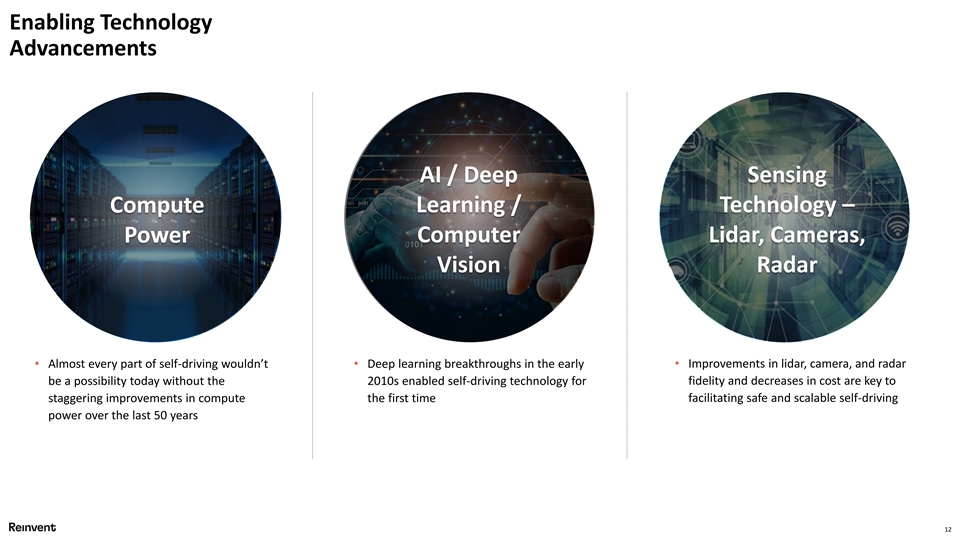
Enabling Technology Advancements AI / Deep Sensing Learning / Technology – Compute Computer Lidar, Cameras, Power Vision Radar • Almost every part of self-driving wouldn’t • Deep learning breakthroughs in the early • Improvements in lidar, camera, and radar be a possibility today without the 2010s enabled self-driving technology for fidelity and decreases in cost are key to staggering improvements in compute the first time facilitating safe and scalable self-driving power over the last 50 years 12Enabling Technology Advancements AI / Deep Sensing Learning / Technology – Compute Computer Lidar, Cameras, Power Vision Radar • Almost every part of self-driving wouldn’t • Deep learning breakthroughs in the early • Improvements in lidar, camera, and radar be a possibility today without the 2010s enabled self-driving technology for fidelity and decreases in cost are key to staggering improvements in compute the first time facilitating safe and scalable self-driving power over the last 50 years 12
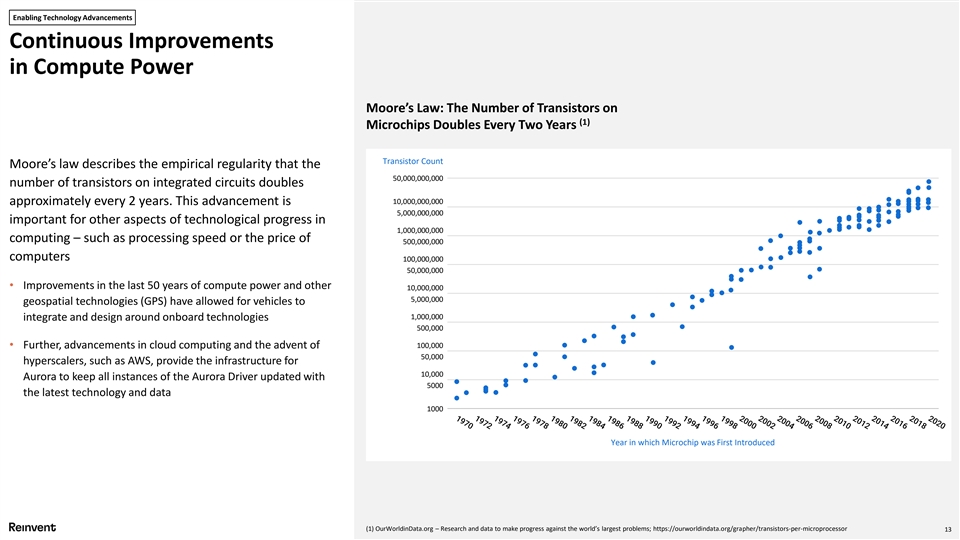
Enabling Technology Advancements Continuous Improvements in Compute Power Moore’s Law: The Number of Transistors on (1) Microchips Doubles Every Two Years Transistor Count Moore’s law describes the empirical regularity that the 50,000,000,000 number of transistors on integrated circuits doubles 10,000,000,000 approximately every 2 years. This advancement is 5,000,000,000 important for other aspects of technological progress in 1,000,000,000 computing – such as processing speed or the price of 500,000,000 computers 100,000,000 50,000,000 • Improvements in the last 50 years of compute power and other 10,000,000 5,000,000 geospatial technologies (GPS) have allowed for vehicles to 1,000,000 integrate and design around onboard technologies 500,000 100,000 • Further, advancements in cloud computing and the advent of 50,000 hyperscalers, such as AWS, provide the infrastructure for 10,000 Aurora to keep all instances of the Aurora Driver updated with 5000 the latest technology and data 1000 Year in which Microchip was First Introduced (1) OurWorldinData.org – Research and data to make progress against the world’s largest problems; https://ourworldindata.org/grapher/transistors-per-microprocessor 13
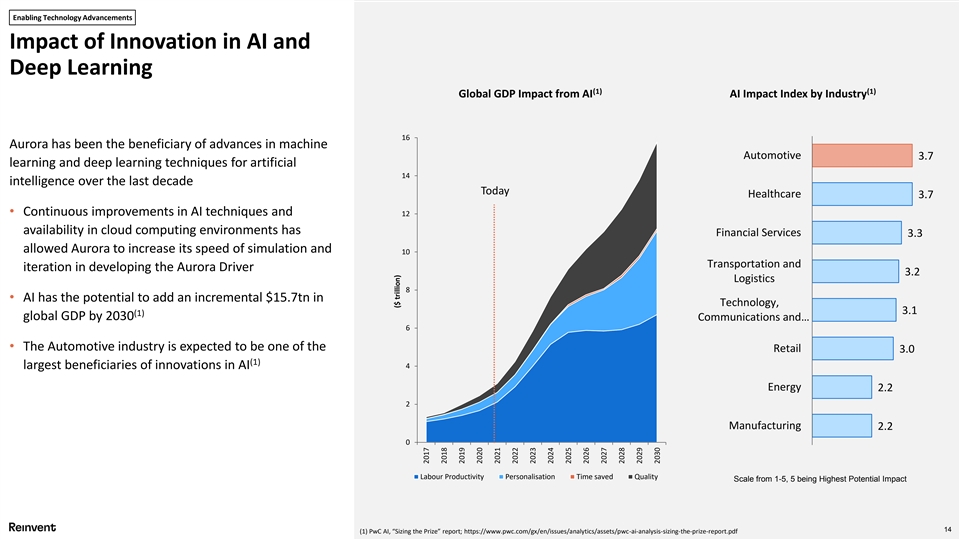
Enabling Technology Advancements Impact of Innovation in AI and Deep Learning (1) (1) Global GDP Impact from AI AI Impact Index by Industry 16 Aurora has been the beneficiary of advances in machine Automotive 3.7 learning and deep learning techniques for artificial 14 intelligence over the last decade Today Healthcare 3.7 • Continuous improvements in AI techniques and 12 availability in cloud computing environments has Financial Services 3.3 allowed Aurora to increase its speed of simulation and 10 Transportation and iteration in developing the Aurora Driver 3.2 Logistics 8 • AI has the potential to add an incremental $15.7tn in Technology, 3.1 (1) global GDP by 2030 Communications and… 6 • The Automotive industry is expected to be one of the Retail 3.0 (1) largest beneficiaries of innovations in AI 4 Energy 2.2 2 Manufacturing 2.2 0 Labour Productivity Personalisation Time saved Quality Scale from 1-5, 5 being Highest Potential Impact 14 (1) PwC AI, “Sizing the Prize” report; https://www.pwc.com/gx/en/issues/analytics/assets/pwc-ai-analysis-sizing-the-prize-report.pdf ($ trillion) 2017 2018 2019 2020 2021 2022 2023 2024 2025 2026 2027 2028 2029 2030Enabling Technology Advancements Impact of Innovation in AI and Deep Learning (1) (1) Global GDP Impact from AI AI Impact Index by Industry 16 Aurora has been the beneficiary of advances in machine Automotive 3.7 learning and deep learning techniques for artificial 14 intelligence over the last decade Today Healthcare 3.7 • Continuous improvements in AI techniques and 12 availability in cloud computing environments has Financial Services 3.3 allowed Aurora to increase its speed of simulation and 10 Transportation and iteration in developing the Aurora Driver 3.2 Logistics 8 • AI has the potential to add an incremental $15.7tn in Technology, 3.1 (1) global GDP by 2030 Communications and… 6 • The Automotive industry is expected to be one of the Retail 3.0 (1) largest beneficiaries of innovations in AI 4 Energy 2.2 2 Manufacturing 2.2 0 Labour Productivity Personalisation Time saved Quality Scale from 1-5, 5 being Highest Potential Impact 14 (1) PwC AI, “Sizing the Prize” report; https://www.pwc.com/gx/en/issues/analytics/assets/pwc-ai-analysis-sizing-the-prize-report.pdf ($ trillion) 2017 2018 2019 2020 2021 2022 2023 2024 2025 2026 2027 2028 2029 2030
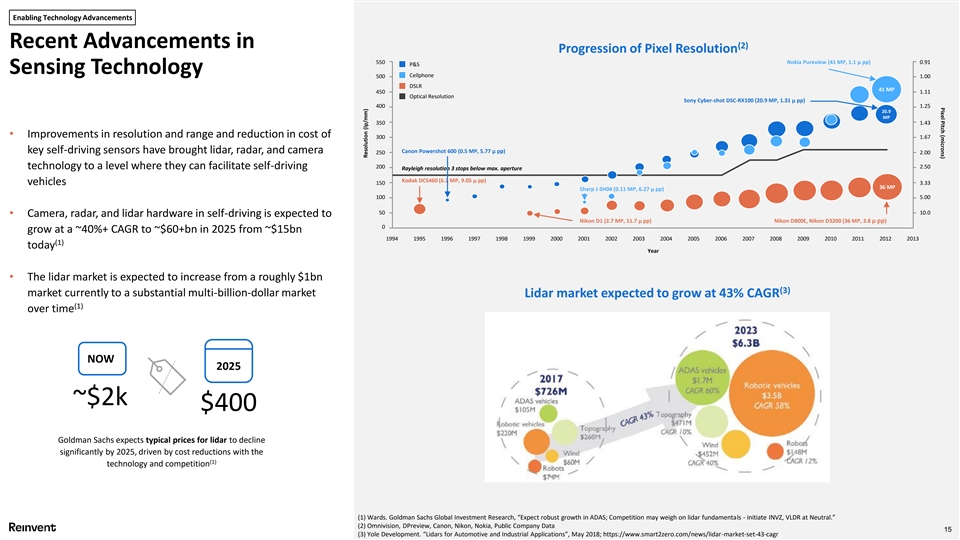
Pixel Pitch (microns) Enabling Technology Advancements Recent Advancements in (2) Progression of Pixel Resolution 550 Nokia Pureview (41 MP, 1.1 µ pp) 0.91 P&S Sensing Technology Cellphone 500 1.00 DSLR 41 MP 450 1.11 Optical Resolution Sony Cyber-shot DSC-RX100 (20.9 MP, 1.31 µ pp) 400 1.25 20.9 MP 350 1.43 • Improvements in resolution and range and reduction in cost of 300 1.67 key self-driving sensors have brought lidar, radar, and camera Canon Powershot 600 (0.5 MP, 5.77 µ pp) 250 2.00 technology to a level where they can facilitate self-driving 200 2.50 Rayleigh resolution 3 stops below max. aperture Kodak DCS460 (6.2 MP, 9.05 µ pp) vehicles 150 3.33 36 MP Sharp J-SH04 (0.11 MP, 6.27 µ pp) 100 5.00 50 10.0 • Camera, radar, and lidar hardware in self-driving is expected to Nikon D1 (2.7 MP, 11.7 µ pp) Nikon D800E, Nikon D3200 (36 MP, 3.8 µ pp) 0 grow at a ~40%+ CAGR to ~$60+bn in 2025 from ~$15bn 1994 1995 1996 1997 1998 1999 2000 2001 2002 2003 2004 2005 2006 2007 2008 2009 2010 2011 2012 2013 (1) today Year • The lidar market is expected to increase from a roughly $1bn (3) market currently to a substantial multi-billion-dollar market Lidar market expected to grow at 43% CAGR (1) over time NOW 2025 ~$2k $400 Goldman Sachs expects typical prices for lidar to decline significantly by 2025, driven by cost reductions with the (1) technology and competition (1) Wards. Goldman Sachs Global Investment Research, “Expect robust growth in ADAS; Competition may weigh on lidar fundamentals - initiate INVZ, VLDR at Neutral.” (2) Omnivision, DPreview, Canon, Nikon, Nokia, Public Company Data 15 (3) Yole Development. “Lidars for Automotive and Industrial Applications”, May 2018; https://www.smart2zero.com/news/lidar-market-set-43-cagr Resolution (lp/mm)Pixel Pitch (microns) Enabling Technology Advancements Recent Advancements in (2) Progression of Pixel Resolution 550 Nokia Pureview (41 MP, 1.1 µ pp) 0.91 P&S Sensing Technology Cellphone 500 1.00 DSLR 41 MP 450 1.11 Optical Resolution Sony Cyber-shot DSC-RX100 (20.9 MP, 1.31 µ pp) 400 1.25 20.9 MP 350 1.43 • Improvements in resolution and range and reduction in cost of 300 1.67 key self-driving sensors have brought lidar, radar, and camera Canon Powershot 600 (0.5 MP, 5.77 µ pp) 250 2.00 technology to a level where they can facilitate self-driving 200 2.50 Rayleigh resolution 3 stops below max. aperture Kodak DCS460 (6.2 MP, 9.05 µ pp) vehicles 150 3.33 36 MP Sharp J-SH04 (0.11 MP, 6.27 µ pp) 100 5.00 50 10.0 • Camera, radar, and lidar hardware in self-driving is expected to Nikon D1 (2.7 MP, 11.7 µ pp) Nikon D800E, Nikon D3200 (36 MP, 3.8 µ pp) 0 grow at a ~40%+ CAGR to ~$60+bn in 2025 from ~$15bn 1994 1995 1996 1997 1998 1999 2000 2001 2002 2003 2004 2005 2006 2007 2008 2009 2010 2011 2012 2013 (1) today Year • The lidar market is expected to increase from a roughly $1bn (3) market currently to a substantial multi-billion-dollar market Lidar market expected to grow at 43% CAGR (1) over time NOW 2025 ~$2k $400 Goldman Sachs expects typical prices for lidar to decline significantly by 2025, driven by cost reductions with the (1) technology and competition (1) Wards. Goldman Sachs Global Investment Research, “Expect robust growth in ADAS; Competition may weigh on lidar fundamentals - initiate INVZ, VLDR at Neutral.” (2) Omnivision, DPreview, Canon, Nikon, Nokia, Public Company Data 15 (3) Yole Development. “Lidars for Automotive and Industrial Applications”, May 2018; https://www.smart2zero.com/news/lidar-market-set-43-cagr Resolution (lp/mm)
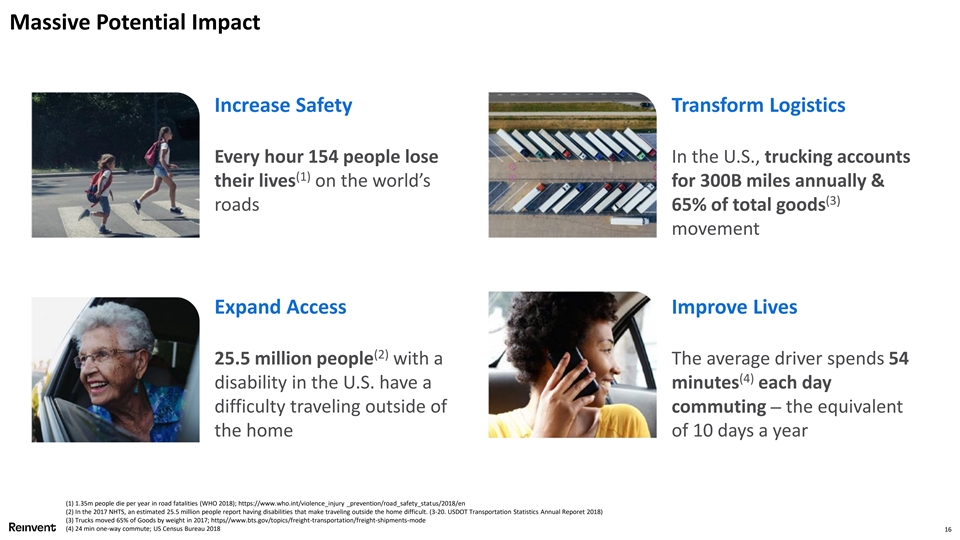
Massive Potential Impact Increase Safety Transform Logistics Every hour 154 people lose In the U.S., trucking accounts (1) their lives on the world’s for 300B miles annually & (3) roads 65% of total goods movement Expand Access Improve Lives (2) 25.5 million people with a The average driver spends 54 (4) disability in the U.S. have a minutes each day difficulty traveling outside of commuting– the equivalent the home of 10 days a year (1) 1.35m people die per year in road fatalities (WHO 2018); https://www.who.int/violence_injury _prevention/road_safety_status/2018/en (2) In the 2017 NHTS, an estimated 25.5 million people report having disabilities that make traveling outside the home difficult. (3-20. USDOT Transportation Statistics Annual Reporet 2018) (3) Trucks moved 65% of Goods by weight in 2017; https//www.bts.gov/topics/freight-transportation/freight-shipments-mode (4) 24 min one-way commute; US Census Bureau 2018 16Massive Potential Impact Increase Safety Transform Logistics Every hour 154 people lose In the U.S., trucking accounts (1) their lives on the world’s for 300B miles annually & (3) roads 65% of total goods movement Expand Access Improve Lives (2) 25.5 million people with a The average driver spends 54 (4) disability in the U.S. have a minutes each day difficulty traveling outside of commuting– the equivalent the home of 10 days a year (1) 1.35m people die per year in road fatalities (WHO 2018); https://www.who.int/violence_injury _prevention/road_safety_status/2018/en (2) In the 2017 NHTS, an estimated 25.5 million people report having disabilities that make traveling outside the home difficult. (3-20. USDOT Transportation Statistics Annual Reporet 2018) (3) Trucks moved 65% of Goods by weight in 2017; https//www.bts.gov/topics/freight-transportation/freight-shipments-mode (4) 24 min one-way commute; US Census Bureau 2018 16
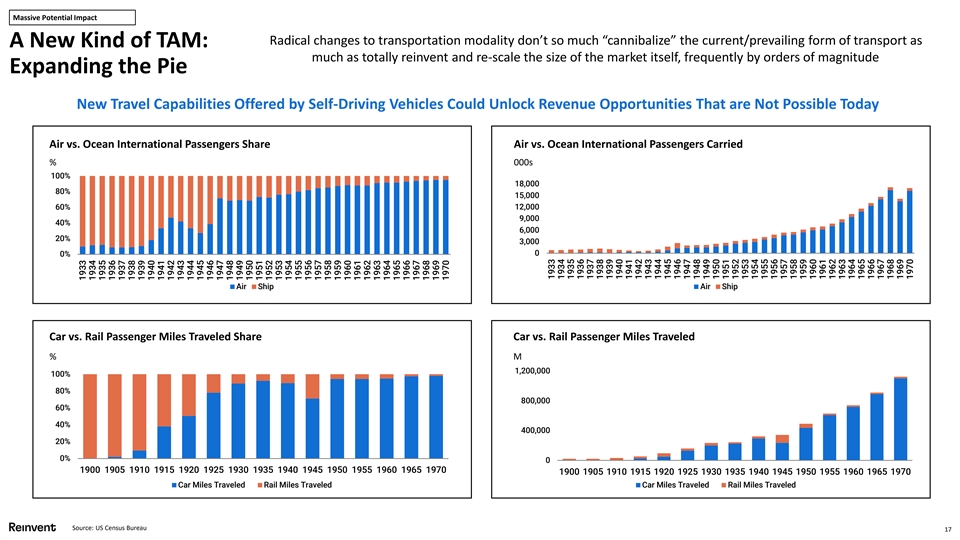
Massive Potential Impact Radical changes to transportation modality don’t so much “cannibalize” the current/prevailing form of transport as A New Kind of TAM: much as totally reinvent and re-scale the size of the market itself, frequently by orders of magnitude Expanding the Pie New Travel Capabilities Offered by Self-Driving Vehicles Could Unlock Revenue Opportunities That are Not Possible Today Air vs. Ocean International Passengers Share Air vs. Ocean International Passengers Carried % 000s 100% 18,000 80% 15,000 60% 12,000 9,000 40% 6,000 20% 3,000 0 0% Air Ship Air Ship Car vs. Rail Passenger Miles Traveled Share Car vs. Rail Passenger Miles Traveled % M 1,200,000 100% 80% 800,000 60% 40% 400,000 20% 0% 0 1900 1905 1910 1915 1920 1925 1930 1935 1940 1945 1950 1955 1960 1965 1970 1900 1905 1910 1915 1920 1925 1930 1935 1940 1945 1950 1955 1960 1965 1970 Car Miles Traveled Rail Miles Traveled Car Miles Traveled Rail Miles Traveled Source: US Census Bureau 17 1933 1934 1935 1936 1937 1938 1939 1940 1941 1942 1943 1944 1945 1946 1947 1948 1949 1950 1951 1952 1953 1954 1955 1956 1957 1958 1959 1960 1961 1962 1963 1964 1965 1966 1967 1968 1969 1970 1933 1934 1935 1936 1937 1938 1939 1940 1941 1942 1943 1944 1945 1946 1947 1948 1949 1950 1951 1952 1953 1954 1955 1956 1957 1958 1959 1960 1961 1962 1963 1964 1965 1966 1967 1968 1969 1970Massive Potential Impact Radical changes to transportation modality don’t so much “cannibalize” the current/prevailing form of transport as A New Kind of TAM: much as totally reinvent and re-scale the size of the market itself, frequently by orders of magnitude Expanding the Pie New Travel Capabilities Offered by Self-Driving Vehicles Could Unlock Revenue Opportunities That are Not Possible Today Air vs. Ocean International Passengers Share Air vs. Ocean International Passengers Carried % 000s 100% 18,000 80% 15,000 60% 12,000 9,000 40% 6,000 20% 3,000 0 0% Air Ship Air Ship Car vs. Rail Passenger Miles Traveled Share Car vs. Rail Passenger Miles Traveled % M 1,200,000 100% 80% 800,000 60% 40% 400,000 20% 0% 0 1900 1905 1910 1915 1920 1925 1930 1935 1940 1945 1950 1955 1960 1965 1970 1900 1905 1910 1915 1920 1925 1930 1935 1940 1945 1950 1955 1960 1965 1970 Car Miles Traveled Rail Miles Traveled Car Miles Traveled Rail Miles Traveled Source: US Census Bureau 17 1933 1934 1935 1936 1937 1938 1939 1940 1941 1942 1943 1944 1945 1946 1947 1948 1949 1950 1951 1952 1953 1954 1955 1956 1957 1958 1959 1960 1961 1962 1963 1964 1965 1966 1967 1968 1969 1970 1933 1934 1935 1936 1937 1938 1939 1940 1941 1942 1943 1944 1945 1946 1947 1948 1949 1950 1951 1952 1953 1954 1955 1956 1957 1958 1959 1960 1961 1962 1963 1964 1965 1966 1967 1968 1969 1970
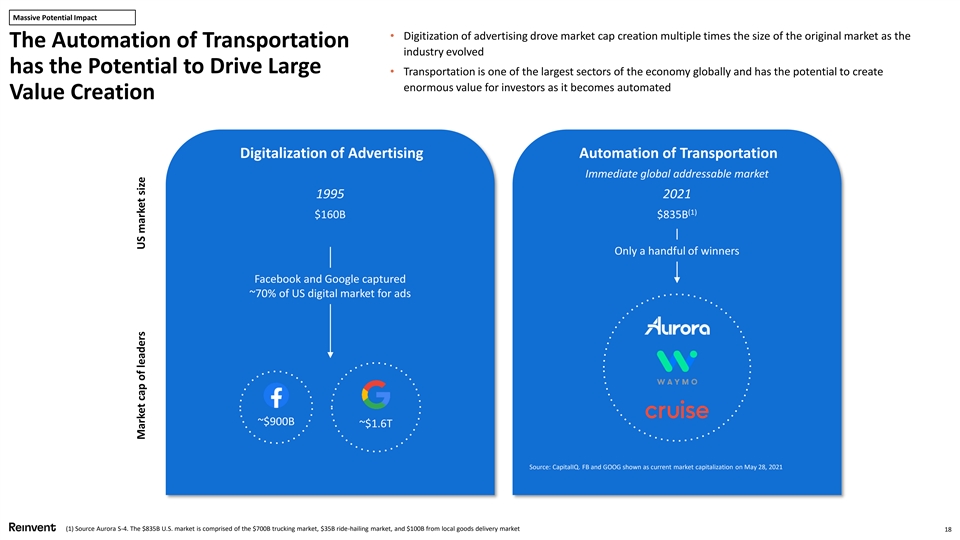
Massive Potential Impact • Digitization of advertising drove market cap creation multiple times the size of the original market as the The Automation of Transportation industry evolved has the Potential to Drive Large • Transportation is one of the largest sectors of the economy globally and has the potential to create enormous value for investors as it becomes automated Value Creation Digitalization of Advertising Automation of Transportation Immediate global addressable market 1995 2021 (1) $160B $835B Only a handful of winners Facebook and Google captured ~70% of US digital market for ads ~$900B ~$1.6T Source: CapitalIQ. FB and GOOG shown as current market capitalization on May 28, 2021 (1) Source Aurora S-4. The $835B U.S. market is comprised of the $700B trucking market, $35B ride-hailing market, and $100B from local goods delivery market 18 Market cap of leaders US market sizeMassive Potential Impact • Digitization of advertising drove market cap creation multiple times the size of the original market as the The Automation of Transportation industry evolved has the Potential to Drive Large • Transportation is one of the largest sectors of the economy globally and has the potential to create enormous value for investors as it becomes automated Value Creation Digitalization of Advertising Automation of Transportation Immediate global addressable market 1995 2021 (1) $160B $835B Only a handful of winners Facebook and Google captured ~70% of US digital market for ads ~$900B ~$1.6T Source: CapitalIQ. FB and GOOG shown as current market capitalization on May 28, 2021 (1) Source Aurora S-4. The $835B U.S. market is comprised of the $700B trucking market, $35B ride-hailing market, and $100B from local goods delivery market 18 Market cap of leaders US market size
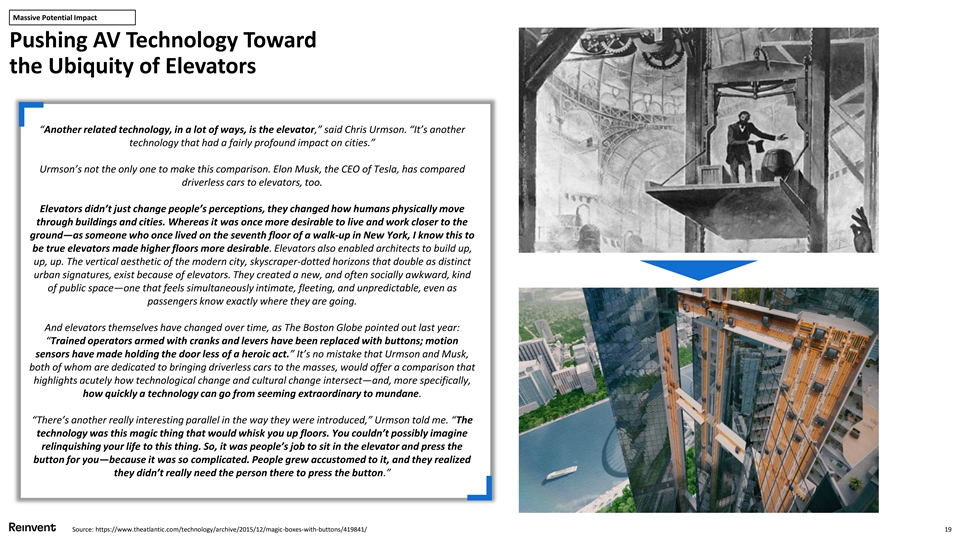
Massive Potential Impact Pushing AV Technology Toward the Ubiquity of Elevators “Another related technology, in a lot of ways, is the elevator,” said Chris Urmson. “It’s another technology that had a fairly profound impact on cities.” Urmson’s not the only one to make this comparison. Elon Musk, the CEO of Tesla, has compared driverless cars to elevators, too. Elevators didn’t just change people’s perceptions, they changed how humans physically move through buildings and cities. Whereas it was once more desirable to live and work closer to the ground—as someone who once lived on the seventh floor of a walk-up in New York, I know this to be true elevators made higher floors more desirable. Elevators also enabled architects to build up, up, up. The vertical aesthetic of the modern city, skyscraper-dotted horizons that double as distinct urban signatures, exist because of elevators. They created a new, and often socially awkward, kind of public space—one that feels simultaneously intimate, fleeting, and unpredictable, even as passengers know exactly where they are going. And elevators themselves have changed over time, as The Boston Globe pointed out last year: “Trained operators armed with cranks and levers have been replaced with buttons; motion sensors have made holding the door less of a heroic act.” It’s no mistake that Urmson and Musk, both of whom are dedicated to bringing driverless cars to the masses, would offer a comparison that highlights acutely how technological change and cultural change intersect—and, more specifically, how quickly a technology can go from seeming extraordinary to mundane. “There’s another really interesting parallel in the way they were introduced,” Urmson told me. “The technology was this magic thing that would whisk you up floors. You couldn’t possibly imagine relinquishing your life to this thing. So, it was people’s job to sit in the elevator and press the button for you—because it was so complicated. People grew accustomed to it, and they realized they didn’t really need the person there to press the button.” Source: https://www.theatlantic.com/technology/archive/2015/12/magic-boxes-with-buttons/419841/ 19Massive Potential Impact Pushing AV Technology Toward the Ubiquity of Elevators “Another related technology, in a lot of ways, is the elevator,” said Chris Urmson. “It’s another technology that had a fairly profound impact on cities.” Urmson’s not the only one to make this comparison. Elon Musk, the CEO of Tesla, has compared driverless cars to elevators, too. Elevators didn’t just change people’s perceptions, they changed how humans physically move through buildings and cities. Whereas it was once more desirable to live and work closer to the ground—as someone who once lived on the seventh floor of a walk-up in New York, I know this to be true elevators made higher floors more desirable. Elevators also enabled architects to build up, up, up. The vertical aesthetic of the modern city, skyscraper-dotted horizons that double as distinct urban signatures, exist because of elevators. They created a new, and often socially awkward, kind of public space—one that feels simultaneously intimate, fleeting, and unpredictable, even as passengers know exactly where they are going. And elevators themselves have changed over time, as The Boston Globe pointed out last year: “Trained operators armed with cranks and levers have been replaced with buttons; motion sensors have made holding the door less of a heroic act.” It’s no mistake that Urmson and Musk, both of whom are dedicated to bringing driverless cars to the masses, would offer a comparison that highlights acutely how technological change and cultural change intersect—and, more specifically, how quickly a technology can go from seeming extraordinary to mundane. “There’s another really interesting parallel in the way they were introduced,” Urmson told me. “The technology was this magic thing that would whisk you up floors. You couldn’t possibly imagine relinquishing your life to this thing. So, it was people’s job to sit in the elevator and press the button for you—because it was so complicated. People grew accustomed to it, and they realized they didn’t really need the person there to press the button.” Source: https://www.theatlantic.com/technology/archive/2015/12/magic-boxes-with-buttons/419841/ 19
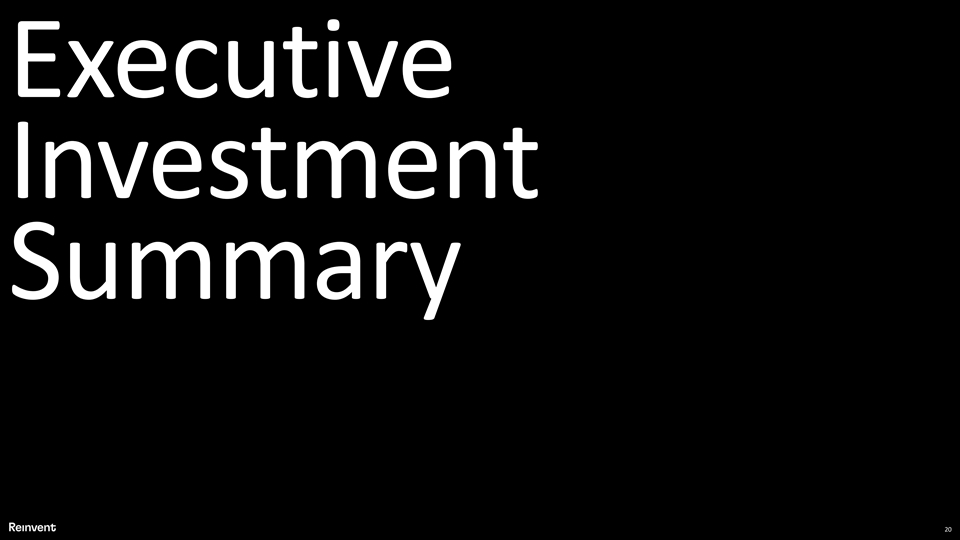
Executive Investment Summary 20
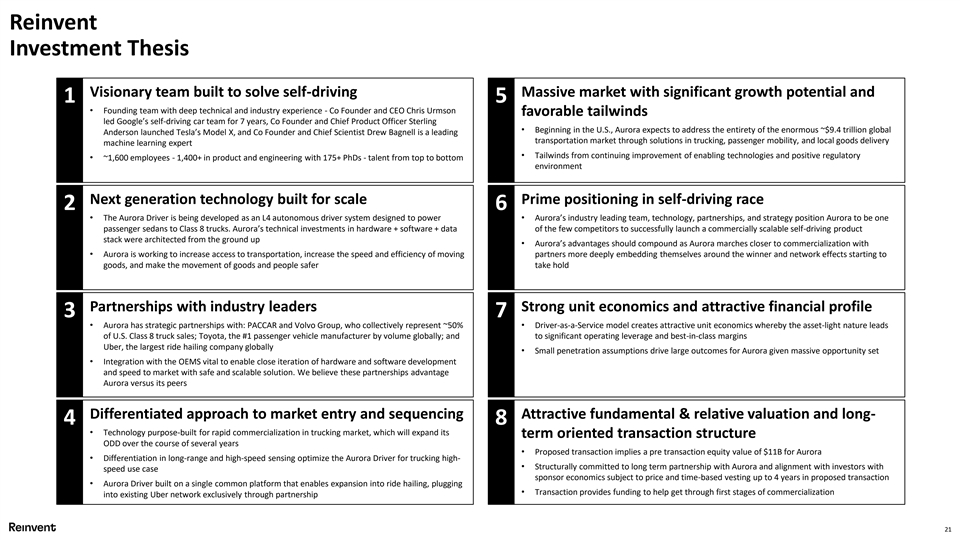
Reinvent Investment Thesis Visionary team built to solve self-driving Massive market with significant growth potential and 1 5 • Founding team with deep technical and industry experience - Co Founder and CEO Chris Urmson favorable tailwinds led Google’s self-driving car team for 7 years, Co Founder and Chief Product Officer Sterling • Beginning in the U.S., Aurora expects to address the entirety of the enormous ~$9.4 trillion global Anderson launched Tesla’s Model X, and Co Founder and Chief Scientist Drew Bagnell is a leading transportation market through solutions in trucking, passenger mobility, and local goods delivery machine learning expert • Tailwinds from continuing improvement of enabling technologies and positive regulatory • ~1,600 employees - 1,400+ in product and engineering with 175+ PhDs - talent from top to bottom environment Next generation technology built for scale Prime positioning in self-driving race 2 6 • The Aurora Driver is being developed as an L4 autonomous driver system designed to power • Aurora’s industry leading team, technology, partnerships, and strategy position Aurora to be one passenger sedans to Class 8 trucks. Aurora’s technical investments in hardware + software + data of the few competitors to successfully launch a commercially scalable self-driving product stack were architected from the ground up • Aurora’s advantages should compound as Aurora marches closer to commercialization with • Aurora is working to increase access to transportation, increase the speed and efficiency of moving partners more deeply embedding themselves around the winner and network effects starting to goods, and make the movement of goods and people safer take hold Partnerships with industry leaders Strong unit economics and attractive financial profile 3 7 • Aurora has strategic partnerships with: PACCAR and Volvo Group, who collectively represent ~50% • Driver-as-a-Service model creates attractive unit economics whereby the asset-light nature leads of U.S. Class 8 truck sales; Toyota, the #1 passenger vehicle manufacturer by volume globally; and to significant operating leverage and best-in-class margins Uber, the largest ride hailing company globally • Small penetration assumptions drive large outcomes for Aurora given massive opportunity set • Integration with the OEMS vital to enable close iteration of hardware and software development and speed to market with safe and scalable solution. We believe these partnerships advantage Aurora versus its peers Differentiated approach to market entry and sequencing Attractive fundamental & relative valuation and long- 4 8 • Technology purpose-built for rapid commercialization in trucking market, which will expand its term oriented transaction structure ODD over the course of several years • Proposed transaction implies a pre transaction equity value of $11B for Aurora • Differentiation in long-range and high-speed sensing optimize the Aurora Driver for trucking high- • Structurally committed to long term partnership with Aurora and alignment with investors with speed use case sponsor economics subject to price and time-based vesting up to 4 years in proposed transaction • Aurora Driver built on a single common platform that enables expansion into ride hailing, plugging • Transaction provides funding to help get through first stages of commercialization into existing Uber network exclusively through partnership 21Reinvent Investment Thesis Visionary team built to solve self-driving Massive market with significant growth potential and 1 5 • Founding team with deep technical and industry experience - Co Founder and CEO Chris Urmson favorable tailwinds led Google’s self-driving car team for 7 years, Co Founder and Chief Product Officer Sterling • Beginning in the U.S., Aurora expects to address the entirety of the enormous ~$9.4 trillion global Anderson launched Tesla’s Model X, and Co Founder and Chief Scientist Drew Bagnell is a leading transportation market through solutions in trucking, passenger mobility, and local goods delivery machine learning expert • Tailwinds from continuing improvement of enabling technologies and positive regulatory • ~1,600 employees - 1,400+ in product and engineering with 175+ PhDs - talent from top to bottom environment Next generation technology built for scale Prime positioning in self-driving race 2 6 • The Aurora Driver is being developed as an L4 autonomous driver system designed to power • Aurora’s industry leading team, technology, partnerships, and strategy position Aurora to be one passenger sedans to Class 8 trucks. Aurora’s technical investments in hardware + software + data of the few competitors to successfully launch a commercially scalable self-driving product stack were architected from the ground up • Aurora’s advantages should compound as Aurora marches closer to commercialization with • Aurora is working to increase access to transportation, increase the speed and efficiency of moving partners more deeply embedding themselves around the winner and network effects starting to goods, and make the movement of goods and people safer take hold Partnerships with industry leaders Strong unit economics and attractive financial profile 3 7 • Aurora has strategic partnerships with: PACCAR and Volvo Group, who collectively represent ~50% • Driver-as-a-Service model creates attractive unit economics whereby the asset-light nature leads of U.S. Class 8 truck sales; Toyota, the #1 passenger vehicle manufacturer by volume globally; and to significant operating leverage and best-in-class margins Uber, the largest ride hailing company globally • Small penetration assumptions drive large outcomes for Aurora given massive opportunity set • Integration with the OEMS vital to enable close iteration of hardware and software development and speed to market with safe and scalable solution. We believe these partnerships advantage Aurora versus its peers Differentiated approach to market entry and sequencing Attractive fundamental & relative valuation and long- 4 8 • Technology purpose-built for rapid commercialization in trucking market, which will expand its term oriented transaction structure ODD over the course of several years • Proposed transaction implies a pre transaction equity value of $11B for Aurora • Differentiation in long-range and high-speed sensing optimize the Aurora Driver for trucking high- • Structurally committed to long term partnership with Aurora and alignment with investors with speed use case sponsor economics subject to price and time-based vesting up to 4 years in proposed transaction • Aurora Driver built on a single common platform that enables expansion into ride hailing, plugging • Transaction provides funding to help get through first stages of commercialization into existing Uber network exclusively through partnership 21
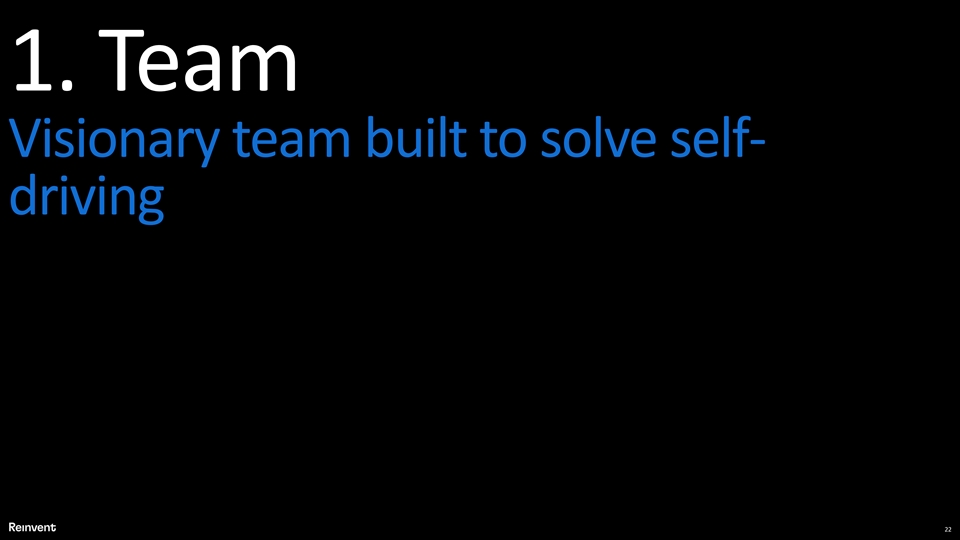
1. Team Visionary team built to solve self- driving 221. Team Visionary team built to solve self- driving 22

Aurora Has Proven Leadership and Expertise Aurora Leadership Team The team that will deliver • Chris helped found Google’s self-driving car project and lead Waymo for 7 years • Drew is one of the top machine learning experts in the world and helped build Uber ATG Chris Urmson Drew Bagnell Sterling Anderson Sandor Barna Khobi Brooklyn Nat Beuse Richard Tame Chief Executive Officer, Co- Chief Scientist, Chief Product Senior VP of Hardware VP of Communications VP of Safety VP of Finance • Sterling was intimately involved in launching Tesla’s Model X founder Co-founder Officer, Co-founder Engineering • Solving self-driving is an extremely complicated endeavor which further highlights the importance of having the smartest, most experienced team • The Aurora team has run into constraining local maxima at each of their prior companies and thereby understand the need for constant reinvention and have the best handle on what is going to be required to solve self- Gerhard Eschelbeck Colette Bridgman Will Mouat Tara Green Gerardo Interiano Bart Nabbe David Maday Chief Information Security VP of Marketing General Counsel VP of People VP of Government VP of Corporate VP of Business driving Officer Operations Relations Development & Strategic Development Partnerships • Significantly more experience and expertise than competitors in trucking • We believe the best team will ultimately be the one to solve self-driving 23Aurora Has Proven Leadership and Expertise Aurora Leadership Team The team that will deliver • Chris helped found Google’s self-driving car project and lead Waymo for 7 years • Drew is one of the top machine learning experts in the world and helped build Uber ATG Chris Urmson Drew Bagnell Sterling Anderson Sandor Barna Khobi Brooklyn Nat Beuse Richard Tame Chief Executive Officer, Co- Chief Scientist, Chief Product Senior VP of Hardware VP of Communications VP of Safety VP of Finance • Sterling was intimately involved in launching Tesla’s Model X founder Co-founder Officer, Co-founder Engineering • Solving self-driving is an extremely complicated endeavor which further highlights the importance of having the smartest, most experienced team • The Aurora team has run into constraining local maxima at each of their prior companies and thereby understand the need for constant reinvention and have the best handle on what is going to be required to solve self- Gerhard Eschelbeck Colette Bridgman Will Mouat Tara Green Gerardo Interiano Bart Nabbe David Maday Chief Information Security VP of Marketing General Counsel VP of People VP of Government VP of Corporate VP of Business driving Officer Operations Relations Development & Strategic Development Partnerships • Significantly more experience and expertise than competitors in trucking • We believe the best team will ultimately be the one to solve self-driving 23
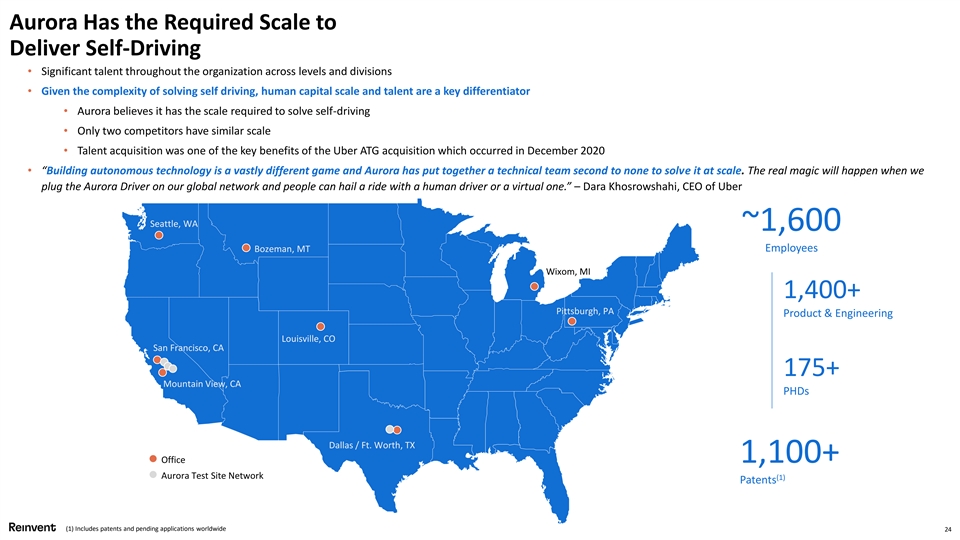
Aurora Has the Required Scale to Deliver Self-Driving • Significant talent throughout the organization across levels and divisions • Given the complexity of solving self driving, human capital scale and talent are a key differentiator • Aurora believes it has the scale required to solve self-driving • Only two competitors have similar scale • Talent acquisition was one of the key benefits of the Uber ATG acquisition which occurred in December 2020 • “Building autonomous technology is a vastly different game and Aurora has put together a technical team second to none to solve it at scale. The real magic will happen when we plug the Aurora Driver on our global network and people can hail a ride with a human driver or a virtual one.” – Dara Khosrowshahi, CEO of Uber Seattle, WA ~1,600 Bozeman, MT Employees Wixom, MI 1,400+ Pittsburgh, PA Product & Engineering Louisville, CO San Francisco, CA 175+ Mountain View, CA PHDs Dallas / Ft. Worth, TX Office 1,100+ Aurora Test Site Network (1) Patents (1) Includes patents and pending applications worldwide 24Aurora Has the Required Scale to Deliver Self-Driving • Significant talent throughout the organization across levels and divisions • Given the complexity of solving self driving, human capital scale and talent are a key differentiator • Aurora believes it has the scale required to solve self-driving • Only two competitors have similar scale • Talent acquisition was one of the key benefits of the Uber ATG acquisition which occurred in December 2020 • “Building autonomous technology is a vastly different game and Aurora has put together a technical team second to none to solve it at scale. The real magic will happen when we plug the Aurora Driver on our global network and people can hail a ride with a human driver or a virtual one.” – Dara Khosrowshahi, CEO of Uber Seattle, WA ~1,600 Bozeman, MT Employees Wixom, MI 1,400+ Pittsburgh, PA Product & Engineering Louisville, CO San Francisco, CA 175+ Mountain View, CA PHDs Dallas / Ft. Worth, TX Office 1,100+ Aurora Test Site Network (1) Patents (1) Includes patents and pending applications worldwide 24
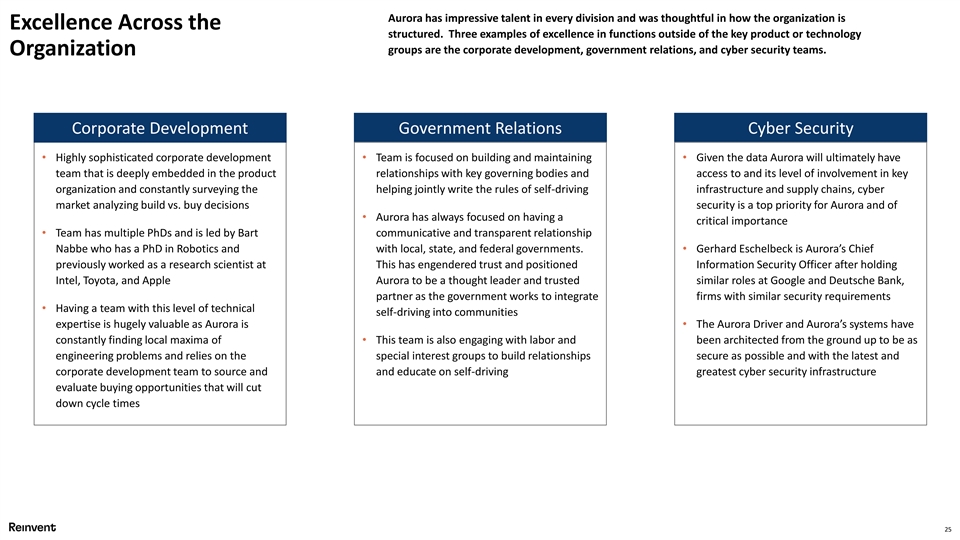
Aurora has impressive talent in every division and was thoughtful in how the organization is Excellence Across the structured. Three examples of excellence in functions outside of the key product or technology groups are the corporate development, government relations, and cyber security teams. Organization Corporate Development Government Relations Cyber Security • Highly sophisticated corporate development • Team is focused on building and maintaining • Given the data Aurora will ultimately have team that is deeply embedded in the product relationships with key governing bodies and access to and its level of involvement in key organization and constantly surveying the helping jointly write the rules of self-driving infrastructure and supply chains, cyber market analyzing build vs. buy decisions security is a top priority for Aurora and of • Aurora has always focused on having a critical importance • Team has multiple PhDs and is led by Bart communicative and transparent relationship Nabbe who has a PhD in Robotics and with local, state, and federal governments. • Gerhard Eschelbeck is Aurora’s Chief previously worked as a research scientist at This has engendered trust and positioned Information Security Officer after holding Intel, Toyota, and Apple Aurora to be a thought leader and trusted similar roles at Google and Deutsche Bank, partner as the government works to integrate firms with similar security requirements • Having a team with this level of technical self-driving into communities expertise is hugely valuable as Aurora is • The Aurora Driver and Aurora’s systems have constantly finding local maxima of • This team is also engaging with labor and been architected from the ground up to be as engineering problems and relies on the special interest groups to build relationships secure as possible and with the latest and corporate development team to source and and educate on self-driving greatest cyber security infrastructure evaluate buying opportunities that will cut down cycle times 25Aurora has impressive talent in every division and was thoughtful in how the organization is Excellence Across the structured. Three examples of excellence in functions outside of the key product or technology groups are the corporate development, government relations, and cyber security teams. Organization Corporate Development Government Relations Cyber Security • Highly sophisticated corporate development • Team is focused on building and maintaining • Given the data Aurora will ultimately have team that is deeply embedded in the product relationships with key governing bodies and access to and its level of involvement in key organization and constantly surveying the helping jointly write the rules of self-driving infrastructure and supply chains, cyber market analyzing build vs. buy decisions security is a top priority for Aurora and of • Aurora has always focused on having a critical importance • Team has multiple PhDs and is led by Bart communicative and transparent relationship Nabbe who has a PhD in Robotics and with local, state, and federal governments. • Gerhard Eschelbeck is Aurora’s Chief previously worked as a research scientist at This has engendered trust and positioned Information Security Officer after holding Intel, Toyota, and Apple Aurora to be a thought leader and trusted similar roles at Google and Deutsche Bank, partner as the government works to integrate firms with similar security requirements • Having a team with this level of technical self-driving into communities expertise is hugely valuable as Aurora is • The Aurora Driver and Aurora’s systems have constantly finding local maxima of • This team is also engaging with labor and been architected from the ground up to be as engineering problems and relies on the special interest groups to build relationships secure as possible and with the latest and corporate development team to source and and educate on self-driving greatest cyber security infrastructure evaluate buying opportunities that will cut down cycle times 25
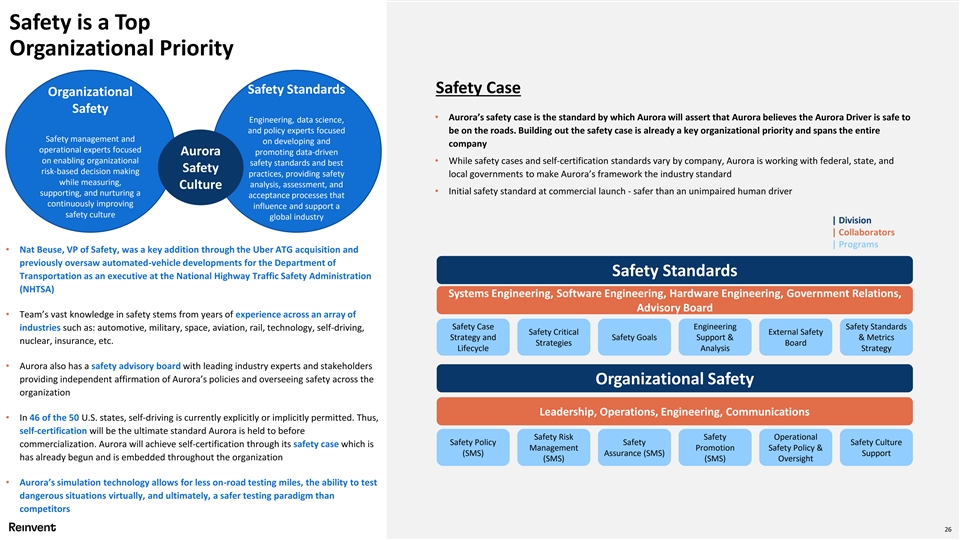
Safety is a Top Organizational Priority Safety Case Safety Standards Organizational Safety • Aurora’s safety case is the standard by which Aurora will assert that Aurora believes the Aurora Driver is safe to Engineering, data science, and policy experts focused be on the roads. Building out the safety case is already a key organizational priority and spans the entire Safety management and on developing and company operational experts focused Aurora promoting data-driven on enabling organizational • While safety cases and self-certification standards vary by company, Aurora is working with federal, state, and safety standards and best Safety risk-based decision making practices, providing safety local governments to make Aurora’s framework the industry standard while measuring, analysis, assessment, and Culture • Initial safety standard at commercial launch - safer than an unimpaired human driver supporting, and nurturing a acceptance processes that continuously improving influence and support a safety culture global industry | Division | Collaborators | Programs • Nat Beuse, VP of Safety, was a key addition through the Uber ATG acquisition and previously oversaw automated-vehicle developments for the Department of Safety Standards Transportation as an executive at the National Highway Traffic Safety Administration (NHTSA) Systems Engineering, Software Engineering, Hardware Engineering, Government Relations, Advisory Board • Team’s vast knowledge in safety stems from years of experience across an array of Safety Case Engineering Safety Standards industries such as: automotive, military, space, aviation, rail, technology, self-driving, Safety Critical External Safety Strategy and Safety Goals Support & & Metrics nuclear, insurance, etc. Strategies Board Lifecycle Analysis Strategy • Aurora also has a safety advisory board with leading industry experts and stakeholders providing independent affirmation of Aurora’s policies and overseeing safety across the Organizational Safety organization Leadership, Operations, Engineering, Communications • In 46 of the 50 U.S. states, self-driving is currently explicitly or implicitly permitted. Thus, self-certification will be the ultimate standard Aurora is held to before Safety Risk Safety Operational Safety Policy Safety Safety Culture commercialization. Aurora will achieve self-certification through its safety case which is Management Promotion Safety Policy & (SMS) Assurance (SMS) Support has already begun and is embedded throughout the organization (SMS) (SMS) Oversight • Aurora’s simulation technology allows for less on-road testing miles, the ability to test dangerous situations virtually, and ultimately, a safer testing paradigm than competitors 26Safety is a Top Organizational Priority Safety Case Safety Standards Organizational Safety • Aurora’s safety case is the standard by which Aurora will assert that Aurora believes the Aurora Driver is safe to Engineering, data science, and policy experts focused be on the roads. Building out the safety case is already a key organizational priority and spans the entire Safety management and on developing and company operational experts focused Aurora promoting data-driven on enabling organizational • While safety cases and self-certification standards vary by company, Aurora is working with federal, state, and safety standards and best Safety risk-based decision making practices, providing safety local governments to make Aurora’s framework the industry standard while measuring, analysis, assessment, and Culture • Initial safety standard at commercial launch - safer than an unimpaired human driver supporting, and nurturing a acceptance processes that continuously improving influence and support a safety culture global industry | Division | Collaborators | Programs • Nat Beuse, VP of Safety, was a key addition through the Uber ATG acquisition and previously oversaw automated-vehicle developments for the Department of Safety Standards Transportation as an executive at the National Highway Traffic Safety Administration (NHTSA) Systems Engineering, Software Engineering, Hardware Engineering, Government Relations, Advisory Board • Team’s vast knowledge in safety stems from years of experience across an array of Safety Case Engineering Safety Standards industries such as: automotive, military, space, aviation, rail, technology, self-driving, Safety Critical External Safety Strategy and Safety Goals Support & & Metrics nuclear, insurance, etc. Strategies Board Lifecycle Analysis Strategy • Aurora also has a safety advisory board with leading industry experts and stakeholders providing independent affirmation of Aurora’s policies and overseeing safety across the Organizational Safety organization Leadership, Operations, Engineering, Communications • In 46 of the 50 U.S. states, self-driving is currently explicitly or implicitly permitted. Thus, self-certification will be the ultimate standard Aurora is held to before Safety Risk Safety Operational Safety Policy Safety Safety Culture commercialization. Aurora will achieve self-certification through its safety case which is Management Promotion Safety Policy & (SMS) Assurance (SMS) Support has already begun and is embedded throughout the organization (SMS) (SMS) Oversight • Aurora’s simulation technology allows for less on-road testing miles, the ability to test dangerous situations virtually, and ultimately, a safer testing paradigm than competitors 26
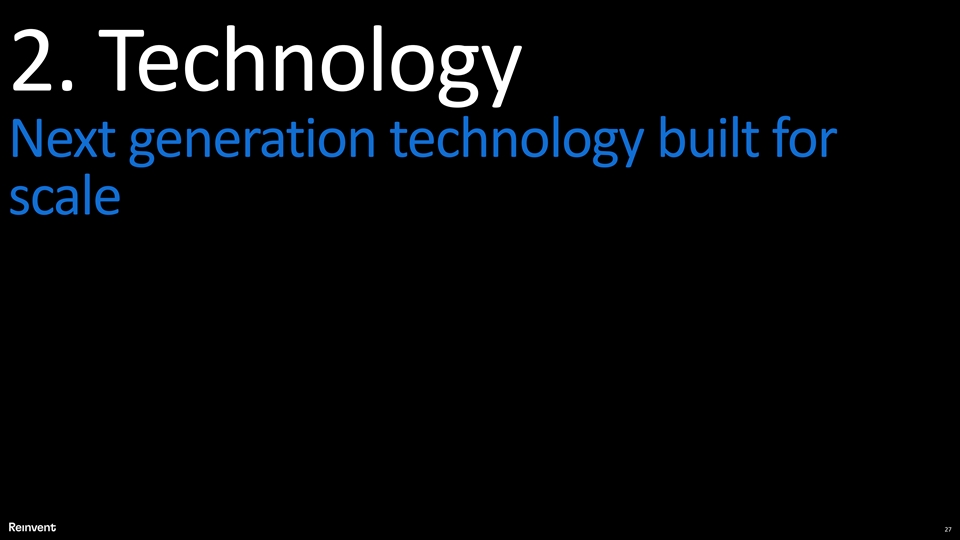
2. Technology Next generation technology built for scale 272. Technology Next generation technology built for scale 27
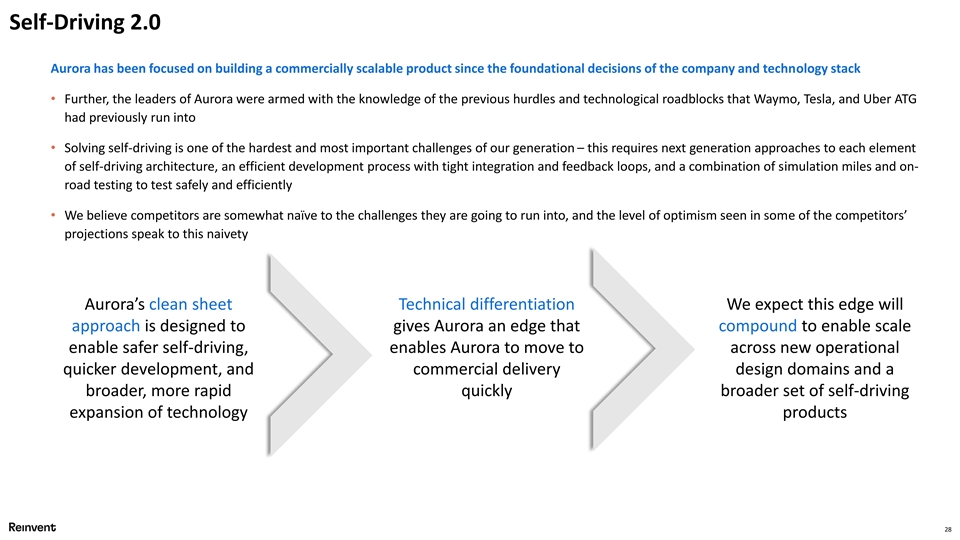
Self-Driving 2.0 Aurora has been focused on building a commercially scalable product since the foundational decisions of the company and technology stack • Further, the leaders of Aurora were armed with the knowledge of the previous hurdles and technological roadblocks that Waymo, Tesla, and Uber ATG had previously run into • Solving self-driving is one of the hardest and most important challenges of our generation – this requires next generation approaches to each element of self-driving architecture, an efficient development process with tight integration and feedback loops, and a combination of simulation miles and on- road testing to test safely and efficiently • We believe competitors are somewhat naïve to the challenges they are going to run into, and the level of optimism seen in some of the competitors’ projections speak to this naivety Aurora’s clean sheet Technical differentiation We expect this edge will approach is designed to gives Aurora an edge that compound to enable scale enable safer self-driving, enables Aurora to move to across new operational quicker development, and commercial delivery design domains and a broader, more rapid quickly broader set of self-driving expansion of technology products 28
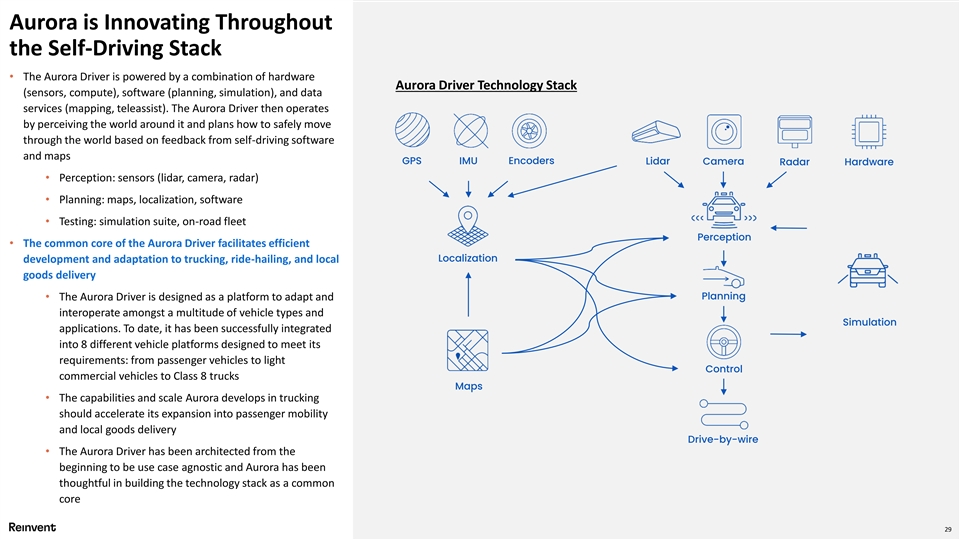
Aurora is Innovating Throughout the Self-Driving Stack • The Aurora Driver is powered by a combination of hardware Aurora Driver Technology Stack (sensors, compute), software (planning, simulation), and data services (mapping, teleassist). The Aurora Driver then operates by perceiving the world around it and plans how to safely move through the world based on feedback from self-driving software and maps GPS IMU Encoders Lidar Camera Radar Hardware • Perception: sensors (lidar, camera, radar) • Planning: maps, localization, software • Testing: simulation suite, on-road fleet Perception • The common core of the Aurora Driver facilitates efficient Localization development and adaptation to trucking, ride-hailing, and local goods delivery Planning • The Aurora Driver is designed as a platform to adapt and interoperate amongst a multitude of vehicle types and Simulation applications. To date, it has been successfully integrated into 8 different vehicle platforms designed to meet its requirements: from passenger vehicles to light Control commercial vehicles to Class 8 trucks Maps • The capabilities and scale Aurora develops in trucking should accelerate its expansion into passenger mobility and local goods delivery Drive-by-wire • The Aurora Driver has been architected from the beginning to be use case agnostic and Aurora has been thoughtful in building the technology stack as a common core 29Aurora is Innovating Throughout the Self-Driving Stack • The Aurora Driver is powered by a combination of hardware Aurora Driver Technology Stack (sensors, compute), software (planning, simulation), and data services (mapping, teleassist). The Aurora Driver then operates by perceiving the world around it and plans how to safely move through the world based on feedback from self-driving software and maps GPS IMU Encoders Lidar Camera Radar Hardware • Perception: sensors (lidar, camera, radar) • Planning: maps, localization, software • Testing: simulation suite, on-road fleet Perception • The common core of the Aurora Driver facilitates efficient Localization development and adaptation to trucking, ride-hailing, and local goods delivery Planning • The Aurora Driver is designed as a platform to adapt and interoperate amongst a multitude of vehicle types and Simulation applications. To date, it has been successfully integrated into 8 different vehicle platforms designed to meet its requirements: from passenger vehicles to light Control commercial vehicles to Class 8 trucks Maps • The capabilities and scale Aurora develops in trucking should accelerate its expansion into passenger mobility and local goods delivery Drive-by-wire • The Aurora Driver has been architected from the beginning to be use case agnostic and Aurora has been thoughtful in building the technology stack as a common core 29
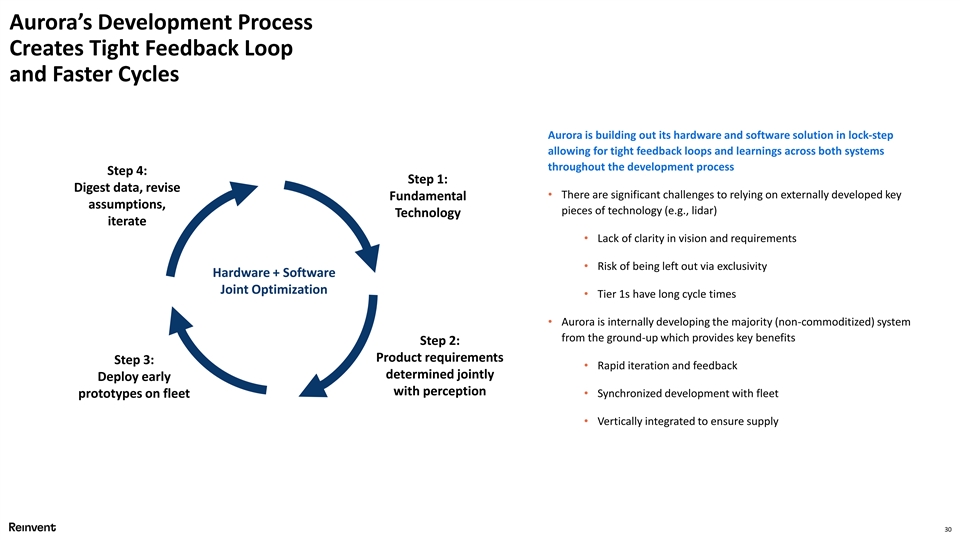
Aurora’s Development Process Creates Tight Feedback Loop and Faster Cycles Aurora is building out its hardware and software solution in lock-step allowing for tight feedback loops and learnings across both systems throughout the development process Step 4: Step 1: Digest data, revise • There are significant challenges to relying on externally developed key Fundamental assumptions, pieces of technology (e.g., lidar) Technology iterate • Lack of clarity in vision and requirements • Risk of being left out via exclusivity Hardware + Software Joint Optimization • Tier 1s have long cycle times • Aurora is internally developing the majority (non-commoditized) system from the ground-up which provides key benefits Step 2: Product requirements Step 3: • Rapid iteration and feedback determined jointly Deploy early with perception • Synchronized development with fleet prototypes on fleet • Vertically integrated to ensure supply 30Aurora’s Development Process Creates Tight Feedback Loop and Faster Cycles Aurora is building out its hardware and software solution in lock-step allowing for tight feedback loops and learnings across both systems throughout the development process Step 4: Step 1: Digest data, revise • There are significant challenges to relying on externally developed key Fundamental assumptions, pieces of technology (e.g., lidar) Technology iterate • Lack of clarity in vision and requirements • Risk of being left out via exclusivity Hardware + Software Joint Optimization • Tier 1s have long cycle times • Aurora is internally developing the majority (non-commoditized) system from the ground-up which provides key benefits Step 2: Product requirements Step 3: • Rapid iteration and feedback determined jointly Deploy early with perception • Synchronized development with fleet prototypes on fleet • Vertically integrated to ensure supply 30
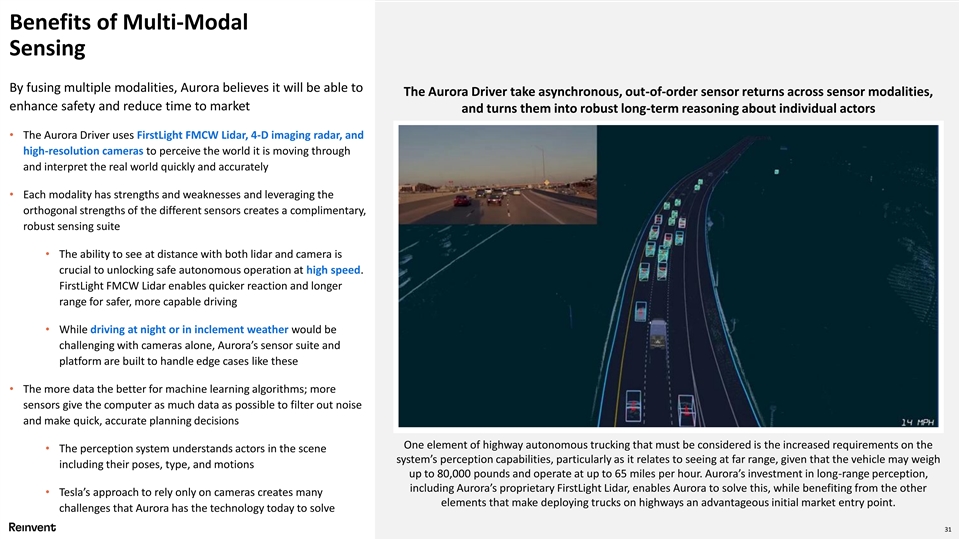
Benefits of Multi-Modal Sensing By fusing multiple modalities, Aurora believes it will be able to The Aurora Driver take asynchronous, out-of-order sensor returns across sensor modalities, enhance safety and reduce time to market and turns them into robust long-term reasoning about individual actors • The Aurora Driver uses FirstLight FMCW Lidar, 4-D imaging radar, and high-resolution cameras to perceive the world it is moving through and interpret the real world quickly and accurately • Each modality has strengths and weaknesses and leveraging the orthogonal strengths of the different sensors creates a complimentary, robust sensing suite • The ability to see at distance with both lidar and camera is crucial to unlocking safe autonomous operation at high speed. FirstLight FMCW Lidar enables quicker reaction and longer range for safer, more capable driving • While driving at night or in inclement weather would be challenging with cameras alone, Aurora’s sensor suite and platform are built to handle edge cases like these • The more data the better for machine learning algorithms; more sensors give the computer as much data as possible to filter out noise and make quick, accurate planning decisions One element of highway autonomous trucking that must be considered is the increased requirements on the • The perception system understands actors in the scene system’s perception capabilities, particularly as it relates to seeing at far range, given that the vehicle may weigh including their poses, type, and motions up to 80,000 pounds and operate at up to 65 miles per hour. Aurora’s investment in long-range perception, including Aurora’s proprietary FirstLight Lidar, enables Aurora to solve this, while benefiting from the other • Tesla’s approach to rely only on cameras creates many elements that make deploying trucks on highways an advantageous initial market entry point. challenges that Aurora has the technology today to solve 31Benefits of Multi-Modal Sensing By fusing multiple modalities, Aurora believes it will be able to The Aurora Driver take asynchronous, out-of-order sensor returns across sensor modalities, enhance safety and reduce time to market and turns them into robust long-term reasoning about individual actors • The Aurora Driver uses FirstLight FMCW Lidar, 4-D imaging radar, and high-resolution cameras to perceive the world it is moving through and interpret the real world quickly and accurately • Each modality has strengths and weaknesses and leveraging the orthogonal strengths of the different sensors creates a complimentary, robust sensing suite • The ability to see at distance with both lidar and camera is crucial to unlocking safe autonomous operation at high speed. FirstLight FMCW Lidar enables quicker reaction and longer range for safer, more capable driving • While driving at night or in inclement weather would be challenging with cameras alone, Aurora’s sensor suite and platform are built to handle edge cases like these • The more data the better for machine learning algorithms; more sensors give the computer as much data as possible to filter out noise and make quick, accurate planning decisions One element of highway autonomous trucking that must be considered is the increased requirements on the • The perception system understands actors in the scene system’s perception capabilities, particularly as it relates to seeing at far range, given that the vehicle may weigh including their poses, type, and motions up to 80,000 pounds and operate at up to 65 miles per hour. Aurora’s investment in long-range perception, including Aurora’s proprietary FirstLight Lidar, enables Aurora to solve this, while benefiting from the other • Tesla’s approach to rely only on cameras creates many elements that make deploying trucks on highways an advantageous initial market entry point. challenges that Aurora has the technology today to solve 31
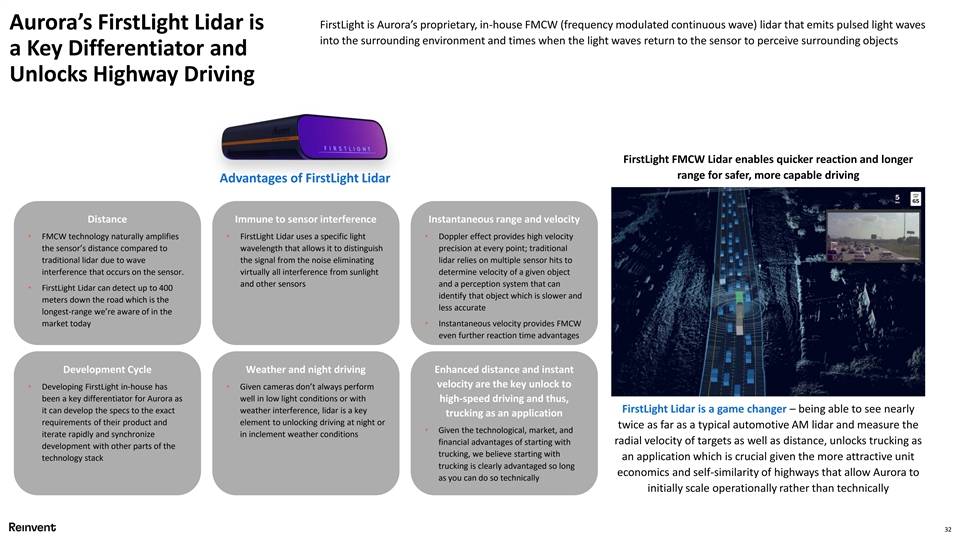
FirstLight is Aurora’s proprietary, in-house FMCW (frequency modulated continuous wave) lidar that emits pulsed light waves Aurora’s FirstLight Lidar is into the surrounding environment and times when the light waves return to the sensor to perceive surrounding objects a Key Differentiator and Unlocks Highway Driving FirstLight FMCW Lidar enables quicker reaction and longer range for safer, more capable driving Advantages of FirstLight Lidar Distance Immune to sensor interference Instantaneous range and velocity • FMCW technology naturally amplifies • FirstLight Lidar uses a specific light • Doppler effect provides high velocity the sensor’s distance compared to wavelength that allows it to distinguish precision at every point; traditional traditional lidar due to wave the signal from the noise eliminating lidar relies on multiple sensor hits to interference that occurs on the sensor. virtually all interference from sunlight determine velocity of a given object and other sensors and a perception system that can • FirstLight Lidar can detect up to 400 identify that object which is slower and meters down the road which is the less accurate longest-range we’re aware of in the market today• Instantaneous velocity provides FMCW even further reaction time advantages Development Cycle Weather and night driving Enhanced distance and instant velocity are the key unlock to • Developing FirstLight in-house has • Given cameras don’t always perform been a key differentiator for Aurora as well in low light conditions or with high-speed driving and thus, it can develop the specs to the exact weather interference, lidar is a key FirstLight Lidar is a game changer – being able to see nearly trucking as an application requirements of their product and element to unlocking driving at night or twice as far as a typical automotive AM lidar and measure the • Given the technological, market, and iterate rapidly and synchronize in inclement weather conditions radial velocity of targets as well as distance, unlocks trucking as financial advantages of starting with development with other parts of the trucking, we believe starting with an application which is crucial given the more attractive unit technology stack trucking is clearly advantaged so long economics and self-similarity of highways that allow Aurora to as you can do so technically initially scale operationally rather than technically 32FirstLight is Aurora’s proprietary, in-house FMCW (frequency modulated continuous wave) lidar that emits pulsed light waves Aurora’s FirstLight Lidar is into the surrounding environment and times when the light waves return to the sensor to perceive surrounding objects a Key Differentiator and Unlocks Highway Driving FirstLight FMCW Lidar enables quicker reaction and longer range for safer, more capable driving Advantages of FirstLight Lidar Distance Immune to sensor interference Instantaneous range and velocity • FMCW technology naturally amplifies • FirstLight Lidar uses a specific light • Doppler effect provides high velocity the sensor’s distance compared to wavelength that allows it to distinguish precision at every point; traditional traditional lidar due to wave the signal from the noise eliminating lidar relies on multiple sensor hits to interference that occurs on the sensor. virtually all interference from sunlight determine velocity of a given object and other sensors and a perception system that can • FirstLight Lidar can detect up to 400 identify that object which is slower and meters down the road which is the less accurate longest-range we’re aware of in the market today• Instantaneous velocity provides FMCW even further reaction time advantages Development Cycle Weather and night driving Enhanced distance and instant velocity are the key unlock to • Developing FirstLight in-house has • Given cameras don’t always perform been a key differentiator for Aurora as well in low light conditions or with high-speed driving and thus, it can develop the specs to the exact weather interference, lidar is a key FirstLight Lidar is a game changer – being able to see nearly trucking as an application requirements of their product and element to unlocking driving at night or twice as far as a typical automotive AM lidar and measure the • Given the technological, market, and iterate rapidly and synchronize in inclement weather conditions radial velocity of targets as well as distance, unlocks trucking as financial advantages of starting with development with other parts of the trucking, we believe starting with an application which is crucial given the more attractive unit technology stack trucking is clearly advantaged so long economics and self-similarity of highways that allow Aurora to as you can do so technically initially scale operationally rather than technically 32
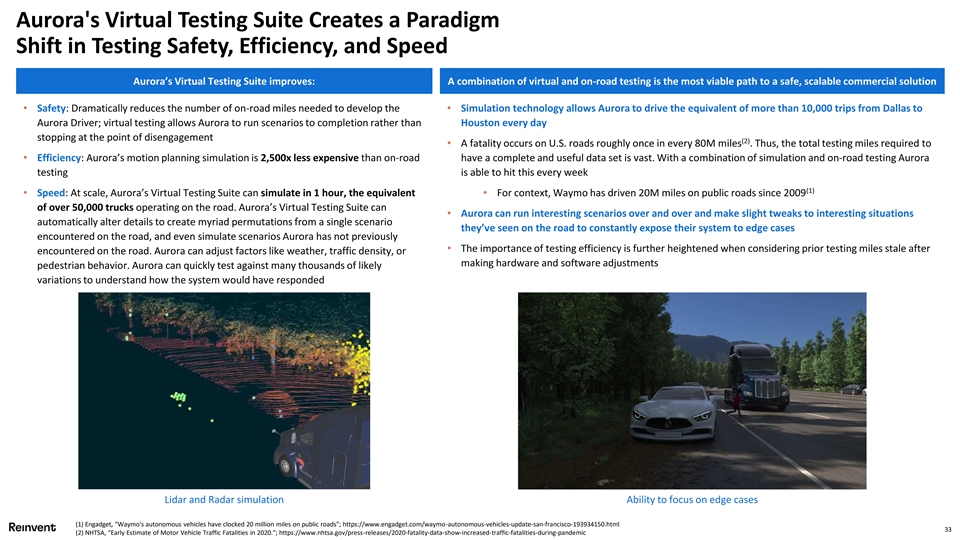
Aurora's Virtual Testing Suite Creates a Paradigm Shift in Testing Safety, Efficiency, and Speed Aurora’s Virtual Testing Suite improves: A combination of virtual and on-road testing is the most viable path to a safe, scalable commercial solution • Safety: Dramatically reduces the number of on-road miles needed to develop the • Simulation technology allows Aurora to drive the equivalent of more than 10,000 trips from Dallas to Aurora Driver; virtual testing allows Aurora to run scenarios to completion rather than Houston every day stopping at the point of disengagement (2) • A fatality occurs on U.S. roads roughly once in every 80M miles . Thus, the total testing miles required to • Efficiency: Aurora’s motion planning simulation is 2,500x less expensive than on-road have a complete and useful data set is vast. With a combination of simulation and on-road testing Aurora testing is able to hit this every week (1) • Speed: At scale, Aurora’s Virtual Testing Suite can simulate in 1 hour, the equivalent • For context, Waymo has driven 20M miles on public roads since 2009 of over 50,000 trucks operating on the road. Aurora’s Virtual Testing Suite can • Aurora can run interesting scenarios over and over and make slight tweaks to interesting situations automatically alter details to create myriad permutations from a single scenario they’ve seen on the road to constantly expose their system to edge cases encountered on the road, and even simulate scenarios Aurora has not previously • The importance of testing efficiency is further heightened when considering prior testing miles stale after encountered on the road. Aurora can adjust factors like weather, traffic density, or making hardware and software adjustments pedestrian behavior. Aurora can quickly test against many thousands of likely variations to understand how the system would have responded Lidar and Radar simulation Ability to focus on edge cases (1) Engadget, “Waymo's autonomous vehicles have clocked 20 million miles on public roads”; https://www.engadget.com/waymo-autonomous-vehicles-update-san-francisco-193934150.html 33 (2) NHTSA, “Early Estimate of Motor Vehicle Traffic Fatalities in 2020.”; https://www.nhtsa.gov/press-releases/2020-fatality-data-show-increased-traffic-fatalities-during-pandemicAurora's Virtual Testing Suite Creates a Paradigm Shift in Testing Safety, Efficiency, and Speed Aurora’s Virtual Testing Suite improves: A combination of virtual and on-road testing is the most viable path to a safe, scalable commercial solution • Safety: Dramatically reduces the number of on-road miles needed to develop the • Simulation technology allows Aurora to drive the equivalent of more than 10,000 trips from Dallas to Aurora Driver; virtual testing allows Aurora to run scenarios to completion rather than Houston every day stopping at the point of disengagement (2) • A fatality occurs on U.S. roads roughly once in every 80M miles . Thus, the total testing miles required to • Efficiency: Aurora’s motion planning simulation is 2,500x less expensive than on-road have a complete and useful data set is vast. With a combination of simulation and on-road testing Aurora testing is able to hit this every week (1) • Speed: At scale, Aurora’s Virtual Testing Suite can simulate in 1 hour, the equivalent • For context, Waymo has driven 20M miles on public roads since 2009 of over 50,000 trucks operating on the road. Aurora’s Virtual Testing Suite can • Aurora can run interesting scenarios over and over and make slight tweaks to interesting situations automatically alter details to create myriad permutations from a single scenario they’ve seen on the road to constantly expose their system to edge cases encountered on the road, and even simulate scenarios Aurora has not previously • The importance of testing efficiency is further heightened when considering prior testing miles stale after encountered on the road. Aurora can adjust factors like weather, traffic density, or making hardware and software adjustments pedestrian behavior. Aurora can quickly test against many thousands of likely variations to understand how the system would have responded Lidar and Radar simulation Ability to focus on edge cases (1) Engadget, “Waymo's autonomous vehicles have clocked 20 million miles on public roads”; https://www.engadget.com/waymo-autonomous-vehicles-update-san-francisco-193934150.html 33 (2) NHTSA, “Early Estimate of Motor Vehicle Traffic Fatalities in 2020.”; https://www.nhtsa.gov/press-releases/2020-fatality-data-show-increased-traffic-fatalities-during-pandemic

Aurora Atlas: Aurora Atlas Map Shard Commercially Scalable Mapping Commercially relevant self-driving demands HD maps • The 1.0 approach to mapping – large, feature-heavy, globally consistent map – quickly out of date, slow, and expensive to fix • The Aurora 2.0 approach – sharded, lightweight, locally consistent maps – highly accurate, scalable; automated creation with human QA; rapid real-time updates are scalable and safer • Building shards takes minutes and creates ability to swap out shards in live-deployed maps • Vehicles on the road will provide latest data to update map shards • The Aurora Atlas is just one example of the 2.0 approach and investment Aurora has taken to build a commercially scalable product based on experience. While a modular map may seem like an obvious choice, many competitors haven’t built the more complicated data structure required to enable mapping in this way Aurora Atlas architecture: • The Aurora Driver will automatically ingest and send in mapping updates as it • Provides accuracy where it is needed most: near the vehicle drives on the road. As the fleet of Aurora Drivers grow, Aurora Atlas will benefit as • Unlocks rapid (near-real-time) updates well • Enables efficient maintenance so that map data can always be up-to-date • Shards data so that map building can be massively parallelized 34
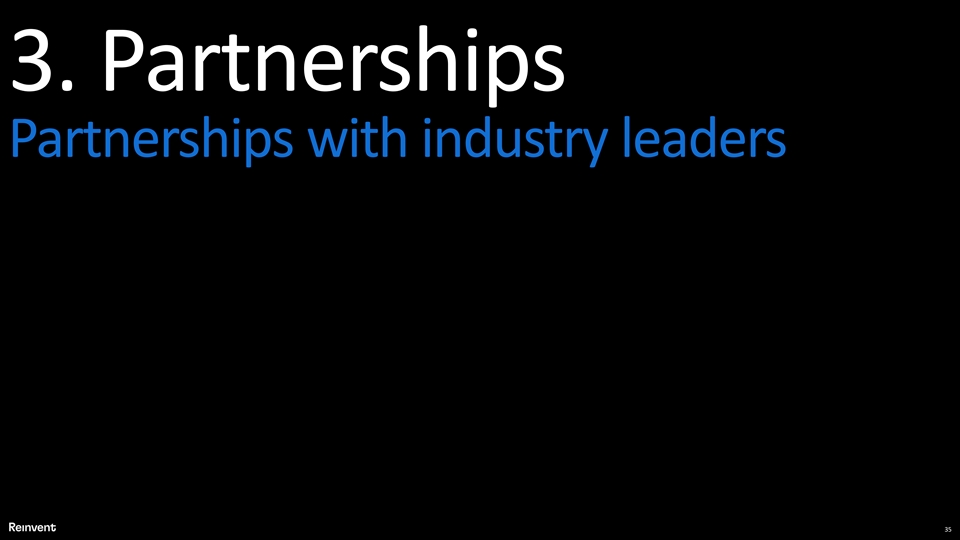
3. Partnerships Partnerships with industry leaders 353. Partnerships Partnerships with industry leaders 35
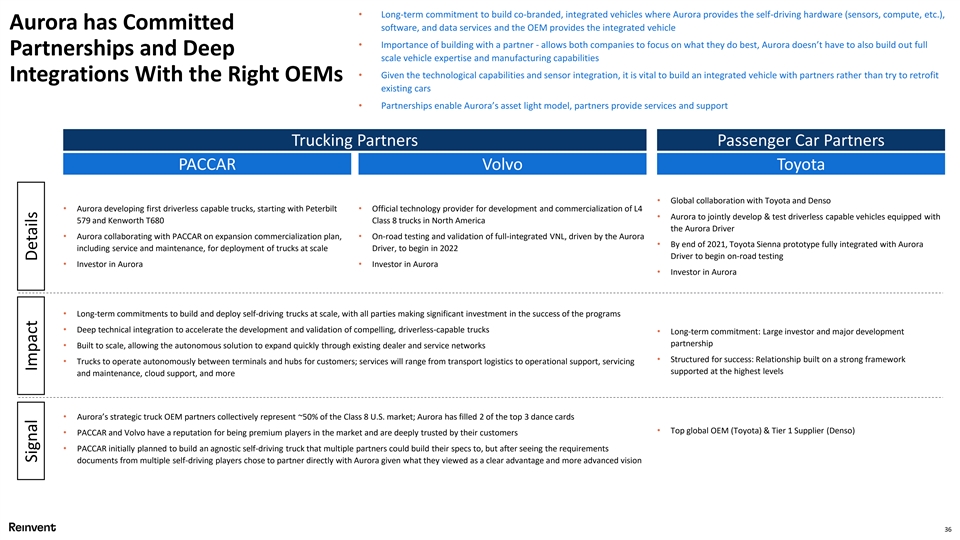
• Long-term commitment to build co-branded, integrated vehicles where Aurora provides the self-driving hardware (sensors, compute, etc.), Aurora has Committed software, and data services and the OEM provides the integrated vehicle • Importance of building with a partner - allows both companies to focus on what they do best, Aurora doesn’t have to also build out full Partnerships and Deep scale vehicle expertise and manufacturing capabilities • Given the technological capabilities and sensor integration, it is vital to build an integrated vehicle with partners rather than try to retrofit Integrations With the Right OEMs existing cars • Partnerships enable Aurora’s asset light model, partners provide services and support Trucking Partners Passenger Car Partners PACCAR Volvo Toyota • Global collaboration with Toyota and Denso • Aurora developing first driverless capable trucks, starting with Peterbilt • Official technology provider for development and commercialization of L4 • Aurora to jointly develop & test driverless capable vehicles equipped with 579 and Kenworth T680 Class 8 trucks in North America the Aurora Driver • Aurora collaborating with PACCAR on expansion commercialization plan, • On-road testing and validation of full-integrated VNL, driven by the Aurora • By end of 2021, Toyota Sienna prototype fully integrated with Aurora including service and maintenance, for deployment of trucks at scale Driver, to begin in 2022 Driver to begin on-road testing • Investor in Aurora• Investor in Aurora • Investor in Aurora • Long-term commitments to build and deploy self-driving trucks at scale, with all parties making significant investment in the success of the programs • Deep technical integration to accelerate the development and validation of compelling, driverless-capable trucks • Long-term commitment: Large investor and major development partnership • Built to scale, allowing the autonomous solution to expand quickly through existing dealer and service networks • Structured for success: Relationship built on a strong framework • Trucks to operate autonomously between terminals and hubs for customers; services will range from transport logistics to operational support, servicing supported at the highest levels and maintenance, cloud support, and more • Aurora’s strategic truck OEM partners collectively represent ~50% of the Class 8 U.S. market; Aurora has filled 2 of the top 3 dance cards • Top global OEM (Toyota) & Tier 1 Supplier (Denso) • PACCAR and Volvo have a reputation for being premium players in the market and are deeply trusted by their customers • PACCAR initially planned to build an agnostic self-driving truck that multiple partners could build their specs to, but after seeing the requirements documents from multiple self-driving players chose to partner directly with Aurora given what they viewed as a clear advantage and more advanced vision 36 Signal Impact Details• Long-term commitment to build co-branded, integrated vehicles where Aurora provides the self-driving hardware (sensors, compute, etc.), Aurora has Committed software, and data services and the OEM provides the integrated vehicle • Importance of building with a partner - allows both companies to focus on what they do best, Aurora doesn’t have to also build out full Partnerships and Deep scale vehicle expertise and manufacturing capabilities • Given the technological capabilities and sensor integration, it is vital to build an integrated vehicle with partners rather than try to retrofit Integrations With the Right OEMs existing cars • Partnerships enable Aurora’s asset light model, partners provide services and support Trucking Partners Passenger Car Partners PACCAR Volvo Toyota • Global collaboration with Toyota and Denso • Aurora developing first driverless capable trucks, starting with Peterbilt • Official technology provider for development and commercialization of L4 • Aurora to jointly develop & test driverless capable vehicles equipped with 579 and Kenworth T680 Class 8 trucks in North America the Aurora Driver • Aurora collaborating with PACCAR on expansion commercialization plan, • On-road testing and validation of full-integrated VNL, driven by the Aurora • By end of 2021, Toyota Sienna prototype fully integrated with Aurora including service and maintenance, for deployment of trucks at scale Driver, to begin in 2022 Driver to begin on-road testing • Investor in Aurora• Investor in Aurora • Investor in Aurora • Long-term commitments to build and deploy self-driving trucks at scale, with all parties making significant investment in the success of the programs • Deep technical integration to accelerate the development and validation of compelling, driverless-capable trucks • Long-term commitment: Large investor and major development partnership • Built to scale, allowing the autonomous solution to expand quickly through existing dealer and service networks • Structured for success: Relationship built on a strong framework • Trucks to operate autonomously between terminals and hubs for customers; services will range from transport logistics to operational support, servicing supported at the highest levels and maintenance, cloud support, and more • Aurora’s strategic truck OEM partners collectively represent ~50% of the Class 8 U.S. market; Aurora has filled 2 of the top 3 dance cards • Top global OEM (Toyota) & Tier 1 Supplier (Denso) • PACCAR and Volvo have a reputation for being premium players in the market and are deeply trusted by their customers • PACCAR initially planned to build an agnostic self-driving truck that multiple partners could build their specs to, but after seeing the requirements documents from multiple self-driving players chose to partner directly with Aurora given what they viewed as a clear advantage and more advanced vision 36 Signal Impact Details
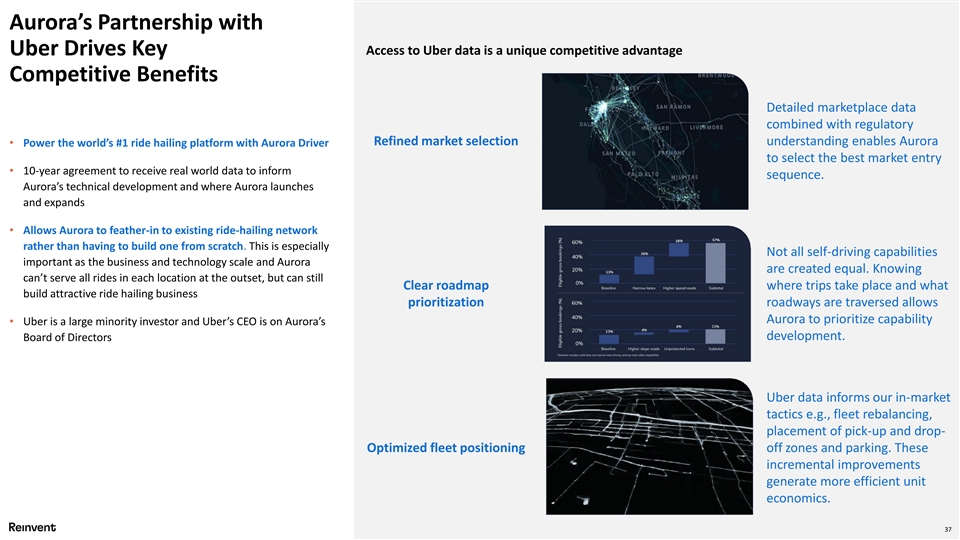
Aurora’s Partnership with Access to Uber data is a unique competitive advantage Uber Drives Key Competitive Benefits Detailed marketplace data combined with regulatory Refined market selection understanding enables Aurora • Power the world’s #1 ride hailing platform with Aurora Driver to select the best market entry • 10-year agreement to receive real world data to inform sequence. Aurora’s technical development and where Aurora launches and expands • Allows Aurora to feather-in to existing ride-hailing network rather than having to build one from scratch. This is especially Not all self-driving capabilities important as the business and technology scale and Aurora are created equal. Knowing can’t serve all rides in each location at the outset, but can still Clear roadmap where trips take place and what build attractive ride hailing business prioritization roadways are traversed allows Aurora to prioritize capability • Uber is a large minority investor and Uber’s CEO is on Aurora’s development. Board of Directors Uber data informs our in-market tactics e.g., fleet rebalancing, placement of pick-up and drop- Optimized fleet positioning off zones and parking. These incremental improvements generate more efficient unit economics. 37Aurora’s Partnership with Access to Uber data is a unique competitive advantage Uber Drives Key Competitive Benefits Detailed marketplace data combined with regulatory Refined market selection understanding enables Aurora • Power the world’s #1 ride hailing platform with Aurora Driver to select the best market entry • 10-year agreement to receive real world data to inform sequence. Aurora’s technical development and where Aurora launches and expands • Allows Aurora to feather-in to existing ride-hailing network rather than having to build one from scratch. This is especially Not all self-driving capabilities important as the business and technology scale and Aurora are created equal. Knowing can’t serve all rides in each location at the outset, but can still Clear roadmap where trips take place and what build attractive ride hailing business prioritization roadways are traversed allows Aurora to prioritize capability • Uber is a large minority investor and Uber’s CEO is on Aurora’s development. Board of Directors Uber data informs our in-market tactics e.g., fleet rebalancing, placement of pick-up and drop- Optimized fleet positioning off zones and parking. These incremental improvements generate more efficient unit economics. 37

Partnership Approach is a Strategic Advantage • Co-development with OEMs is a better path than attempting to be a universal plug-and-play • Given the complexity of the problems that self-driving vehicles need to solve, deep integration between hardware and software throughout the development process is vital • To build a performant system that can handle all the requisite edge cases, one-size-fits-all isn’t good enough • Co-development enables more efficient development cycles and faster time to market • Building a safety case together with OEMs requires collaboration and requires accommodations to integrate the automated driver to the vehicle • Positioning, integration, and cleaning of sensors; integration with driving systems; planning software tied to vehicle specs and expected wind loading, turn radius, etc. • Aurora’s thoughtful and deliberate foundational design and architecture allow for a common core that is capable of spanning vehicle types. From there, integrating the Aurora Driver to specific vehicles requires collaborative and nuanced design. Manufacturing decisions benefit immensely from a tight OEM partnership and co-development efforts 38Partnership Approach is a Strategic Advantage • Co-development with OEMs is a better path than attempting to be a universal plug-and-play • Given the complexity of the problems that self-driving vehicles need to solve, deep integration between hardware and software throughout the development process is vital • To build a performant system that can handle all the requisite edge cases, one-size-fits-all isn’t good enough • Co-development enables more efficient development cycles and faster time to market • Building a safety case together with OEMs requires collaboration and requires accommodations to integrate the automated driver to the vehicle • Positioning, integration, and cleaning of sensors; integration with driving systems; planning software tied to vehicle specs and expected wind loading, turn radius, etc. • Aurora’s thoughtful and deliberate foundational design and architecture allow for a common core that is capable of spanning vehicle types. From there, integrating the Aurora Driver to specific vehicles requires collaborative and nuanced design. Manufacturing decisions benefit immensely from a tight OEM partnership and co-development efforts 38

Signal of Leading Partners Choosing Aurora Aurora Ecosystem • Aurora’s partnerships with PACCAR and Volvo Group collectively represent ~50% of the Class 8 U.S. market, the largest global ride hailing network with Uber, and the #1 passenger vehicle manufacturer by volume globally with Toyota • Partnerships with the leaders in each OEM category is a key competitive advantage for Aurora that we expect to compound as relationships deepen and tighter development cycles lead to compounding technological advancements PACCAR and Volvo produce ~50% of Class 8 U.S. Trucks • OEMs are best suited to understand the importance of deeply integrated solutions for critical safety features, the signal Toyota is the #1 value of who they are partnering with is immense passenger vehicle manufacturer by volume • OEM relationships with fleets are deep and powerful. OEMs globally stamp of approval on an autonomous partner will be vital • There are 4 major trucking OEMs in the U.S. and Aurora has partnership agreements with two that represent ~50% of Class 8 trucks in the U.S. • Individual fleet operators will not have the expertise to judge the technology themselves, and are going to have to rely on their trust in the OEMs 39Signal of Leading Partners Choosing Aurora Aurora Ecosystem • Aurora’s partnerships with PACCAR and Volvo Group collectively represent ~50% of the Class 8 U.S. market, the largest global ride hailing network with Uber, and the #1 passenger vehicle manufacturer by volume globally with Toyota • Partnerships with the leaders in each OEM category is a key competitive advantage for Aurora that we expect to compound as relationships deepen and tighter development cycles lead to compounding technological advancements PACCAR and Volvo produce ~50% of Class 8 U.S. Trucks • OEMs are best suited to understand the importance of deeply integrated solutions for critical safety features, the signal Toyota is the #1 value of who they are partnering with is immense passenger vehicle manufacturer by volume • OEM relationships with fleets are deep and powerful. OEMs globally stamp of approval on an autonomous partner will be vital • There are 4 major trucking OEMs in the U.S. and Aurora has partnership agreements with two that represent ~50% of Class 8 trucks in the U.S. • Individual fleet operators will not have the expertise to judge the technology themselves, and are going to have to rely on their trust in the OEMs 39
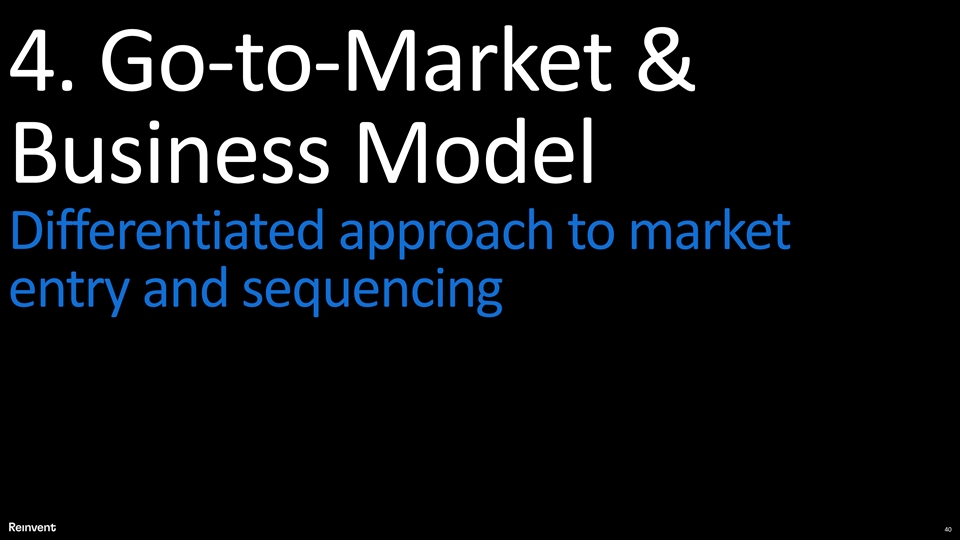
4. Go-to-Market & Business Model Differentiated approach to market entry and sequencing 404. Go-to-Market & Business Model Differentiated approach to market entry and sequencing 40
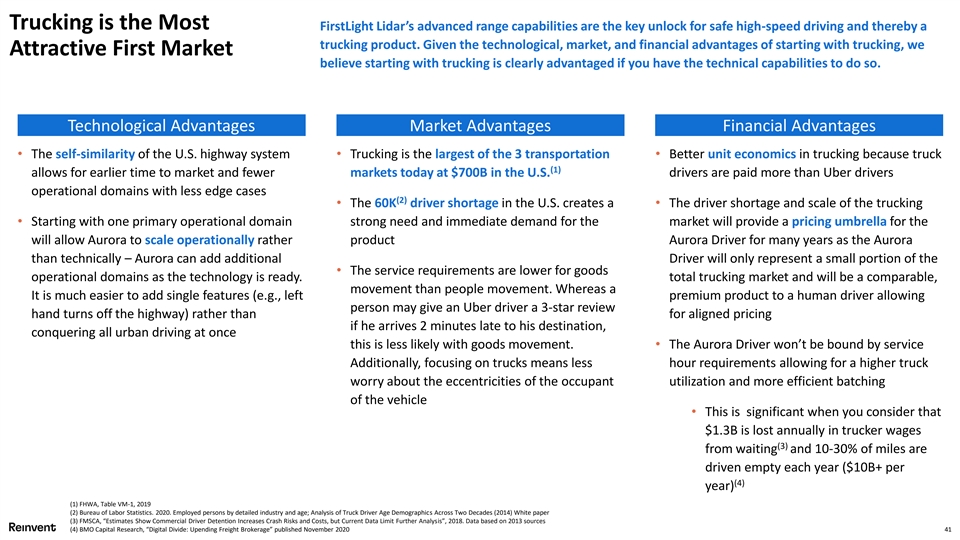
Trucking is the Most FirstLight Lidar’s advanced range capabilities are the key unlock for safe high-speed driving and thereby a trucking product. Given the technological, market, and financial advantages of starting with trucking, we Attractive First Market believe starting with trucking is clearly advantaged if you have the technical capabilities to do so. Technological Advantages Market Advantages Financial Advantages • The self-similarity of the U.S. highway system • Trucking is the largest of the 3 transportation • Better unit economics in trucking because truck (1) allows for earlier time to market and fewer markets today at $700B in the U.S. drivers are paid more than Uber drivers operational domains with less edge cases (2) • The 60K driver shortage in the U.S. creates a • The driver shortage and scale of the trucking • Starting with one primary operational domain strong need and immediate demand for the market will provide a pricing umbrella for the will allow Aurora to scale operationally rather product Aurora Driver for many years as the Aurora than technically – Aurora can add additional Driver will only represent a small portion of the • The service requirements are lower for goods operational domains as the technology is ready. total trucking market and will be a comparable, movement than people movement. Whereas a It is much easier to add single features (e.g., left premium product to a human driver allowing person may give an Uber driver a 3-star review hand turns off the highway) rather than for aligned pricing if he arrives 2 minutes late to his destination, conquering all urban driving at once this is less likely with goods movement. • The Aurora Driver won’t be bound by service Additionally, focusing on trucks means less hour requirements allowing for a higher truck worry about the eccentricities of the occupant utilization and more efficient batching of the vehicle • This is significant when you consider that $1.3B is lost annually in trucker wages (3) from waiting and 10-30% of miles are driven empty each year ($10B+ per (4) year) (1) FHWA, Table VM-1, 2019 (2) Bureau of Labor Statistics. 2020. Employed persons by detailed industry and age; Analysis of Truck Driver Age Demographics Across Two Decades (2014) White paper (3) FMSCA, “Estimates Show Commercial Driver Detention Increases Crash Risks and Costs, but Current Data Limit Further Analysis”, 2018. Data based on 2013 sources (4) BMO Capital Research, “Digital Divide: Upending Freight Brokerage” published November 2020 41Trucking is the Most FirstLight Lidar’s advanced range capabilities are the key unlock for safe high-speed driving and thereby a trucking product. Given the technological, market, and financial advantages of starting with trucking, we Attractive First Market believe starting with trucking is clearly advantaged if you have the technical capabilities to do so. Technological Advantages Market Advantages Financial Advantages • The self-similarity of the U.S. highway system • Trucking is the largest of the 3 transportation • Better unit economics in trucking because truck (1) allows for earlier time to market and fewer markets today at $700B in the U.S. drivers are paid more than Uber drivers operational domains with less edge cases (2) • The 60K driver shortage in the U.S. creates a • The driver shortage and scale of the trucking • Starting with one primary operational domain strong need and immediate demand for the market will provide a pricing umbrella for the will allow Aurora to scale operationally rather product Aurora Driver for many years as the Aurora than technically – Aurora can add additional Driver will only represent a small portion of the • The service requirements are lower for goods operational domains as the technology is ready. total trucking market and will be a comparable, movement than people movement. Whereas a It is much easier to add single features (e.g., left premium product to a human driver allowing person may give an Uber driver a 3-star review hand turns off the highway) rather than for aligned pricing if he arrives 2 minutes late to his destination, conquering all urban driving at once this is less likely with goods movement. • The Aurora Driver won’t be bound by service Additionally, focusing on trucks means less hour requirements allowing for a higher truck worry about the eccentricities of the occupant utilization and more efficient batching of the vehicle • This is significant when you consider that $1.3B is lost annually in trucker wages (3) from waiting and 10-30% of miles are driven empty each year ($10B+ per (4) year) (1) FHWA, Table VM-1, 2019 (2) Bureau of Labor Statistics. 2020. Employed persons by detailed industry and age; Analysis of Truck Driver Age Demographics Across Two Decades (2014) White paper (3) FMSCA, “Estimates Show Commercial Driver Detention Increases Crash Risks and Costs, but Current Data Limit Further Analysis”, 2018. Data based on 2013 sources (4) BMO Capital Research, “Digital Divide: Upending Freight Brokerage” published November 2020 41
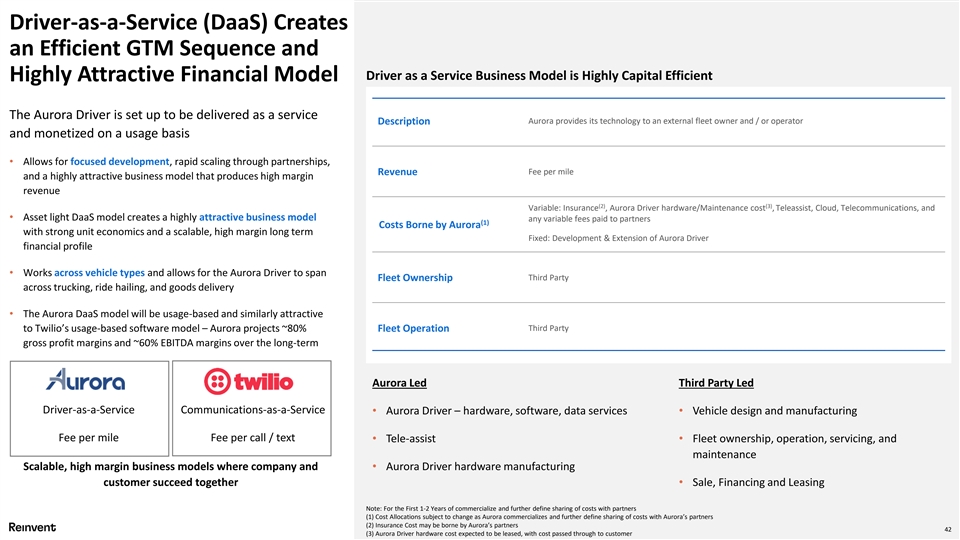
Driver-as-a-Service (DaaS) Creates an Efficient GTM Sequence and Driver as a Service Business Model is Highly Capital Efficient Highly Attractive Financial Model The Aurora Driver is set up to be delivered as a service Aurora provides its technology to an external fleet owner and / or operator Description and monetized on a usage basis • Allows for focused development, rapid scaling through partnerships, Revenue Fee per mile and a highly attractive business model that produces high margin revenue (2) (3) Variable: Insurance , Aurora Driver hardware/Maintenance cost , Teleassist, Cloud, Telecommunications, and • Asset light DaaS model creates a highly attractive business model any variable fees paid to partners (1) Costs Borne by Aurora with strong unit economics and a scalable, high margin long term Fixed: Development & Extension of Aurora Driver financial profile • Works across vehicle types and allows for the Aurora Driver to span Third Party Fleet Ownership across trucking, ride hailing, and goods delivery • The Aurora DaaS model will be usage-based and similarly attractive Third Party to Twilio’s usage-based software model – Aurora projects ~80% Fleet Operation gross profit margins and ~60% EBITDA margins over the long-term Aurora Led Third Party Led Driver-as-a-Service Communications-as-a-Service • Aurora Driver – hardware, software, data services• Vehicle design and manufacturing Fee per mile Fee per call / text • Tele-assist• Fleet ownership, operation, servicing, and maintenance Scalable, high margin business models where company and • Aurora Driver hardware manufacturing customer succeed together• Sale, Financing and Leasing Note: For the First 1-2 Years of commercialize and further define sharing of costs with partners (1) Cost Allocations subject to change as Aurora commercializes and further define sharing of costs with Aurora’s partners (2) Insurance Cost may be borne by Aurora’s partners 42 (3) Aurora Driver hardware cost expected to be leased, with cost passed through to customer
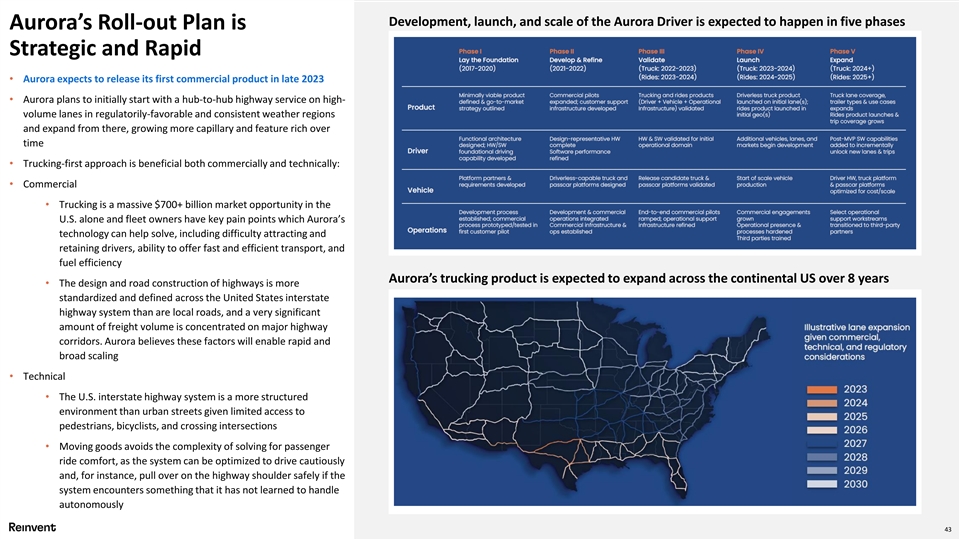
Development, launch, and scale of the Aurora Driver is expected to happen in five phases Aurora’s Roll-out Plan is Strategic and Rapid • Aurora expects to release its first commercial product in late 2023 • Aurora plans to initially start with a hub-to-hub highway service on high- volume lanes in regulatorily-favorable and consistent weather regions and expand from there, growing more capillary and feature rich over time • Trucking-first approach is beneficial both commercially and technically: • Commercial • Trucking is a massive $700+ billion market opportunity in the U.S. alone and fleet owners have key pain points which Aurora’s technology can help solve, including difficulty attracting and retaining drivers, ability to offer fast and efficient transport, and fuel efficiency Aurora’s trucking product is expected to expand across the continental US over 8 years • The design and road construction of highways is more standardized and defined across the United States interstate highway system than are local roads, and a very significant amount of freight volume is concentrated on major highway corridors. Aurora believes these factors will enable rapid and broad scaling • Technical • The U.S. interstate highway system is a more structured environment than urban streets given limited access to pedestrians, bicyclists, and crossing intersections • Moving goods avoids the complexity of solving for passenger ride comfort, as the system can be optimized to drive cautiously and, for instance, pull over on the highway shoulder safely if the system encounters something that it has not learned to handle autonomously 43Development, launch, and scale of the Aurora Driver is expected to happen in five phases Aurora’s Roll-out Plan is Strategic and Rapid • Aurora expects to release its first commercial product in late 2023 • Aurora plans to initially start with a hub-to-hub highway service on high- volume lanes in regulatorily-favorable and consistent weather regions and expand from there, growing more capillary and feature rich over time • Trucking-first approach is beneficial both commercially and technically: • Commercial • Trucking is a massive $700+ billion market opportunity in the U.S. alone and fleet owners have key pain points which Aurora’s technology can help solve, including difficulty attracting and retaining drivers, ability to offer fast and efficient transport, and fuel efficiency Aurora’s trucking product is expected to expand across the continental US over 8 years • The design and road construction of highways is more standardized and defined across the United States interstate highway system than are local roads, and a very significant amount of freight volume is concentrated on major highway corridors. Aurora believes these factors will enable rapid and broad scaling • Technical • The U.S. interstate highway system is a more structured environment than urban streets given limited access to pedestrians, bicyclists, and crossing intersections • Moving goods avoids the complexity of solving for passenger ride comfort, as the system can be optimized to drive cautiously and, for instance, pull over on the highway shoulder safely if the system encounters something that it has not learned to handle autonomously 43
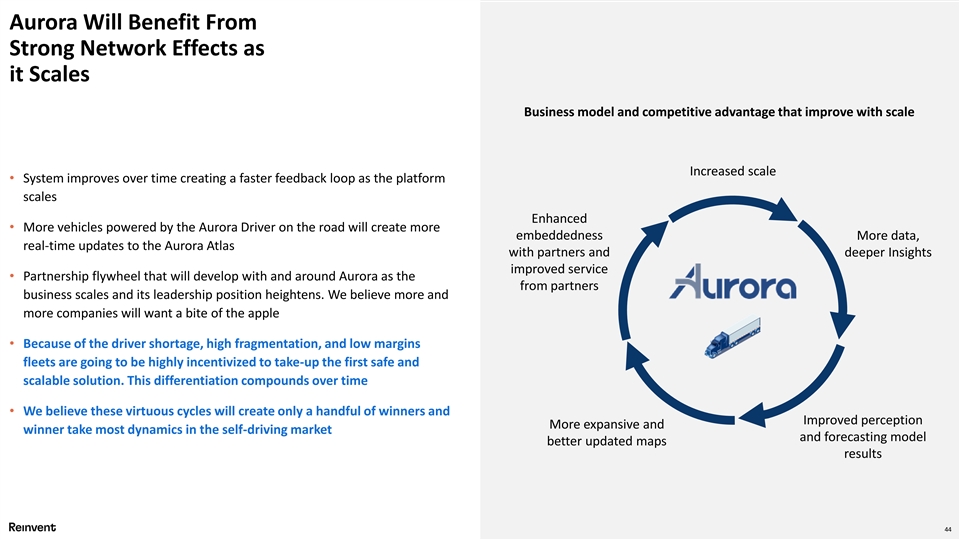
Aurora Will Benefit From Strong Network Effects as it Scales Business model and competitive advantage that improve with scale Increased scale • System improves over time creating a faster feedback loop as the platform scales Enhanced • More vehicles powered by the Aurora Driver on the road will create more embeddedness More data, real-time updates to the Aurora Atlas with partners and deeper Insights improved service • Partnership flywheel that will develop with and around Aurora as the from partners business scales and its leadership position heightens. We believe more and more companies will want a bite of the apple • Because of the driver shortage, high fragmentation, and low margins fleets are going to be highly incentivized to take-up the first safe and scalable solution. This differentiation compounds over time • We believe these virtuous cycles will create only a handful of winners and Improved perception More expansive and winner take most dynamics in the self-driving market and forecasting model better updated maps results 44Aurora Will Benefit From Strong Network Effects as it Scales Business model and competitive advantage that improve with scale Increased scale • System improves over time creating a faster feedback loop as the platform scales Enhanced • More vehicles powered by the Aurora Driver on the road will create more embeddedness More data, real-time updates to the Aurora Atlas with partners and deeper Insights improved service • Partnership flywheel that will develop with and around Aurora as the from partners business scales and its leadership position heightens. We believe more and more companies will want a bite of the apple • Because of the driver shortage, high fragmentation, and low margins fleets are going to be highly incentivized to take-up the first safe and scalable solution. This differentiation compounds over time • We believe these virtuous cycles will create only a handful of winners and Improved perception More expansive and winner take most dynamics in the self-driving market and forecasting model better updated maps results 44
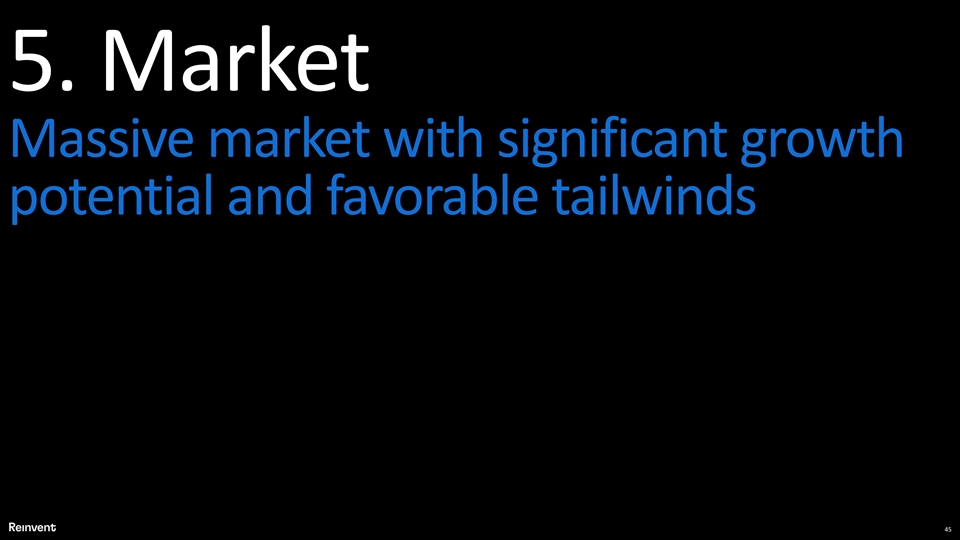
5. Market Massive market with significant growth potential and favorable tailwinds 455. Market Massive market with significant growth potential and favorable tailwinds 45

Aurora Expects to Address the Entirety of an Enormous Transportation Market, Starting in the U.S. $700bn $4tn (1) (4) Trucking market (U.S.) Trucking Market (Global) $35bn $1tn / $5tn (2) (5) Ride-hailing market (U.S.) Personal mobility TAM (U.S. / Global) $100bn $400bn (3) Local goods delivery market (U.S.) Local goods delivery market (6) (Global) (1) ) FHWA, Table VM-1, 2019 (2) FHWA, Table HM-71, 2019; FHWA, Table VM-1, 2019 (3) Pitney Bowes, Parcel Shipping Index Report, 2020; analysis of public filings from e-delivery companies; Global derived from US share of global GDP.(4) Armstrong & Associates, Global Third Party Logistics, 2019 (5) RAND, The Future of Driving in Developing Countries; Autocosts.info World Statistics; AAA, Your Driving Costs; IRS; Bureau of Transportation Statistics, Household Spending Survey, 2019 46 (6) Derived from US share of global GDPAurora Expects to Address the Entirety of an Enormous Transportation Market, Starting in the U.S. $700bn $4tn (1) (4) Trucking market (U.S.) Trucking Market (Global) $35bn $1tn / $5tn (2) (5) Ride-hailing market (U.S.) Personal mobility TAM (U.S. / Global) $100bn $400bn (3) Local goods delivery market (U.S.) Local goods delivery market (6) (Global) (1) ) FHWA, Table VM-1, 2019 (2) FHWA, Table HM-71, 2019; FHWA, Table VM-1, 2019 (3) Pitney Bowes, Parcel Shipping Index Report, 2020; analysis of public filings from e-delivery companies; Global derived from US share of global GDP.(4) Armstrong & Associates, Global Third Party Logistics, 2019 (5) RAND, The Future of Driving in Developing Countries; Autocosts.info World Statistics; AAA, Your Driving Costs; IRS; Bureau of Transportation Statistics, Household Spending Survey, 2019 46 (6) Derived from US share of global GDP
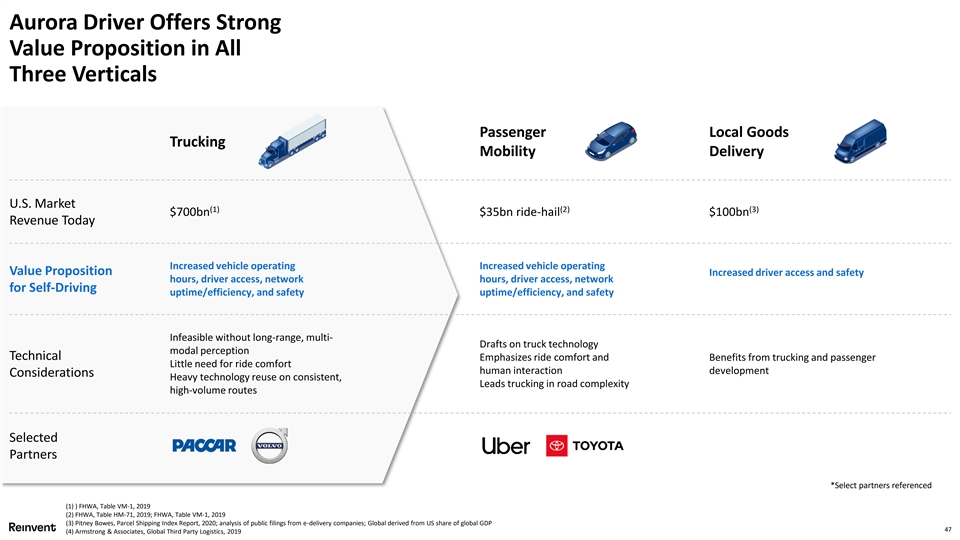
Aurora Driver Offers Strong Value Proposition in All Three Verticals Passenger Local Goods Trucking Mobility Delivery U.S. Market (1) (2) (3) $700bn $35bn ride-hail $100bn Revenue Today Increased vehicle operating Increased vehicle operating Value Proposition Increased driver access and safety hours, driver access, network hours, driver access, network for Self-Driving uptime/efficiency, and safety uptime/efficiency, and safety Infeasible without long-range, multi- Drafts on truck technology modal perception Technical Emphasizes ride comfort and Benefits from trucking and passenger Little need for ride comfort human interaction development Considerations Heavy technology reuse on consistent, Leads trucking in road complexity high-volume routes Selected Partners *Select partners referenced (1) ) FHWA, Table VM-1, 2019 (2) FHWA, Table HM-71, 2019; FHWA, Table VM-1, 2019 (3) Pitney Bowes, Parcel Shipping Index Report, 2020; analysis of public filings from e-delivery companies; Global derived from US share of global GDP 47 (4) Armstrong & Associates, Global Third Party Logistics, 2019Aurora Driver Offers Strong Value Proposition in All Three Verticals Passenger Local Goods Trucking Mobility Delivery U.S. Market (1) (2) (3) $700bn $35bn ride-hail $100bn Revenue Today Increased vehicle operating Increased vehicle operating Value Proposition Increased driver access and safety hours, driver access, network hours, driver access, network for Self-Driving uptime/efficiency, and safety uptime/efficiency, and safety Infeasible without long-range, multi- Drafts on truck technology modal perception Technical Emphasizes ride comfort and Benefits from trucking and passenger Little need for ride comfort human interaction development Considerations Heavy technology reuse on consistent, Leads trucking in road complexity high-volume routes Selected Partners *Select partners referenced (1) ) FHWA, Table VM-1, 2019 (2) FHWA, Table HM-71, 2019; FHWA, Table VM-1, 2019 (3) Pitney Bowes, Parcel Shipping Index Report, 2020; analysis of public filings from e-delivery companies; Global derived from US share of global GDP 47 (4) Armstrong & Associates, Global Third Party Logistics, 2019
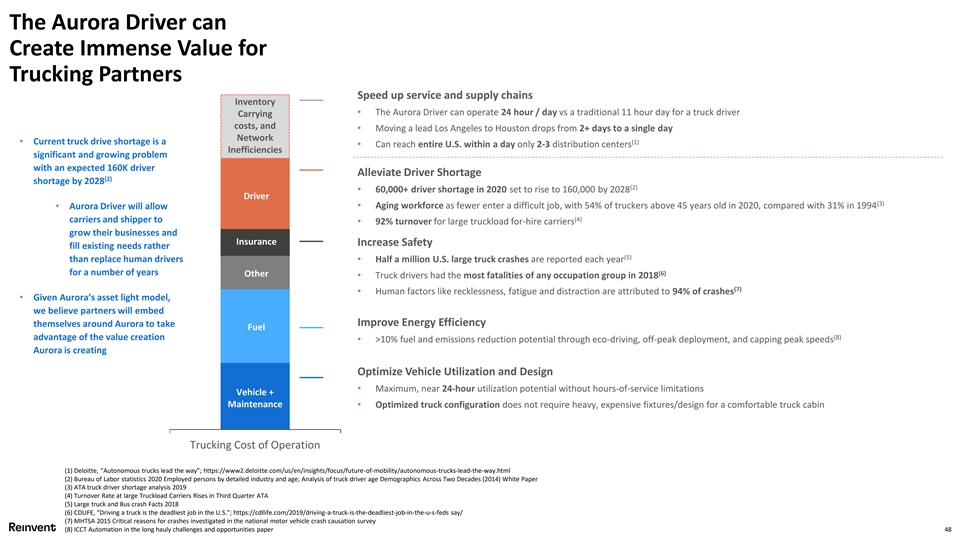
The Aurora Driver can Create Immense Value for Trucking Partners Speed up service and supply chains Inventory • The Aurora Driver can operate 24 hour / day vs a traditional 11 hour day for a truck driver Carrying costs, and • Moving a lead Los Angeles to Houston drops from 2+ days to a single day Network (1) • Current truck drive shortage is a • Can reach entire U.S. within a day only 2-3 distribution centers Inefficiencies significant and growing problem with an expected 160K driver Alleviate Driver Shortage (2) shortage by 2028 (2) • 60,000+ driver shortage in 2020 set to rise to 160,000 by 2028 Driver (3) • Aurora Driver will allow • Aging workforce as fewer enter a difficult job, with 54% of truckers above 45 years old in 2020, compared with 31% in 1994 (4) carriers and shipper to • 92% turnover for large truckload for-hire carriers grow their businesses and Insurance Increase Safety fill existing needs rather (5) than replace human drivers • Half a million U.S. large truck crashes are reported each year for a number of years (6) Other • Truck drivers had the most fatalities of any occupation group in 2018 (7) • Human factors like recklessness, fatigue and distraction are attributed to 94% of crashes • Given Aurora’s asset light model, we believe partners will embed Improve Energy Efficiency themselves around Aurora to take Fuel (8) advantage of the value creation • >10% fuel and emissions reduction potential through eco-driving, off-peak deployment, and capping peak speeds Aurora is creating Optimize Vehicle Utilization and Design • Maximum, near 24-hour utilization potential without hours-of-service limitations Vehicle + Maintenance • Optimized truck configuration does not require heavy, expensive fixtures/design for a comfortable truck cabin Trucking Cost of Operation (1) Deloitte, “Autonomous trucks lead the way”; https://www2.deloitte.com/us/en/insights/focus/future-of-mobility/autonomous-trucks-lead-the-way.html (2) Bureau of Labor statistics 2020 Employed persons by detailed industry and age; Analysis of truck driver age Demographics Across Two Decades (2014) White Paper (3) ATA truck driver shortage analysis 2019 (4) Turnover Rate at large Truckload Carriers Rises in Third Quarter ATA (5) Large truck and Bus crash Facts 2018 (6) CDLIFE, “Driving a truck is the deadliest job in the U.S.”; https://cdllife.com/2019/driving-a-truck-is-the-deadliest-job-in-the-u-s-feds say/ (7) MHTSA 2015 Critical reasons for crashes investigated in the national motor vehicle crash causation survey (8) ICCT Automation in the long hauly challenges and opportunities paper 48
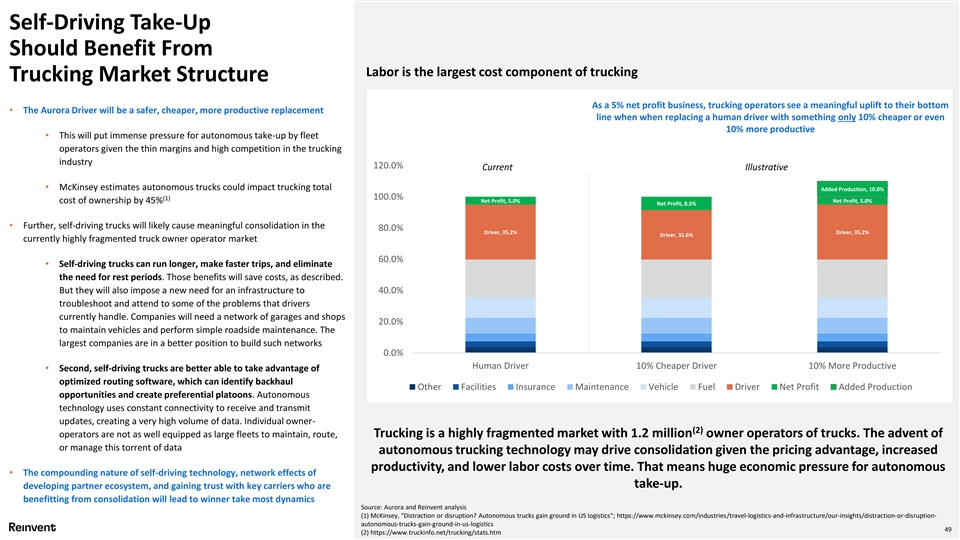
Self-Driving Take-Up Should Benefit From Labor is the largest cost component of trucking Trucking Market Structure As a 5% net profit business, trucking operators see a meaningful uplift to their bottom • The Aurora Driver will be a safer, cheaper, more productive replacement line when when replacing a human driver with something only 10% cheaper or even 10% more productive • This will put immense pressure for autonomous take-up by fleet operators given the thin margins and high competition in the trucking industry 120.0% Current Illustrative • McKinsey estimates autonomous trucks could impact trucking total Added Production, 10.0% (1) 100.0% cost of ownership by 45% Net Profit, 5.0% Net Profit, 5.0% Net Profit, 8.5% • Further, self-driving trucks will likely cause meaningful consolidation in the 80.0% Driver, 35.2% Driver, 35.2% Driver, 31.6% currently highly fragmented truck owner operator market 60.0% • Self-driving trucks can run longer, make faster trips, and eliminate the need for rest periods. Those benefits will save costs, as described. But they will also impose a new need for an infrastructure to 40.0% troubleshoot and attend to some of the problems that drivers currently handle. Companies will need a network of garages and shops 20.0% to maintain vehicles and perform simple roadside maintenance. The largest companies are in a better position to build such networks 0.0% Human Driver 10% Cheaper Driver 10% More Productive • Second, self-driving trucks are better able to take advantage of optimized routing software, which can identify backhaul Other Facilities Insurance Maintenance Vehicle Fuel Driver Net Profit Added Production opportunities and create preferential platoons. Autonomous technology uses constant connectivity to receive and transmit updates, creating a very high volume of data. Individual owner- (2) operators are not as well equipped as large fleets to maintain, route, Trucking is a highly fragmented market with 1.2 million owner operators of trucks. The advent of or manage this torrent of data autonomous trucking technology may drive consolidation given the pricing advantage, increased productivity, and lower labor costs over time. That means huge economic pressure for autonomous • The compounding nature of self-driving technology, network effects of take-up. developing partner ecosystem, and gaining trust with key carriers who are benefitting from consolidation will lead to winner take most dynamics Source: Aurora and Reinvent analysis (1) McKinsey, “Distraction or disruption? Autonomous trucks gain ground in US logistics“; https://www.mckinsey.com/industries/travel-logistics-and-infrastructure/our-insights/distraction-or-disruption- autonomous-trucks-gain-ground-in-us-logistics 49 (2) https://www.truckinfo.net/trucking/stats.htmSelf-Driving Take-Up Should Benefit From Labor is the largest cost component of trucking Trucking Market Structure As a 5% net profit business, trucking operators see a meaningful uplift to their bottom • The Aurora Driver will be a safer, cheaper, more productive replacement line when when replacing a human driver with something only 10% cheaper or even 10% more productive • This will put immense pressure for autonomous take-up by fleet operators given the thin margins and high competition in the trucking industry 120.0% Current Illustrative • McKinsey estimates autonomous trucks could impact trucking total Added Production, 10.0% (1) 100.0% cost of ownership by 45% Net Profit, 5.0% Net Profit, 5.0% Net Profit, 8.5% • Further, self-driving trucks will likely cause meaningful consolidation in the 80.0% Driver, 35.2% Driver, 35.2% Driver, 31.6% currently highly fragmented truck owner operator market 60.0% • Self-driving trucks can run longer, make faster trips, and eliminate the need for rest periods. Those benefits will save costs, as described. But they will also impose a new need for an infrastructure to 40.0% troubleshoot and attend to some of the problems that drivers currently handle. Companies will need a network of garages and shops 20.0% to maintain vehicles and perform simple roadside maintenance. The largest companies are in a better position to build such networks 0.0% Human Driver 10% Cheaper Driver 10% More Productive • Second, self-driving trucks are better able to take advantage of optimized routing software, which can identify backhaul Other Facilities Insurance Maintenance Vehicle Fuel Driver Net Profit Added Production opportunities and create preferential platoons. Autonomous technology uses constant connectivity to receive and transmit updates, creating a very high volume of data. Individual owner- (2) operators are not as well equipped as large fleets to maintain, route, Trucking is a highly fragmented market with 1.2 million owner operators of trucks. The advent of or manage this torrent of data autonomous trucking technology may drive consolidation given the pricing advantage, increased productivity, and lower labor costs over time. That means huge economic pressure for autonomous • The compounding nature of self-driving technology, network effects of take-up. developing partner ecosystem, and gaining trust with key carriers who are benefitting from consolidation will lead to winner take most dynamics Source: Aurora and Reinvent analysis (1) McKinsey, “Distraction or disruption? Autonomous trucks gain ground in US logistics“; https://www.mckinsey.com/industries/travel-logistics-and-infrastructure/our-insights/distraction-or-disruption- autonomous-trucks-gain-ground-in-us-logistics 49 (2) https://www.truckinfo.net/trucking/stats.htm
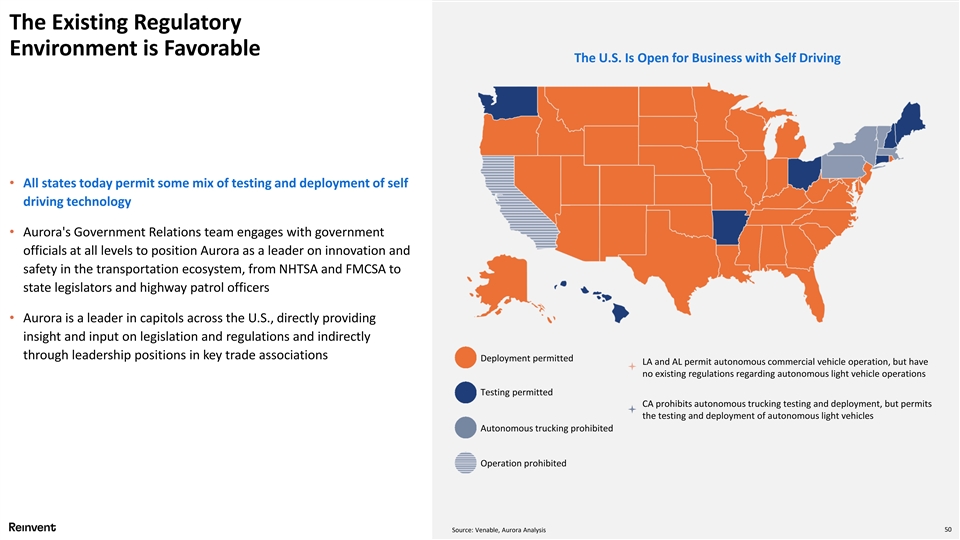
The Existing Regulatory Environment is Favorable The U.S. Is Open for Business with Self Driving • All states today permit some mix of testing and deployment of self driving technology • Aurora's Government Relations team engages with government officials at all levels to position Aurora as a leader on innovation and safety in the transportation ecosystem, from NHTSA and FMCSA to state legislators and highway patrol officers • Aurora is a leader in capitols across the U.S., directly providing insight and input on legislation and regulations and indirectly through leadership positions in key trade associations Deployment permitted LA and AL permit autonomous commercial vehicle operation, but have no existing regulations regarding autonomous light vehicle operations Testing permitted CA prohibits autonomous trucking testing and deployment, but permits the testing and deployment of autonomous light vehicles Autonomous trucking prohibited Operation prohibited Source: Venable, Aurora Analysis 50The Existing Regulatory Environment is Favorable The U.S. Is Open for Business with Self Driving • All states today permit some mix of testing and deployment of self driving technology • Aurora's Government Relations team engages with government officials at all levels to position Aurora as a leader on innovation and safety in the transportation ecosystem, from NHTSA and FMCSA to state legislators and highway patrol officers • Aurora is a leader in capitols across the U.S., directly providing insight and input on legislation and regulations and indirectly through leadership positions in key trade associations Deployment permitted LA and AL permit autonomous commercial vehicle operation, but have no existing regulations regarding autonomous light vehicle operations Testing permitted CA prohibits autonomous trucking testing and deployment, but permits the testing and deployment of autonomous light vehicles Autonomous trucking prohibited Operation prohibited Source: Venable, Aurora Analysis 50
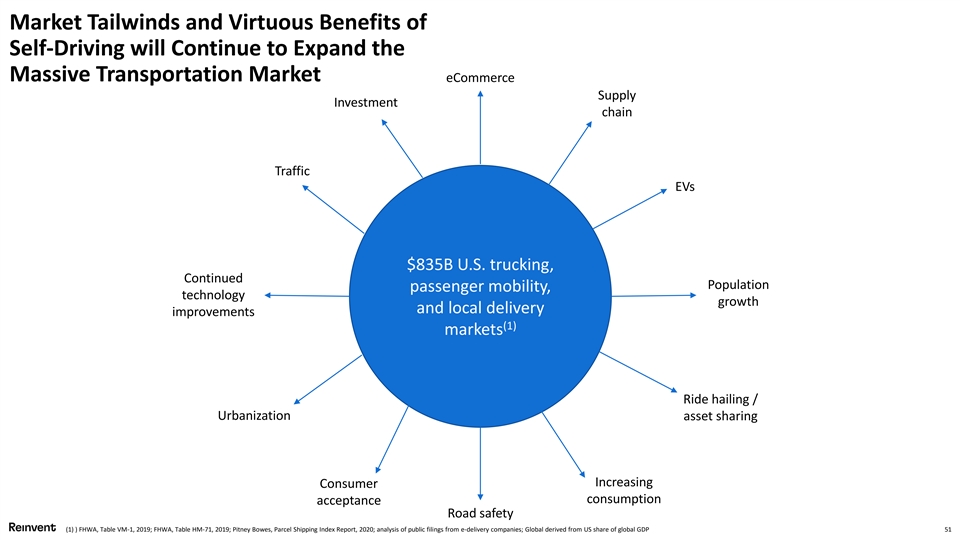
Market Tailwinds and Virtuous Benefits of Self-Driving will Continue to Expand the Massive Transportation Market eCommerce Supply Investment chain Traffic EVs $835B U.S. trucking, Continued Population passenger mobility, technology growth and local delivery improvements (1) markets Ride hailing / Urbanization asset sharing Increasing Consumer consumption acceptance Road safety (1) ) FHWA, Table VM-1, 2019; FHWA, Table HM-71, 2019; Pitney Bowes, Parcel Shipping Index Report, 2020; analysis of public filings from e-delivery companies; Global derived from US share of global GDP 51Market Tailwinds and Virtuous Benefits of Self-Driving will Continue to Expand the Massive Transportation Market eCommerce Supply Investment chain Traffic EVs $835B U.S. trucking, Continued Population passenger mobility, technology growth and local delivery improvements (1) markets Ride hailing / Urbanization asset sharing Increasing Consumer consumption acceptance Road safety (1) ) FHWA, Table VM-1, 2019; FHWA, Table HM-71, 2019; Pitney Bowes, Parcel Shipping Index Report, 2020; analysis of public filings from e-delivery companies; Global derived from US share of global GDP 51
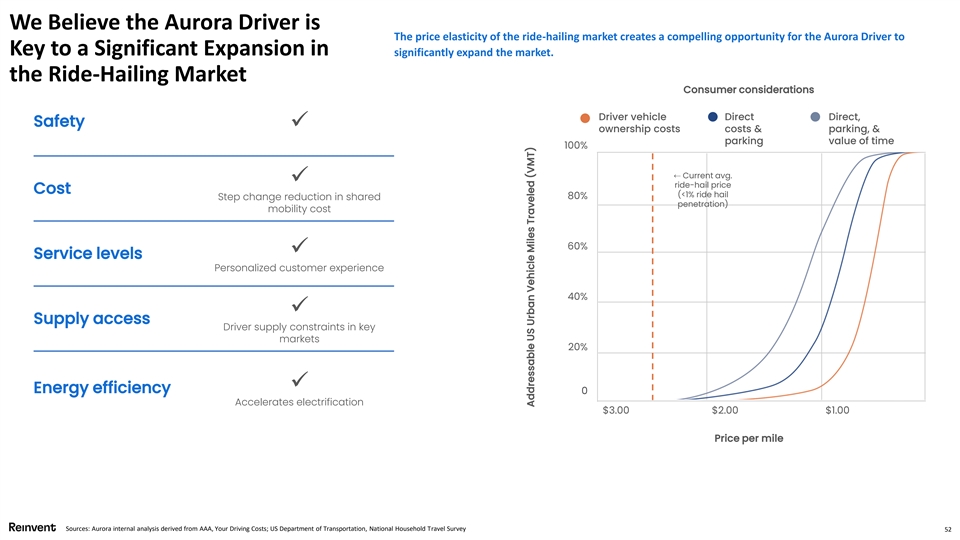
We Believe the Aurora Driver is The price elasticity of the ride-hailing market creates a compelling opportunity for the Aurora Driver to Key to a Significant Expansion in significantly expand the market. the Ride-Hailing Market Consumer considerations Driver vehicle Direct Direct, Safety ✓ ownership costs costs & parking, & parking value of time 100% ⇠ Current avg. ✓ ride-hail price Cost (<1% ride hail 80% Step change reduction in shared penetration) mobility cost 60% ✓ Service levels Personalized customer experience 40% ✓ Supply access Driver supply constraints in key markets 20% ✓ Energy efficiency 0 Accelerates electrification $3.00 $2.00 $1.00 Price per mile Sources: Aurora internal analysis derived from AAA, Your Driving Costs; US Department of Transportation, National Household Travel Survey 52 Addressable US Urban Vehicle Miles Traveled (VMT)We Believe the Aurora Driver is The price elasticity of the ride-hailing market creates a compelling opportunity for the Aurora Driver to Key to a Significant Expansion in significantly expand the market. the Ride-Hailing Market Consumer considerations Driver vehicle Direct Direct, Safety ✓ ownership costs costs & parking, & parking value of time 100% ⇠ Current avg. ✓ ride-hail price Cost (<1% ride hail 80% Step change reduction in shared penetration) mobility cost 60% ✓ Service levels Personalized customer experience 40% ✓ Supply access Driver supply constraints in key markets 20% ✓ Energy efficiency 0 Accelerates electrification $3.00 $2.00 $1.00 Price per mile Sources: Aurora internal analysis derived from AAA, Your Driving Costs; US Department of Transportation, National Household Travel Survey 52 Addressable US Urban Vehicle Miles Traveled (VMT)
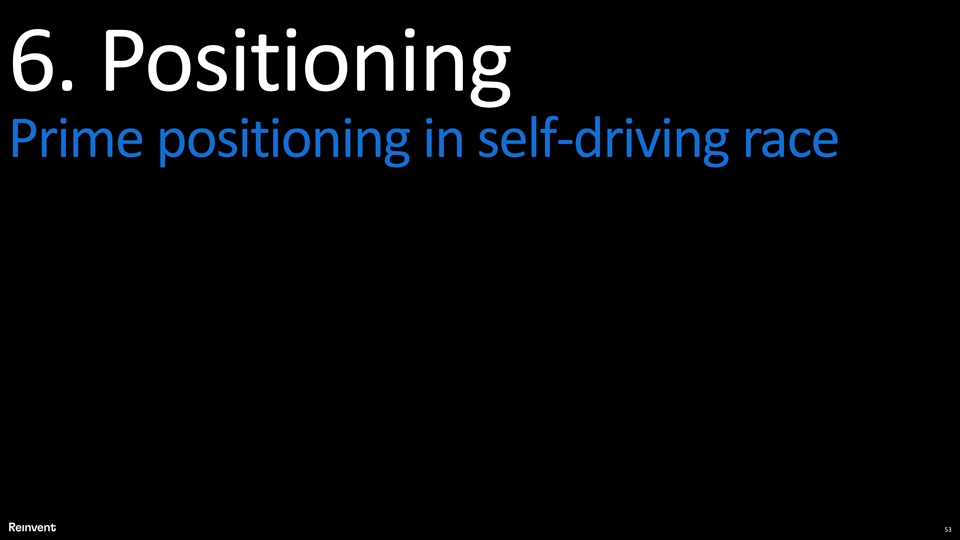
6. Positioning Prime positioning in self-driving race 536. Positioning Prime positioning in self-driving race 53
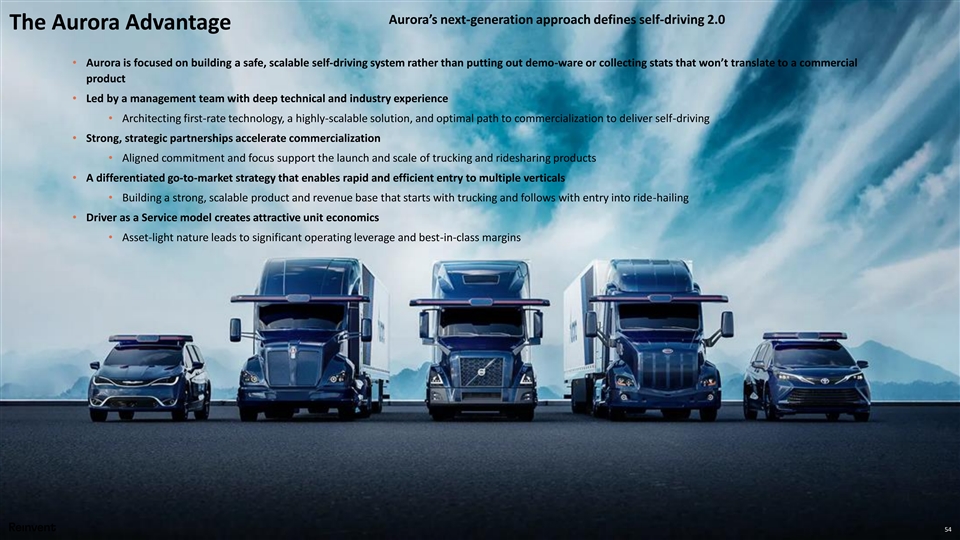
Aurora’s next-generation approach defines self-driving 2.0 The Aurora Advantage • Aurora is focused on building a safe, scalable self-driving system rather than putting out demo-ware or collecting stats that won’t translate to a commercial product • Led by a management team with deep technical and industry experience • Architecting first-rate technology, a highly-scalable solution, and optimal path to commercialization to deliver self-driving • Strong, strategic partnerships accelerate commercialization • Aligned commitment and focus support the launch and scale of trucking and ridesharing products • A differentiated go-to-market strategy that enables rapid and efficient entry to multiple verticals • Building a strong, scalable product and revenue base that starts with trucking and follows with entry into ride-hailing • Driver as a Service model creates attractive unit economics • Asset-light nature leads to significant operating leverage and best-in-class margins 54Aurora’s next-generation approach defines self-driving 2.0 The Aurora Advantage • Aurora is focused on building a safe, scalable self-driving system rather than putting out demo-ware or collecting stats that won’t translate to a commercial product • Led by a management team with deep technical and industry experience • Architecting first-rate technology, a highly-scalable solution, and optimal path to commercialization to deliver self-driving • Strong, strategic partnerships accelerate commercialization • Aligned commitment and focus support the launch and scale of trucking and ridesharing products • A differentiated go-to-market strategy that enables rapid and efficient entry to multiple verticals • Building a strong, scalable product and revenue base that starts with trucking and follows with entry into ride-hailing • Driver as a Service model creates attractive unit economics • Asset-light nature leads to significant operating leverage and best-in-class margins 54
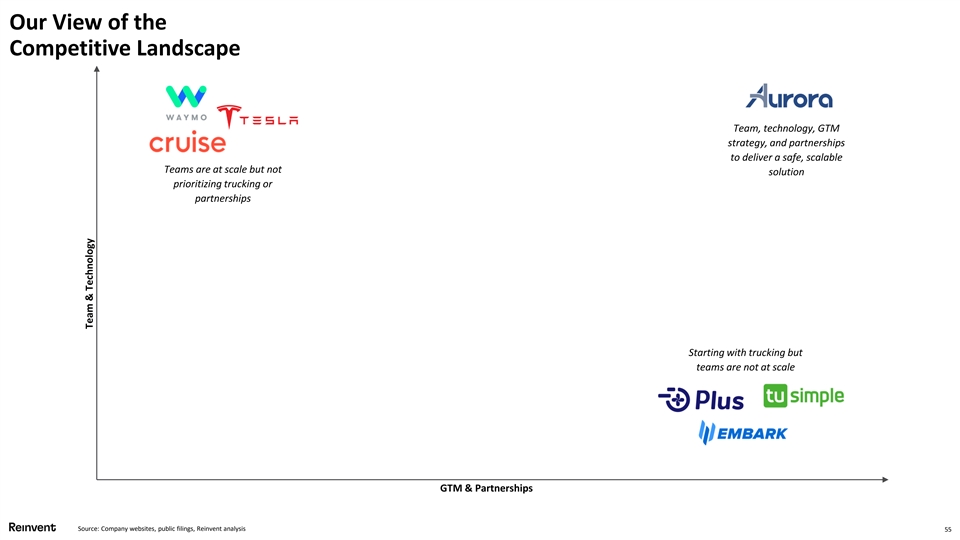
Our View of the Competitive Landscape Team, technology, GTM strategy, and partnerships to deliver a safe, scalable Teams are at scale but not solution prioritizing trucking or partnerships Starting with trucking but teams are not at scale GTM & Partnerships Source: Company websites, public filings, Reinvent analysis 55 Team & Technology
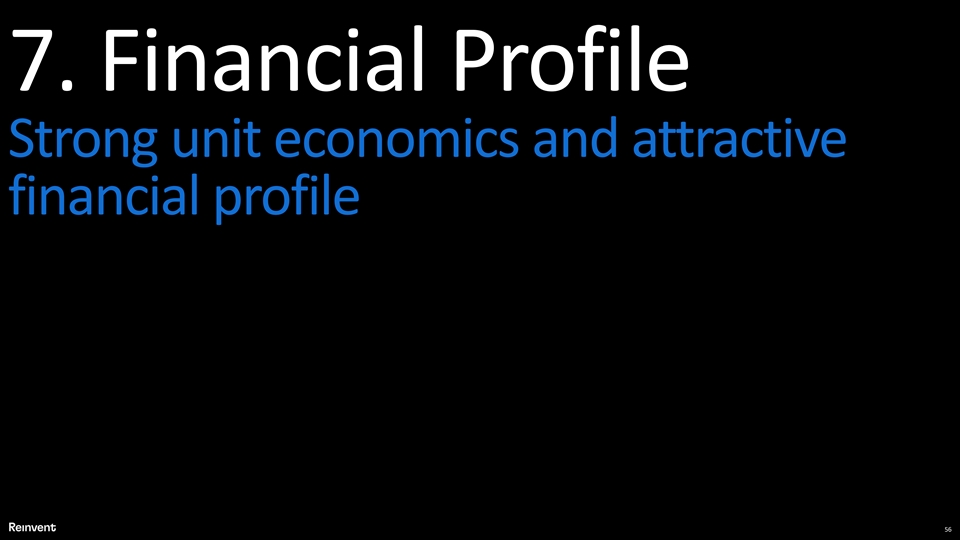
7. Financial Profile Strong unit economics and attractive financial profile 567. Financial Profile Strong unit economics and attractive financial profile 56
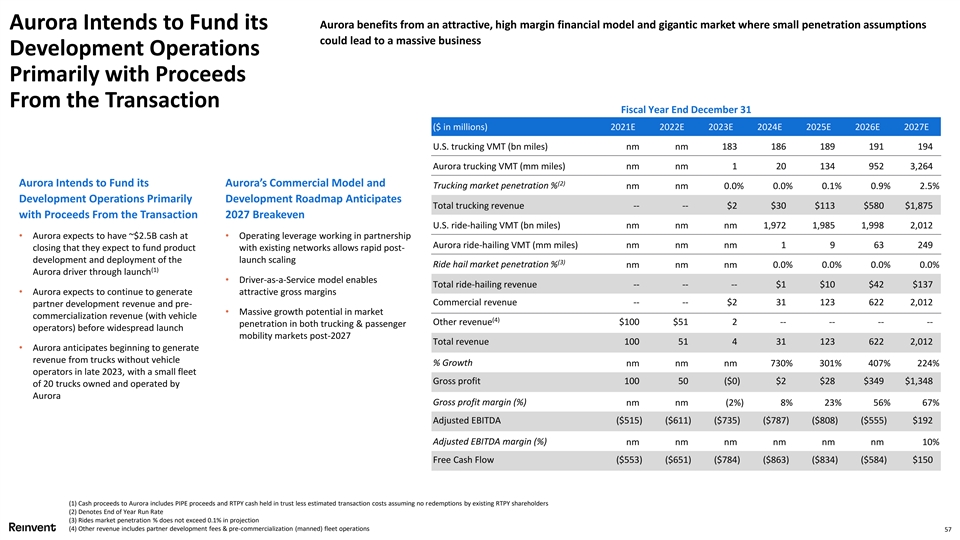
Aurora benefits from an attractive, high margin financial model and gigantic market where small penetration assumptions Aurora Intends to Fund its could lead to a massive business Development Operations Primarily with Proceeds From the Transaction Fiscal Year End December 31 ($ in millions) 2021E 2022E 2023E 2024E 2025E 2026E 2027E U.S. trucking VMT (bn miles) nm nm 183 186 189 191 194 Aurora trucking VMT (mm miles) nm nm 1 20 134 952 3,264 (2) Aurora Intends to Fund its Aurora’s Commercial Model and Trucking market penetration % nm nm 0.0% 0.0% 0.1% 0.9% 2.5% Development Operations Primarily Development Roadmap Anticipates Total trucking revenue -- -- $2 $30 $113 $580 $1,875 with Proceeds From the Transaction 2027 Breakeven U.S. ride-hailing VMT (bn miles) nm nm nm 1,972 1,985 1,998 2,012 • Aurora expects to have ~$2.5B cash at • Operating leverage working in partnership Aurora ride-hailing VMT (mm miles) nm nm nm 1 9 63 249 closing that they expect to fund product with existing networks allows rapid post- development and deployment of the launch scaling (3) Ride hail market penetration % nm nm nm 0.0% 0.0% 0.0% 0.0% (1) Aurora driver through launch • Driver-as-a-Service model enables Total ride-hailing revenue -- -- -- $1 $10 $42 $137 • Aurora expects to continue to generate attractive gross margins Commercial revenue -- -- $2 31 123 622 2,012 partner development revenue and pre- • Massive growth potential in market commercialization revenue (with vehicle (4) Other revenue $100 $51 2 -- -- -- -- penetration in both trucking & passenger operators) before widespread launch mobility markets post-2027 Total revenue 100 51 4 31 123 622 2,012 • Aurora anticipates beginning to generate revenue from trucks without vehicle % Growth nm nm nm 730% 301% 407% 224% operators in late 2023, with a small fleet Gross profit 100 50 ($0) $2 $28 $349 $1,348 of 20 trucks owned and operated by Aurora Gross profit margin (%) nm nm (2%) 8% 23% 56% 67% Adjusted EBITDA ($515) ($611) ($735) ($787) ($808) ($555) $192 Adjusted EBITDA margin (%) nm nm nm nm nm nm 10% Free Cash Flow ($553) ($651) ($784) ($863) ($834) ($584) $150 (1) Cash proceeds to Aurora includes PIPE proceeds and RTPY cash held in trust less estimated transaction costs assuming no redemptions by existing RTPY shareholders (2) Denotes End of Year Run Rate (3) Rides market penetration % does not exceed 0.1% in projection (4) Other revenue includes partner development fees & pre-commercialization (manned) fleet operations 57Aurora benefits from an attractive, high margin financial model and gigantic market where small penetration assumptions Aurora Intends to Fund its could lead to a massive business Development Operations Primarily with Proceeds From the Transaction Fiscal Year End December 31 ($ in millions) 2021E 2022E 2023E 2024E 2025E 2026E 2027E U.S. trucking VMT (bn miles) nm nm 183 186 189 191 194 Aurora trucking VMT (mm miles) nm nm 1 20 134 952 3,264 (2) Aurora Intends to Fund its Aurora’s Commercial Model and Trucking market penetration % nm nm 0.0% 0.0% 0.1% 0.9% 2.5% Development Operations Primarily Development Roadmap Anticipates Total trucking revenue -- -- $2 $30 $113 $580 $1,875 with Proceeds From the Transaction 2027 Breakeven U.S. ride-hailing VMT (bn miles) nm nm nm 1,972 1,985 1,998 2,012 • Aurora expects to have ~$2.5B cash at • Operating leverage working in partnership Aurora ride-hailing VMT (mm miles) nm nm nm 1 9 63 249 closing that they expect to fund product with existing networks allows rapid post- development and deployment of the launch scaling (3) Ride hail market penetration % nm nm nm 0.0% 0.0% 0.0% 0.0% (1) Aurora driver through launch • Driver-as-a-Service model enables Total ride-hailing revenue -- -- -- $1 $10 $42 $137 • Aurora expects to continue to generate attractive gross margins Commercial revenue -- -- $2 31 123 622 2,012 partner development revenue and pre- • Massive growth potential in market commercialization revenue (with vehicle (4) Other revenue $100 $51 2 -- -- -- -- penetration in both trucking & passenger operators) before widespread launch mobility markets post-2027 Total revenue 100 51 4 31 123 622 2,012 • Aurora anticipates beginning to generate revenue from trucks without vehicle % Growth nm nm nm 730% 301% 407% 224% operators in late 2023, with a small fleet Gross profit 100 50 ($0) $2 $28 $349 $1,348 of 20 trucks owned and operated by Aurora Gross profit margin (%) nm nm (2%) 8% 23% 56% 67% Adjusted EBITDA ($515) ($611) ($735) ($787) ($808) ($555) $192 Adjusted EBITDA margin (%) nm nm nm nm nm nm 10% Free Cash Flow ($553) ($651) ($784) ($863) ($834) ($584) $150 (1) Cash proceeds to Aurora includes PIPE proceeds and RTPY cash held in trust less estimated transaction costs assuming no redemptions by existing RTPY shareholders (2) Denotes End of Year Run Rate (3) Rides market penetration % does not exceed 0.1% in projection (4) Other revenue includes partner development fees & pre-commercialization (manned) fleet operations 57
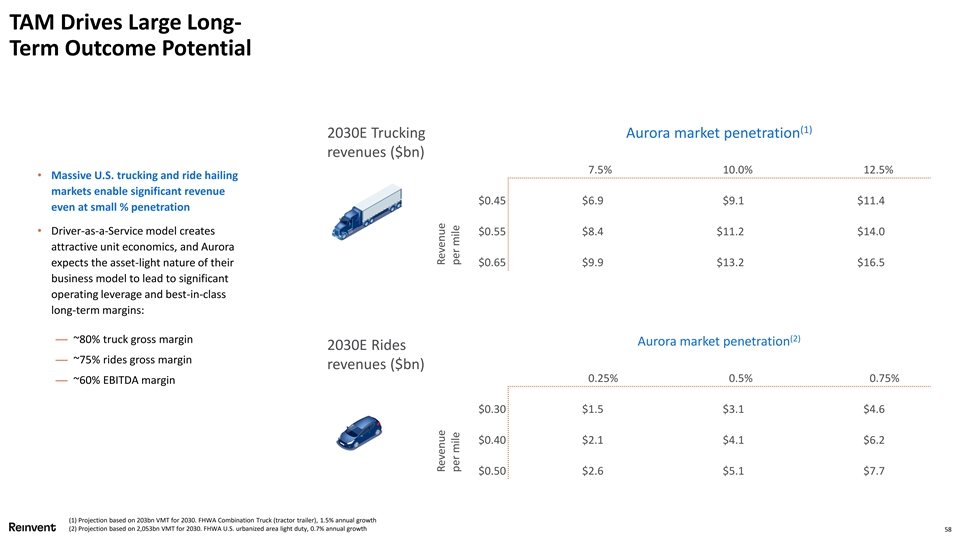
TAM Drives Large Long- Term Outcome Potential (1) 2030E Trucking Aurora market penetration revenues ($bn) 7.5% 10.0% 12.5% • Massive U.S. trucking and ride hailing markets enable significant revenue $0.45 $6.9 $9.1 $11.4 even at small % penetration • Driver-as-a-Service model creates $0.55 $8.4 $11.2 $14.0 attractive unit economics, and Aurora expects the asset-light nature of their $0.65 $9.9 $13.2 $16.5 business model to lead to significant operating leverage and best-in-class long-term margins: (2) — ~80% truck gross margin Aurora market penetration 2030E Rides — ~75% rides gross margin revenues ($bn) 0.25% 0.5% 0.75% — ~60% EBITDA margin $0.30 $1.5 $3.1 $4.6 $0.40 $2.1 $4.1 $6.2 $0.50 $2.6 $5.1 $7.7 (1) Projection based on 203bn VMT for 2030. FHWA Combination Truck (tractor trailer), 1.5% annual growth (2) Projection based on 2,053bn VMT for 2030. FHWA U.S. urbanized area light duty, 0.7% annual growth 58 Revenue Revenue per mile per mileTAM Drives Large Long- Term Outcome Potential (1) 2030E Trucking Aurora market penetration revenues ($bn) 7.5% 10.0% 12.5% • Massive U.S. trucking and ride hailing markets enable significant revenue $0.45 $6.9 $9.1 $11.4 even at small % penetration • Driver-as-a-Service model creates $0.55 $8.4 $11.2 $14.0 attractive unit economics, and Aurora expects the asset-light nature of their $0.65 $9.9 $13.2 $16.5 business model to lead to significant operating leverage and best-in-class long-term margins: (2) — ~80% truck gross margin Aurora market penetration 2030E Rides — ~75% rides gross margin revenues ($bn) 0.25% 0.5% 0.75% — ~60% EBITDA margin $0.30 $1.5 $3.1 $4.6 $0.40 $2.1 $4.1 $6.2 $0.50 $2.6 $5.1 $7.7 (1) Projection based on 203bn VMT for 2030. FHWA Combination Truck (tractor trailer), 1.5% annual growth (2) Projection based on 2,053bn VMT for 2030. FHWA U.S. urbanized area light duty, 0.7% annual growth 58 Revenue Revenue per mile per mile
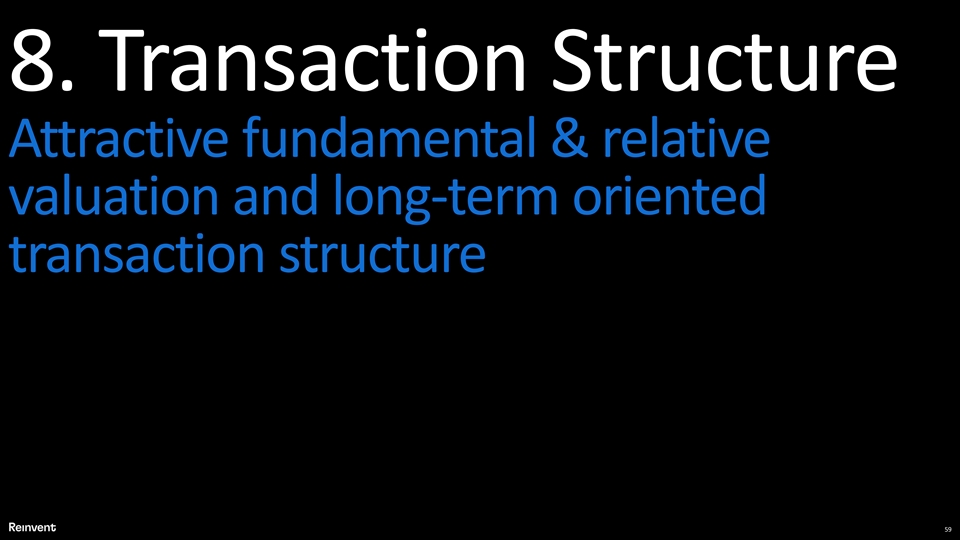
8. Transaction Structure Attractive fundamental & relative valuation and long-term oriented transaction structure 598. Transaction Structure Attractive fundamental & relative valuation and long-term oriented transaction structure 59
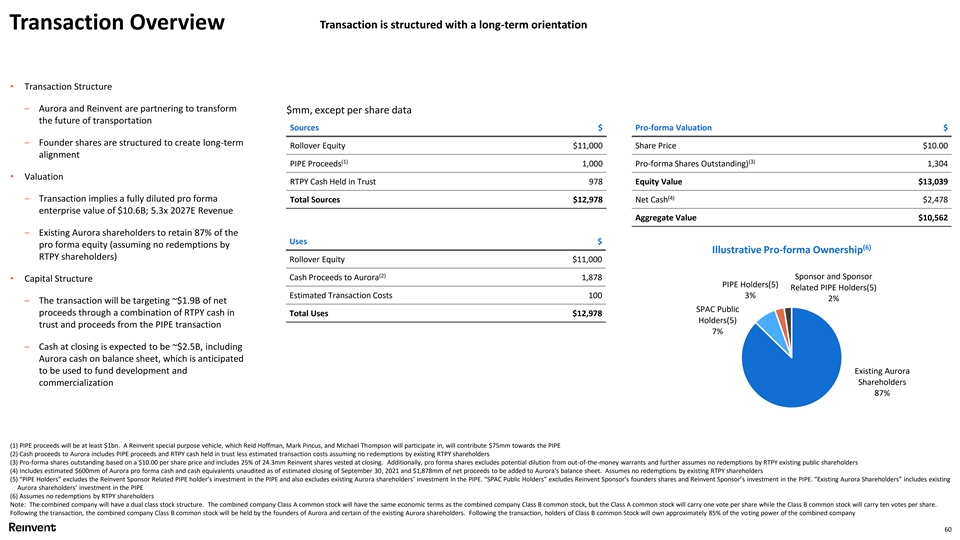
Transaction is structured with a long-term orientation Transaction Overview • Transaction Structure ‒ Aurora and Reinvent are partnering to transform $mm, except per share data the future of transportation Sources $ Pro-forma Valuation $ ‒ Founder shares are structured to create long-term Rollover Equity $11,000 Share Price $10.00 alignment (1) (3) PIPE Proceeds 1,000 Pro-forma Shares Outstanding) 1,304 • Valuation RTPY Cash Held in Trust 978 Equity Value $13,039 (4) ‒ Transaction implies a fully diluted pro forma Total Sources $12,978 Net Cash $2,478 enterprise value of $10.6B; 5.3x 2027E Revenue Aggregate Value $10,562 ‒ Existing Aurora shareholders to retain 87% of the Uses $ pro forma equity (assuming no redemptions by (6) Illustrative Pro-forma Ownership RTPY shareholders) Rollover Equity $11,000 (2) Sponsor and Sponsor Cash Proceeds to Aurora 1,878 • Capital Structure PIPE Holders(5) Related PIPE Holders(5) Estimated Transaction Costs 100 3% 2% ‒ The transaction will be targeting ~$1.9B of net SPAC Public proceeds through a combination of RTPY cash in Total Uses $12,978 Holders(5) trust and proceeds from the PIPE transaction 7% ‒ Cash at closing is expected to be ~$2.5B, including Aurora cash on balance sheet, which is anticipated to be used to fund development and Existing Aurora Shareholders commercialization 87% (1) PIPE proceeds will be at least $1bn. A Reinvent special purpose vehicle, which Reid Hoffman, Mark Pincus, and Michael Thompson will participate in, will contribute $75mm towards the PIPE (2) Cash proceeds to Aurora includes PIPE proceeds and RTPY cash held in trust less estimated transaction costs assuming no redemptions by existing RTPY shareholders (3) Pro-forma shares outstanding based on a $10.00 per share price and includes 25% of 24.3mm Reinvent shares vested at closing. Additionally, pro forma shares excludes potential dilution from out-of-the-money warrants and further assumes no redemptions by RTPY existing public shareholders (4) Includes estimated $600mm of Aurora pro forma cash and cash equivalents unaudited as of estimated closing of September 30, 2021 and $1,878mm of net proceeds to be added to Aurora's balance sheet. Assumes no redemptions by existing RTPY shareholders (5) “PIPE Holders” excludes the Reinvent Sponsor Related PIPE holder’s investment in the PIPE and also excludes existing Aurora shareholders’ investment in the PIPE. “SPAC Public Holders” excludes Reinvent Sponsor’s founders shares and Reinvent Sponsor’s investment in the PIPE. “Existing Aurora Shareholders” includes existing Aurora shareholders’ investment in the PIPE (6) Assumes no redemptions by RTPY shareholders Note: The combined company will have a dual class stock structure. The combined company Class A common stock will have the same economic terms as the combined company Class B common stock, but the Class A common stock will carry one vote per share while the Class B common stock will carry ten votes per share. Following the transaction, the combined company Class B common stock will be held by the founders of Aurora and certain of the existing Aurora shareholders. Following the transaction, holders of Class B common Stock will own approximately 85% of the voting power of the combined company 60Transaction is structured with a long-term orientation Transaction Overview • Transaction Structure ‒ Aurora and Reinvent are partnering to transform $mm, except per share data the future of transportation Sources $ Pro-forma Valuation $ ‒ Founder shares are structured to create long-term Rollover Equity $11,000 Share Price $10.00 alignment (1) (3) PIPE Proceeds 1,000 Pro-forma Shares Outstanding) 1,304 • Valuation RTPY Cash Held in Trust 978 Equity Value $13,039 (4) ‒ Transaction implies a fully diluted pro forma Total Sources $12,978 Net Cash $2,478 enterprise value of $10.6B; 5.3x 2027E Revenue Aggregate Value $10,562 ‒ Existing Aurora shareholders to retain 87% of the Uses $ pro forma equity (assuming no redemptions by (6) Illustrative Pro-forma Ownership RTPY shareholders) Rollover Equity $11,000 (2) Sponsor and Sponsor Cash Proceeds to Aurora 1,878 • Capital Structure PIPE Holders(5) Related PIPE Holders(5) Estimated Transaction Costs 100 3% 2% ‒ The transaction will be targeting ~$1.9B of net SPAC Public proceeds through a combination of RTPY cash in Total Uses $12,978 Holders(5) trust and proceeds from the PIPE transaction 7% ‒ Cash at closing is expected to be ~$2.5B, including Aurora cash on balance sheet, which is anticipated to be used to fund development and Existing Aurora Shareholders commercialization 87% (1) PIPE proceeds will be at least $1bn. A Reinvent special purpose vehicle, which Reid Hoffman, Mark Pincus, and Michael Thompson will participate in, will contribute $75mm towards the PIPE (2) Cash proceeds to Aurora includes PIPE proceeds and RTPY cash held in trust less estimated transaction costs assuming no redemptions by existing RTPY shareholders (3) Pro-forma shares outstanding based on a $10.00 per share price and includes 25% of 24.3mm Reinvent shares vested at closing. Additionally, pro forma shares excludes potential dilution from out-of-the-money warrants and further assumes no redemptions by RTPY existing public shareholders (4) Includes estimated $600mm of Aurora pro forma cash and cash equivalents unaudited as of estimated closing of September 30, 2021 and $1,878mm of net proceeds to be added to Aurora's balance sheet. Assumes no redemptions by existing RTPY shareholders (5) “PIPE Holders” excludes the Reinvent Sponsor Related PIPE holder’s investment in the PIPE and also excludes existing Aurora shareholders’ investment in the PIPE. “SPAC Public Holders” excludes Reinvent Sponsor’s founders shares and Reinvent Sponsor’s investment in the PIPE. “Existing Aurora Shareholders” includes existing Aurora shareholders’ investment in the PIPE (6) Assumes no redemptions by RTPY shareholders Note: The combined company will have a dual class stock structure. The combined company Class A common stock will have the same economic terms as the combined company Class B common stock, but the Class A common stock will carry one vote per share while the Class B common stock will carry ten votes per share. Following the transaction, the combined company Class B common stock will be held by the founders of Aurora and certain of the existing Aurora shareholders. Following the transaction, holders of Class B common Stock will own approximately 85% of the voting power of the combined company 60
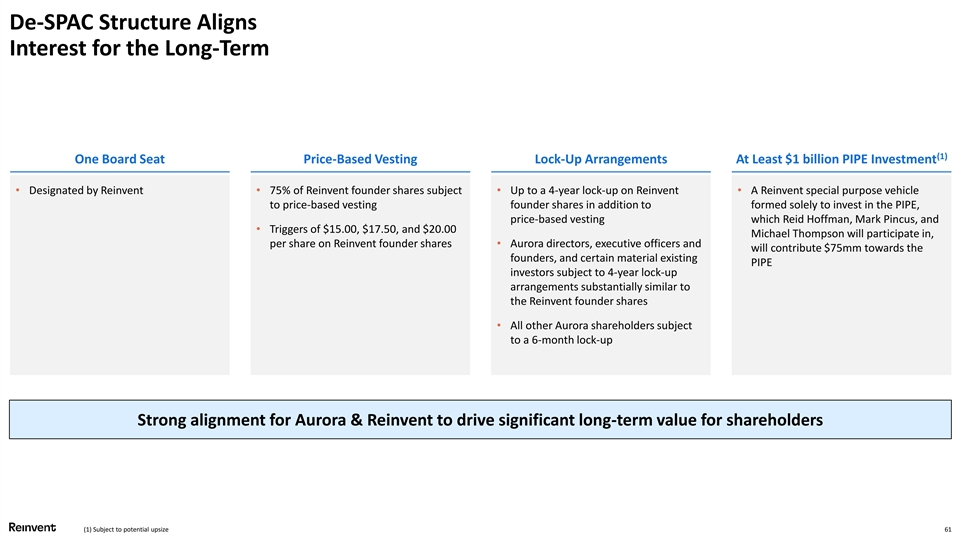
De-SPAC Structure Aligns Interest for the Long-Term (1) One Board Seat Price-Based Vesting Lock-Up Arrangements At Least $1 billion PIPE Investment • Designated by Reinvent• 75% of Reinvent founder shares subject • Up to a 4-year lock-up on Reinvent • A Reinvent special purpose vehicle to price-based vesting founder shares in addition to formed solely to invest in the PIPE, price-based vesting which Reid Hoffman, Mark Pincus, and • Triggers of $15.00, $17.50, and $20.00 Michael Thompson will participate in, per share on Reinvent founder shares• Aurora directors, executive officers and will contribute $75mm towards the founders, and certain material existing PIPE investors subject to 4-year lock-up arrangements substantially similar to the Reinvent founder shares • All other Aurora shareholders subject to a 6-month lock-up Strong alignment for Aurora & Reinvent to drive significant long-term value for shareholders (1) Subject to potential upsize 61De-SPAC Structure Aligns Interest for the Long-Term (1) One Board Seat Price-Based Vesting Lock-Up Arrangements At Least $1 billion PIPE Investment • Designated by Reinvent• 75% of Reinvent founder shares subject • Up to a 4-year lock-up on Reinvent • A Reinvent special purpose vehicle to price-based vesting founder shares in addition to formed solely to invest in the PIPE, price-based vesting which Reid Hoffman, Mark Pincus, and • Triggers of $15.00, $17.50, and $20.00 Michael Thompson will participate in, per share on Reinvent founder shares• Aurora directors, executive officers and will contribute $75mm towards the founders, and certain material existing PIPE investors subject to 4-year lock-up arrangements substantially similar to the Reinvent founder shares • All other Aurora shareholders subject to a 6-month lock-up Strong alignment for Aurora & Reinvent to drive significant long-term value for shareholders (1) Subject to potential upsize 61
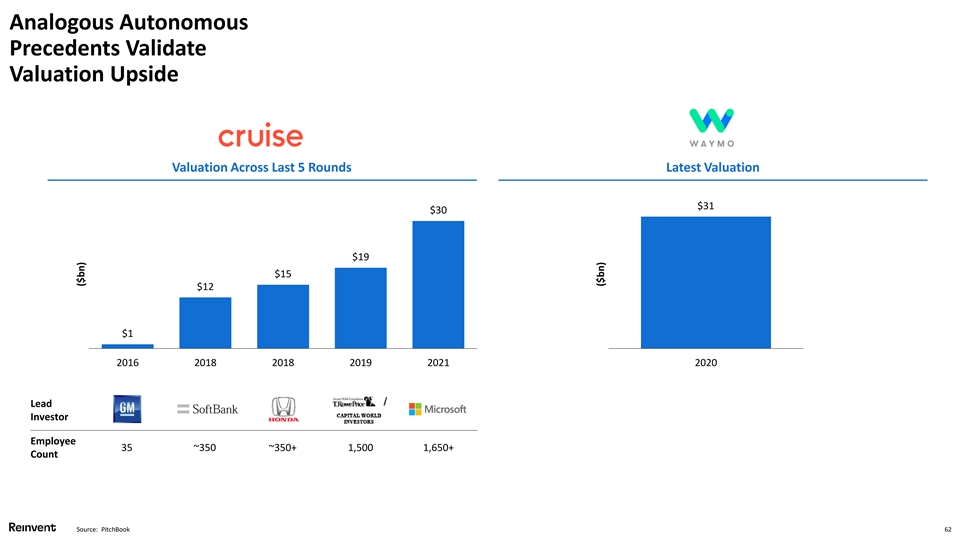
Analogous Autonomous Precedents Validate Valuation Upside Valuation Across Last 5 Rounds Latest Valuation $31 $30 $19 $15 $12 $1 2016 2018 2018 2019 2021 2020 Lead Investor Employee 35 ~350 ~350+ 1,500 1,650+ Count Source: PitchBook 62 ($bn) ($bn)
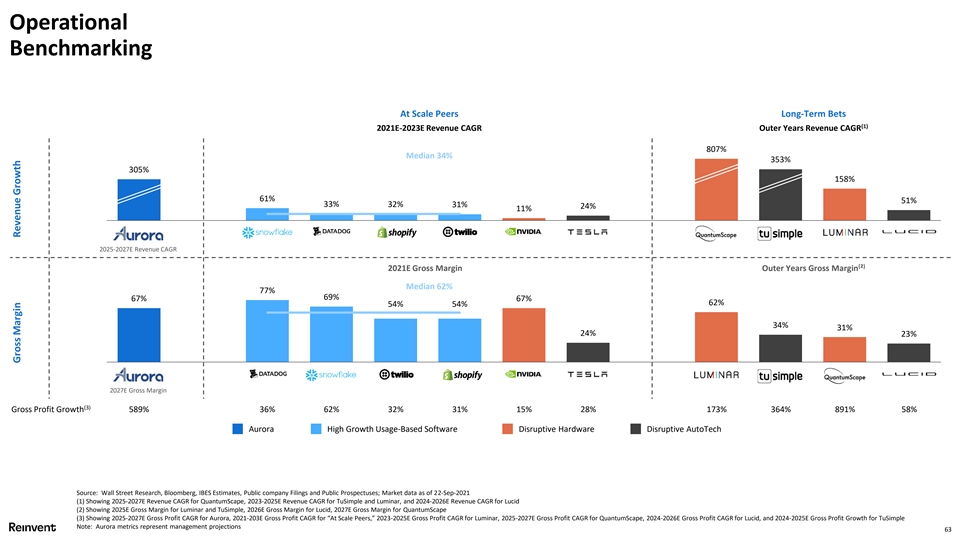
Operational Benchmarking At Scale Peers Long-Term Bets (1) 2021E-2023E Revenue CAGR Outer Years Revenue CAGR 807% Median 34% 353% 305% 158% 61% 51% 33% 32% 31% 24% 11% 2025-2027E Revenue CAGR ( ) 2021E Gross Margin Outer Years Gross Margin ² Median 62% 77% 69% 67% 67% 62% 54% 54% 34% 31% 24% 23% 2027E Gross Margin (3) Gross Profit Growth 589% 36% 62% 32% 31% 15% 28% 173% 364% 891% 58% Aurora High Growth Usage-Based Software Disruptive Hardware Disruptive AutoTech Source: Wall Street Research, Bloomberg, IBES Estimates, Public company Filings and Public Prospectuses; Market data as of 22-Sep-2021 (1) Showing 2025-2027E Revenue CAGR for QuantumScape, 2023-2025E Revenue CAGR for TuSimple and Luminar, and 2024-2026E Revenue CAGR for Lucid (2) Showing 2025E Gross Margin for Luminar and TuSimple, 2026E Gross Margin for Lucid, 2027E Gross Margin for QuantumScape (3) Showing 2025-2027E Gross Profit CAGR for Aurora, 2021-203E Gross Profit CAGR for “At Scale Peers,” 2023-2025E Gross Profit CAGR for Luminar, 2025-2027E Gross Profit CAGR for QuantumScape, 2024-2026E Gross Profit CAGR for Lucid, and 2024-2025E Gross Profit Growth for TuSimple Note: Aurora metrics represent management projections 63 Gross Margin Revenue Growth Operational Benchmarking At Scale Peers Long-Term Bets (1) 2021E-2023E Revenue CAGR Outer Years Revenue CAGR 807% Median 34% 353% 305% 158% 61% 51% 33% 32% 31% 24% 11% 2025-2027E Revenue CAGR ( ) 2021E Gross Margin Outer Years Gross Margin ² Median 62% 77% 69% 67% 67% 62% 54% 54% 34% 31% 24% 23% 2027E Gross Margin (3) Gross Profit Growth 589% 36% 62% 32% 31% 15% 28% 173% 364% 891% 58% Aurora High Growth Usage-Based Software Disruptive Hardware Disruptive AutoTech Source: Wall Street Research, Bloomberg, IBES Estimates, Public company Filings and Public Prospectuses; Market data as of 22-Sep-2021 (1) Showing 2025-2027E Revenue CAGR for QuantumScape, 2023-2025E Revenue CAGR for TuSimple and Luminar, and 2024-2026E Revenue CAGR for Lucid (2) Showing 2025E Gross Margin for Luminar and TuSimple, 2026E Gross Margin for Lucid, 2027E Gross Margin for QuantumScape (3) Showing 2025-2027E Gross Profit CAGR for Aurora, 2021-203E Gross Profit CAGR for “At Scale Peers,” 2023-2025E Gross Profit CAGR for Luminar, 2025-2027E Gross Profit CAGR for QuantumScape, 2024-2026E Gross Profit CAGR for Lucid, and 2024-2025E Gross Profit Growth for TuSimple Note: Aurora metrics represent management projections 63 Gross Margin Revenue Growth
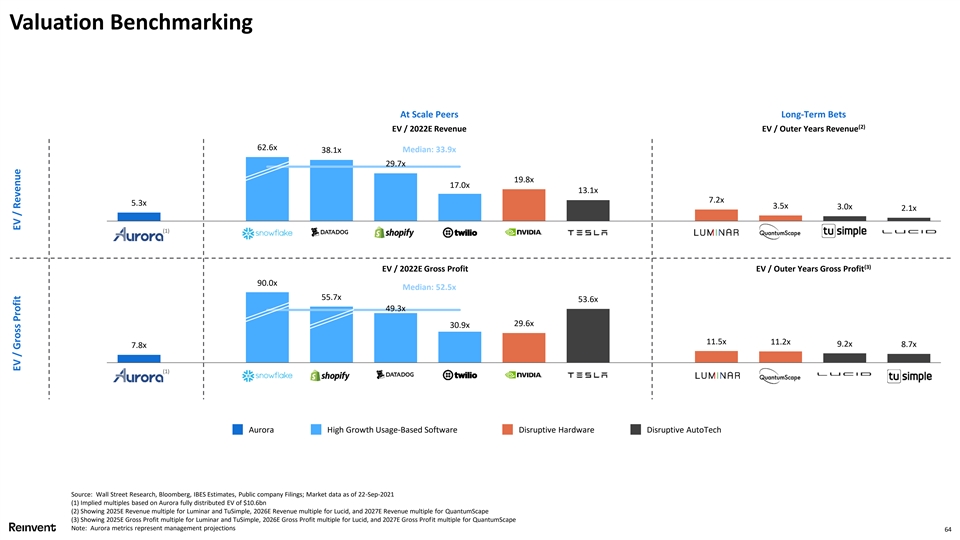
Valuation Benchmarking At Scale Peers Long-Term Bets (2) EV / 2022E Revenue EV / Outer Years Revenue 62.6x Median: 33.9x 38.1x 29.7x 19.8x 17.0x 13.1x 7.2x 5.3x 3.5x 3.0x 2.1x (1) (3) EV / 2022E Gross Profit EV / Outer Years Gross Profit 90.0x Median: 52.5x 55.7x 53.6x 49.3x 29.6x 30.9x 11.5x 11.2x 9.2x 8.7x 7.8x (1) Aurora High Growth Usage-Based Software Disruptive Hardware Disruptive AutoTech Source: Wall Street Research, Bloomberg, IBES Estimates, Public company Filings; Market data as of 22-Sep-2021 (1) Implied multiples based on Aurora fully distributed EV of $10.6bn (2) Showing 2025E Revenue multiple for Luminar and TuSimple, 2026E Revenue multiple for Lucid, and 2027E Revenue multiple for QuantumScape (3) Showing 2025E Gross Profit multiple for Luminar and TuSimple, 2026E Gross Profit multiple for Lucid, and 2027E Gross Profit multiple for QuantumScape Note: Aurora metrics represent management projections 64 EV / Gross Profit EV / RevenueValuation Benchmarking At Scale Peers Long-Term Bets (2) EV / 2022E Revenue EV / Outer Years Revenue 62.6x Median: 33.9x 38.1x 29.7x 19.8x 17.0x 13.1x 7.2x 5.3x 3.5x 3.0x 2.1x (1) (3) EV / 2022E Gross Profit EV / Outer Years Gross Profit 90.0x Median: 52.5x 55.7x 53.6x 49.3x 29.6x 30.9x 11.5x 11.2x 9.2x 8.7x 7.8x (1) Aurora High Growth Usage-Based Software Disruptive Hardware Disruptive AutoTech Source: Wall Street Research, Bloomberg, IBES Estimates, Public company Filings; Market data as of 22-Sep-2021 (1) Implied multiples based on Aurora fully distributed EV of $10.6bn (2) Showing 2025E Revenue multiple for Luminar and TuSimple, 2026E Revenue multiple for Lucid, and 2027E Revenue multiple for QuantumScape (3) Showing 2025E Gross Profit multiple for Luminar and TuSimple, 2026E Gross Profit multiple for Lucid, and 2027E Gross Profit multiple for QuantumScape Note: Aurora metrics represent management projections 64 EV / Gross Profit EV / Revenue